We make money helping people book cruises, and from advertisers / affiliate partners. As an Amazon Associate, I earn from qualifying purchases.

Motion Sickness, Sea Legs And How to Stop Swaying After Getting Back From Your Cruise
If you just got back from your cruise vacation and are feeling unsteady on your feet, you may be wondering what's going on. Aren't so-called "sea legs" a good thing that helps you adapt to motion caused by unstable water? Well, after spending several days - or even weeks - traveling on the ocean, your body has adapted and now it needs to adapt to life back on land again. This is the quick answer to why people feel like they are still swaying ... even after the cruise is over.
How Many West Coast Cruises Have You Taken?
- Planning My First!
- Understanding 'Sea Legs' as an Adaptation : The term "sea legs" refers to the body's adaptation to the motion of being on a boat, allowing people to maintain balance and stability at sea, while the reverse process, readjusting to land, can cause a feeling of swaying after disembarking.
- Causes of Motion Sickness on Cruises : Motion sickness on cruises can arise from the constant movement of the ship, size discrepancies with the waves, and the visual disorientation caused by the movement of the horizon, which confuses the inner ear and eyes.
- Symptoms of Disembarkation Syndrome : After a cruise, passengers may experience symptoms like dizziness, nausea, and a persistent feeling of swaying due to their body's previous adaptation to ship motion, known as Mal de Débarquement Syndrome (MdDS).
- Coping with Post-Cruise Swaying : To alleviate the swaying sensation after a cruise, strategies include getting plenty of rest, staying hydrated, eating light meals, avoiding alcohol, and engaging in gentle exercises.
- Prevalence and Management of Sea Sickness : While less than 15% of cruisers typically experience motion sickness, the blog suggests consulting with a travel agent for optimal cabin placement and utilizing natural remedies and medications to manage symptoms effectively.
Article Index
Best for motion sickness:, worst for motion sickness:, get plenty of rest:, drink lots of fluids:, eat light meals:, avoid alcohol:, get fresh air:, do some light exercises:, avoid sudden movements:, symptoms of mdds include:, best and worst west coast cruises for people worried about motion sickness.
This is one of the most common questions that we get from clients who ask us to help them plan their cruise vacation. Unfortunately, there are too many variables ever to promise a completely calm cruise, but certainly, some cruises will be better than others. While no itinerary will also be 100% calm, and some people are more sensitive to the rocking of the ship caused by the ocean, some itineraries will be better than others if motion sickness on a cruise is a concern. For instance,
Inside Passage Alaska Cruise sailing out of Vancouver will feature protected waters for most of your voyage without significant amounts of exposure to ocean swells.
Repositioning cruises to Seattle or Vancouver that pass by the Oregon Coast have a bad reputation for experiencing rough waters regularly. Specifically, the area between San Francisco and Astoria, Oregon but also all the way up the coast until you sail through the Straight of Juan de Fuca and ultimately enter the calm waters of the Salish Sea.
The intensity of motion from the ocean can be more of a factor for some people than others, but if "sea legs" and motion sickness are a concern, you should be prepared. This is a real condition that can affect anyone after spending an extended period of time on a boat or ship. Symptoms include dizziness, motion sickness, and swaying, and sometimes, there is a rocking feeling that continues after being on a boat.
In this blog post, we will discuss some of the most common questions that our clients ask, including how to avoid motion sickness, how to get their sea legs, and how to stop swaying after a cruise! Are you ready? Let's begin.
How Calm Are Alaska Cruises vs. Caribbean?
Caribbean waters are among the consistently calm cruise areas found anywhere in the world. However, on the other hand, cruises to Alaska, Coastal California, and the Mexican Riviera can have some pretty significant ocean swells - though typically far from anything that would be generally uncomfortable for most guests. However, if you have taken a Caribbean cruise before and felt issues with sea legs, swaying after disembarkation or a general feeling of discomfort due to the motion then you should prepare accordingly and pack sea sickness remedies to help.
With that being said, as someone who has been on nearly two dozen cruises across both the Caribbean and Pacific Coastal itineraries, this chart is somewhat deceptive. The simple reason for this is that while most Caribbean itineraries take place close to islands that are protected from ocean swells - Pacific cruises - in particular those to Alaska - have EXTREMELY CALM waters once you get into the inside passage, even though the waters west of Vancouver Island can sometimes be rough. Similarly, I find that the seas are far more calm in the triangle area between Cabo, Puerto Vallarta, and Mazatlan compared to the seas off the coast of Baja.
Are You Ready For A Cruise?
Please fill out the form below and Heather from Flow Voyages (or a representative from CruiseWestCoast.com) will contact you as soon as possible.
For immediate help, please contact Heather directly: 630-779-9301 or : [email protected]
What Does, "I've Found My Sea Legs" Mean?
The phrase, "I've found my sea legs" is often used to describe the process of getting used to the motion of being on a boat. While not a guarantee that you will completely avoid suffering from motion sickness, it means that your body has begun to adapt to the environment. For some guests it can take a few hours or even a day or two for your body to adjust but for others they never will. Once you have adjusted, you should be able to walk around without feeling like the room is spinning.
The term first became common among sailors in the early 1700's as a term specifically referring to new mariners and conscripted sailors whose bodies acclimated to long boat trips and life at sea so that they were able to work on deck with a good sense of balance despite the motion of these naval vessels as they sailed across rough seas. Later the term became more broadly associated with other challenging tasks as a novice becomes comfortable with a complicated task.
While most people look at this merely as an adjustment to life at sea ... few people focus on the opposite, readjusting to life back on land. This is likely because these mariners were so glad to be back home that the phantom swaying sensation that they felt back on land was such a minor inconvenience that they didn't worry about it.
While life on a naval vessel is vastly different from a vacation on modern cruise ships, motion sickness from rough seas is a major concern for most new cruisers. Few of them consider the opposite concept, land sickness, much less refer to the process of finding their land legs again!
What Causes Motion Sickness On A Cruise?
Various things can cause motion sickness on a cruise, but the most common is simply being in unfamiliar surroundings. The human body is amazing at adapting to new situations, but it does take some time. In both seasickness as well landsickness, the sensation is caused by a condition in which the inner ear and eyes are sending conflicting messages to the brain. This is sometimes referred to as the vestibulo-ocular reflex and causes seasickness symptoms. Normally your brain and inner ear would be able operate in sync with each other but sometimes that just doesn't happen.
On a cruise ship, there are many potential sources of motion sickness:
- the constant motion of the ship or even the vibration from the ship's engine (even when it's not moving very fast)
- the size of the ship vs the motion of the waves (if you're in a rough sea, the ship will rock back and forth and smaller ships experience more profound motion compared to larger cruise ships)
- the relative movement of the distant horizon (despite calm seas, the gentle motion of the far off horizon going up and down vs the deck of the ship can be disorienting)
All of these factors can contribute to motion sickness, even for people who don't normally get seasick. It's important to remember that everyone is different and will react differently to these stimuli.
You can help avoid these unpleasant feelings by avoiding the top decks as well as areas all the way forward (such as an observation lounge or theater) or places in the aft (such as the buffet or main dining room). While each ship design is different, you can usually request accommodations such as sometimes there is a main dining room towards the middle of the ship instead of in the aft.
Luckily, most people are not affected badly by the movement of the ship and cruise lines are very good at charting routes that will avoid bad weather. Additionally, newer ships will experience less movement due to improvements such as stabilizers and innovative bow shapes. Additionally, there are many natural remedies for seasickness that have minimal side effects, such as green apples which can help neutralize stomach acid, sipping on some ginger ale or supplements that contain ginger or peppermint. For more acute instances, there are over the counter medications, motion sickness pills and acupressure wristbands help as well.
If you have concerns about motion sickness while at sea, make sure to work with your travel agent to select a good room location on a lower deck as well.
Why Do I Feel Like I'm Still Swaying After My Cruise?
If you are feeling like you're still swaying after your cruise, it's because your body has adapted to the motion of being on a boat. Just like it took time for your body to adjust to being on the water, it will take some time for your body to adjust back to life on land. This is perfectly normal and there is no need to be concerned. The best thing you can do is give yourself some time to readjust.
Like the feelings of seasickness, this is more commonly experienced among women due to a number of factors including the fact that Estrogen can contribute to feelings of motion sickness and this is often made worse by birth control pills that contain it as well as Estrogen supplements that are designed to help compensate for hormonal changes in middle-aged women.
How Long Does It Take To Readjust To Life On Land?
It usually takes a day or two for your body to readjust after being on a boat. For some people, readjusting to walking around on dry land can take just a few minutes. However, if you are still feeling unsteady after a few days, it's best to consult with your doctor.
What Are Some Tips For Stopping The Swaying Sensation?
If you are looking for ways to stop the swaying sensation, there are a few things you can try. However, for most people, the swaying sensation will go away quickly in just a few days of being off the water. Luckily there are plenty of effective remedies that will work for most people. This can be confusing the first time it happens and first-time cruisers returning after long trips may experience a brief period of these symptoms but that doesn't make it any less surprising.
When you're well-rested, your body is better able to handle stress and adapt to change. Make sure to get a good night's sleep and take breaks during the day if you can.
dehydration can make the symptoms of sea legs worse. Be sure to drink plenty of water and avoid alcohol while you're readjusting.
Eating smaller, lighter meals will help minimize any nausea or dizziness you may be feeling.
Alcohol can dehydrate your body and make the symptoms of sea legs worse. Avoid drinking alcohol while you're readjusting to life on land.
If you're feeling nauseous, try to stay cool. Drink lots of fluids and take a cool shower or bath if you can.
Spending time outside in the fresh air can help minimize the symptoms of sea legs. Take a walk, go for a swim, or just sit outside for a while.
Getting your body moving can help your body adjust more quickly. Try doing some light exercises like walking, swimming, or yoga. Consult with your doctor before starting any new exercise routine.
Sudden movements can make the symptoms of sea legs worse. Avoid activities that require you to change directions or stop and start quickly.
While each person's physiology is unique, a combination of these methods to alleviate the swaying sensation will work for most people.
Mal De Débarquement Syndrome - When The Swaying Doesn't Go Away
Literally meaning "disembarkation sickness", Mal de Débarquement Syndrome (MdD S) is a motion disorder that can occur after exposure to motion, such as being on a boat or ship. MdDS is less common than sea legs, but it can be more severe and long-lasting.
- a feeling of continuous rocking or swaying, even when you're not in motion
- trouble sleeping
- difficulty concentrating
If you are experiencing any of these symptoms, seeing your doctor is important. While there is no cure for MdDS, there are treatments that can help ease the symptoms.
Treatment options include: medication, vestibular rehabilitation therapy (VRT), and lifestyle changes. VRT is a type of physical therapy that can help retrain your brain to process motion differently. Lifestyle changes may include things like avoiding alcohol, getting plenty of rest, and eating light meals.
Some people that suffer from this notice that symptoms get worse throughout the day and is less noticeable when they first wake up. This has led to some medical experts believing that it may be tied to fatigue or stress at causes the vestibular system to get worse.
If you are still feeling unsteady after a few days, it's best to consult with your doctor. MdDS is a motion disorder that can occur after exposure to motion, such as being on a boat or ship. Symptoms of MdDS include: a feeling of continuous rocking or swaying, even when you're not in motion; fatigue; trouble sleeping; anxiety; depression; difficulty concentrating. While there is no cure for MdDS, there are treatments that can help alleviate symptoms.
The Good News Is Most Healthy Individuals Will Not Get Sea Sick
This is in part because the areas where most cruise ships sail are usually calm waters, such as the Caribbean. However, there are areas like the Mediterranean, Northern Europe, Alaska, and even parts of Coastal California cruises that can have periods of rough seas due to weather or ocean currents. It is estimated that on a typical cruise, less than 15% of people experience motion sickness, and even fewer experience a dizzy feeling once they return to land. While it is common to feel a swaying sensation after returning to solid ground, this is something that most people will only feel for a short time.
Despite that, swaying after returning from a cruise is a common concern for folks who may have just returned from their first cruise.
If you want to avoid these sensations due to the motion of the ocean, make sure to do research before booking to select good cabin locations and avoid older ships and smaller cruise ships. While we love our small ship cruises, these vessels aren't the best place to be if you have fears of getting seasick.
Regardless, this is why we encourage our readers to work with a travel advisor. While they will not be able to provide specific medical advice, they can help advise new cruisers with finding the right cabin and important tips like avoiding heavy drinking and eating on the first night, as well as avoiding higher decks and the front of the ship until they've gotten their sea legs!


After Cruise Motion Sickness: Causes, Symptoms, and Treatment Options

Do you ever feel like you’re still on a cruise ship even after you’ve returned home? Do you experience symptoms such as dizziness, nausea, and a rocking sensation that just won’t go away?
If so, you may be suffering from a condition known as mal de debarquement syndrome (MdDS).
MdDS is a rare motion disorder that affects some people after they disembark from a boat or ship. Symptoms can persist for days, weeks, or even months after the cruise has ended, making it difficult for sufferers to resume their daily activities.
While the exact cause of MdDS is not fully understood, it is believed to be related to a mismatch between the brain’s perception of motion and the body’s actual movement.
Fortunately, there are ways to manage the symptoms of MdDS and get your land legs back. From medication to natural remedies, there are various options available to help alleviate the discomfort associated with this condition.
In this article, we will explore the causes and MdDS symptoms, as well as the most effective treatments for after-cruise motion sickness.
Understanding Motion Sickness

The inner ear, also known as the vestibular system, is responsible for maintaining your body’s sense of balance and orientation. When you are in motion, the vestibular system sends signals to your brain to help it understand your body’s position and movement.
However, if your eyes see something different from what your inner ear is sensing, it can cause a conflict in your brain, leading to motion sickness.
After cruise motion sickness (aka land sickness) can affect anyone, but some people are more susceptible to it than others. Women, children under 12, and people with a history of migraines or inner ear problems are more likely to experience this balance disorder.
Symptoms include nausea, vomiting, dizziness, sweating, and fatigue. These symptoms can be mild or severe and can last for minutes or hours, depending on the severity of the motion sickness.
To prevent land sickness, it is important to avoid activities that can trigger it, such as reading while in motion or sitting in the backseat of a car. It is also helpful to keep your eyes fixed on a stable object, such as the horizon, and to avoid looking at moving objects.
If you do experience such symptoms, there are several remedies that can help alleviate the nausea. These include taking over-the-counter medications, such as antihistamines or ginger supplements, and practicing deep breathing and relaxation techniques.
Specifics of After Cruise Motion Sickness
After a cruise, it’s common to feel like you’re still on the ship for a short period of time. This feeling is known as “sea legs” and is caused by your brain still adjusting to being back on land.
However, for some people, the symptoms of motion sickness can persist for days or even weeks after the cruise has ended. This is known as after cruise motion sickness or mal de debarquement syndrome (MDDS) .
MDDS is a rare condition that affects a small percentage of people who have been on a cruise. The symptoms of MDDS can include a persistent feeling of rocking or swaying, dizziness, nausea, and fatigue. These symptoms can be mild or severe and can last for days, weeks, or even months.
The exact cause of MDDS is unknown, but it is believed to be caused by a mismatch between the signals that your brain receives from your inner ear and your eyes. This mismatch can cause your brain to continue to perceive motion even when you are stationary, leading to the symptoms of MDDS.
If you are experiencing symptoms of MDDS after a cruise, it’s important to seek medical attention. Your doctor may be able to recommend treatments such as medication or physical therapy to help alleviate your symptoms.
It’s also important to take steps to prevent MDDS before and during your cruise. This can include taking medication to prevent motion sickness, staying hydrated, and avoiding alcohol and caffeine. Additionally, during the cruise, you can try to stay in the middle of the ship, where there is less motion, and avoid looking at the ocean or other moving objects.
Symptoms of Land Sickness
If you have ever experienced motion or land sickness, you know how uncomfortable it can be. The symptoms can vary from person to person, but some common symptoms include:
These symptoms can last for hours or even days, depending on the severity of your motion sickness. In some cases, you may experience migraines or headaches as well.
One of the most common symptoms is imbalance. You may feel like you are swaying or rocking, even when you are standing still. This can make it difficult to maintain your balance and can lead to falls.
In addition to imbalance, you may also experience tiredness and fatigue. This can make it difficult to focus and can affect your overall mood. Some people even experience depression as a result of their motion sickness.
If you are experiencing any of these symptoms, it is important to take steps to manage your motion sickness. This may include taking medication, avoiding certain foods or activities, or using relaxation techniques to reduce anxiety.
How to Prevent Land Sickness After Your Cruise

While there is no foolproof method to prevent land sickness, you can take certain steps to help minimize its effects:
- Gradual Adjustment: Give your body time to readjust to the stable ground. Avoid making sudden movements and take it easy during the first few days after disembarking from the cruise ship.
- Stay Hydrated: Drink plenty of water to stay hydrated, as dehydration can worsen the symptoms of land sickness.
- Get Adequate Rest: Allow your body to recover from the physical and sensory changes experienced during the cruise. Get enough sleep to aid in the readjustment process.
- Avoid Stimulants: Limit the intake of caffeine, alcohol, and other stimulants that can disrupt your body’s natural equilibrium.
- Focus on the Horizon: When walking or standing, try to focus on the horizon or a stable object in the distance. This can help your brain reorient itself and reduce the sensation of movement.
- Avoid Prolonged Screen Time: Minimize excessive screen time, such as watching TV or using a computer, as this can exacerbate symptoms.
- Motion Exercises: Gentle motion exercises, like rocking or swaying slowly while sitting or standing, might help your body adapt to the changes.
- Balance Training: Engage in simple balance exercises, like standing on one leg or walking in a straight line, to improve your body’s balance mechanisms.
- Deep Breathing and Relaxation Techniques: Practicing deep breathing and relaxation exercises can help reduce stress and alleviate symptoms.
- Consult a Healthcare Professional: If the symptoms persist or become severe, consult a healthcare professional experienced in treating motion-related issues or vestibular disorders.
It’s important to remember that land sickness usually resolves on its own within a few days to a few weeks. However, if the symptoms persist for an extended period or interfere with your daily life, it’s best to seek medical advice.
As with any medical condition, individual responses may vary, and the effectiveness of preventive measures can differ from person to person.
If you are concerned about land sickness or have any underlying health conditions, consult a healthcare professional for personalized advice and guidance
Preventing Motion Sickness on Your Cruise
If you’re planning a cruise, you may be worried about getting motion sickness. Fortunately, there are several ways to prevent it.
Choose Your Cabin Wisely
When booking your cabin, try to choose one in the middle of the ship. This is the most stable area of the ship and will experience the least amount of movement. Additionally, cabins that are located on lower decks tend to experience less motion than those on higher decks.
Take Advantage of Stabilizers and Hull Design
Modern cruise ships are equipped with stabilizers that help reduce the amount of rolling and pitching. Additionally, the hull design of newer ships is optimized to reduce motion. When booking your cruise, try to choose a newer ship that has these features.
Look at the Horizon
When you’re on the ship, try to focus on the horizon. This can help reduce the feeling of motion sickness. Avoid looking at anything that is moving, such as the waves or other passengers.
Avoid Reading
Reading while on a moving ship can make motion sickness worse. If you’re prone to motion sickness, try to avoid reading while on the ship.
Get Fresh Air
If you’re feeling queasy, try to get some fresh air. Go outside on the deck and take deep breaths. This can help you feel better.
Avoid Windy Areas
Windy areas of the ship can exacerbate motion sickness. Try to avoid areas where there is a lot of wind.
Medications
If you’re prone to motion sickness, talk to your doctor about medications that can help prevent it. There are several over-the-counter and prescription medications that can be effective. However, be aware that some medications can cause drowsiness.
Motion Sickness Medications

Meclizine is an over-the-counter medication that come as motion sickness pills. It is an antihistamine that works by blocking the effects of histamine, a chemical in the body that can cause nausea and vomiting. Meclizine is available in tablet form and should be taken at least one hour before traveling.
Scopolamine is a prescription medication that is available in patch form. It is a type of anticholinergic medication that works by blocking the effects of acetylcholine, a chemical in the body that can cause nausea and vomiting. The patch should be applied behind the ear at least four hours before traveling and can be effective for up to three days.
Dramamine is an over-the-counter medication that can be used to treat motion sickness. It contains the active ingredient dimenhydrinate, which is an antihistamine that can help alleviate nausea and vomiting. Dramamine is available in tablet or liquid form and should be taken at least 30 minutes before traveling.
It is important to note that these medications can cause drowsiness as a side effect, so it is recommended that you avoid driving or operating heavy machinery while taking them.
Additionally, some medications may interact with other medications you are taking, so it is important to speak with your healthcare provider before taking any new medication.
Natural Remedies for Motion Sickness
If you’re looking for natural remedies to help ease your motion sickness after a cruise, there are several options to consider. These remedies can help alleviate symptoms like nausea, dizziness, and vomiting.
One of the most popular natural remedies for motion sickness is ginger. Ginger has been used for centuries to treat nausea and vomiting, and studies have shown that it can be effective in reducing symptoms of motion sickness as well. You can try drinking ginger tea or taking ginger supplements to help alleviate your symptoms.
2. Fresh Air
Another natural remedy is fresh air. When you’re feeling nauseous or dizzy, getting some fresh air can help provide relief. If possible, step outside onto the deck of the ship or open a window in your cabin to get some fresh air.
3. Acupressure Bands
You may also want to try using acupressure bands. These bands apply pressure to certain points on your wrist that are believed to help alleviate nausea and vomiting. They are safe, easy to use, and can be found at most drugstores.
4. Peppermint
Peppermint is another natural remedy that can be effective in reducing symptoms of motion sickness. Peppermint has a calming effect on the stomach and can help alleviate nausea. You can try drinking peppermint tea or using peppermint essential oil to help ease your symptoms.
5. Green Apples
Green apples are believed to help with motion sickness due to their natural acidity and fresh aroma. Green apples have a slightly higher level of acidity than other apple varieties. Some people claim that the acidity can help neutralize stomach acids, reducing feelings of nausea and discomfort associated with motion sickness. (I got ill on a cruise one time from large waves and I ate half a green apple with some sprite and within 20 min I was feeling much, MUCH better).
6. Alcohol Pads
Smelling alcohol pads for nausea is a home remedy that some people use to try and alleviate feelings of nausea. The idea behind this practice is that the strong scent of the alcohol might help to distract from or mask the sensation of nausea. Additionally, some believe that the alcohol’s volatile compounds could have a calming effect on the stomach.
If you’re looking for a medication that is considered natural, you may want to consider Bonine. Bonine is an over-the-counter medication that contains meclizine, an antihistamine that can help alleviate symptoms of motion sickness. It is considered safe and effective for most people.
8. Acupuncture
Finally, acupuncture is an alternative therapy that can be effective in reducing symptoms of motion sickness. Acupuncture involves the insertion of thin needles into specific points on the body, and it is believed to help promote balance and alleviate nausea and vomiting.
Tips for Traveling with Motion Sickness
Motion sickness can be a real bummer when you’re traveling, especially after a cruise vacation. But don’t let it hold you back from exploring the world. Here are some tips to help you manage motion sickness while traveling:
Choose the Right Mode of Transportation
Some modes of transportation can trigger motion sickness more than others. If you know you’re prone to motion sickness, try to avoid cars, buses, and trains that have a lot of sudden stops and starts. Instead, opt for a cruise ship or plane, which tend to have smoother rides. If you’re traveling by car, try to sit in the front seat and focus on the road ahead.
Choose the Right Seat
When traveling by plane or cruise ship, try to choose a seat near a window or with access to fresh air. Being able to see the horizon can help with motion sickness, and fresh air can help alleviate symptoms. If you’re on a cruise ship, consider booking a stateroom with a balcony so you can step outside whenever you need to.
Pack the Right Supplies
There are several over-the-counter medications and natural remedies that can help with motion sickness. Ginger, for example, has been shown to be effective in reducing nausea and vomiting. You can take ginger supplements or bring ginger tea or candies with you on your trip. Other options include acupressure wristbands, which apply pressure to a specific point on your wrist to help alleviate symptoms, and over-the-counter medications like Dramamine.
Take Breaks
If you’re on a long trip, make sure to take breaks and get some fresh air whenever possible. Take a walk around the plane or cruise ship, or step outside for a few minutes if you’re traveling by car. Taking breaks can help reset your senses and alleviate motion sickness symptoms.
By following these tips, you can manage motion sickness and enjoy your travels without feeling sick. Remember, everyone’s experience with motion sickness is different, so it’s important to find what works best for you.
Specific Groups Affected by Motion Sickness
Motion sickness can affect anyone, regardless of age or gender. However, some groups may be more prone to motion sickness than others. Here are some specific groups that may be affected by motion sickness:
Studies have shown that women are more likely to experience motion sickness than men. This may be due to hormonal differences, as women’s levels of estrogen and progesterone fluctuate throughout their menstrual cycle. These hormones can affect the vestibular system, which is responsible for maintaining balance and spatial orientation.
Middle-aged Women
Middle-aged women are particularly susceptible to motion sickness, especially during the perimenopausal and menopausal periods. This is because hormonal changes during this time can disrupt the vestibular system, making it more sensitive to motion.
Pregnant Women
Pregnant women may experience motion sickness due to hormonal changes, increased sensitivity to sensory stimuli, and changes in balance and coordination. Additionally, many anti-motion sickness medications are not safe for pregnant women to take, so it’s important to talk to your doctor before taking any medication.
Children are also prone to motion sickness, especially those between the ages of 2 and 12. This is because their vestibular system is still developing, and they may not have fully developed their ability to suppress conflicting sensory information.
In general, anyone can experience motion sickness, but some groups may be more susceptible to it than others. If you fall into one of these groups, it’s important to take preventative measures to avoid motion sickness, such as sitting in the front of a car or boat, focusing on a fixed point in the distance, and avoiding reading or looking at screens while in motion.
Diagnosing Land Sickness
If you are experiencing symptoms of land sickness after a cruise, it is important to seek medical attention from a doctor or medical professional. Your doctor will begin by taking your medical history and performing a physical exam to check for any underlying conditions that may be contributing to your symptoms.
In some cases, your doctor may refer you to a neurologist, who specializes in disorders of the nervous system. They may also order blood tests or a hearing exam to rule out other possible causes of your symptoms.
One way that doctors diagnose motion sickness is by evaluating your internal models. These are the mental representations that your brain uses to predict how your body will move and react to different stimuli. When your internal models are disrupted, such as when you are on a moving ship, it can lead to symptoms of motion sickness.
Your doctor may also use a variety of other diagnostic tools to help diagnose your condition. For example, they may use a computerized dynamic posturography (CDP) test to evaluate your balance and stability. This test involves standing on a platform that moves in different directions while sensors measure your body’s response.
Dealing with Severe Motion Sickness

One effective treatment is vestibular rehabilitation. This therapy involves exercises that help you retrain your brain to process the signals it receives from your inner ear, which can help reduce your symptoms.
Your doctor may refer you to a physical therapist who specializes in vestibular rehabilitation to help you develop a personalized treatment plan.
Another condition that can cause persistent motion sickness is Mal de Debarquement Syndrome (MDDS). If you have been diagnosed with MDDS, your doctor may recommend medication to help manage your symptoms. Antidepressants and anti-anxiety medications can be effective in reducing the severity of your symptoms.
In addition to medication and therapy, there are other steps you can take to manage your motion sickness.
Here are a few tips that may help:
- Avoid reading or looking at screens while in motion
- Focus on a fixed point in the distance to help stabilize your vision
- Stay hydrated and avoid alcohol and caffeine
- Get plenty of rest and avoid overexertion
By taking these steps and working with your doctor to develop a treatment plan, you can manage your severe motion sickness and improve your quality of life.
Lifestyle and Motion Sickness
Motion or land sickness can be a frustrating and debilitating condition that can impact your daily life, especially after a cruise. While there is no guaranteed cure, there are several lifestyle changes and remedies that can help alleviate symptoms.
Regular exercise can help reduce the severity of motion sickness symptoms. Exercise increases blood flow and can help improve balance and coordination. However, it is important to avoid exercising immediately before or after a cruise, as this can exacerbate symptoms.
Getting enough rest before and after a cruise can help reduce the likelihood and severity of motion sickness. Lack of sleep can make symptoms worse, so it is important to prioritize rest and relaxation.
Dehydration
Dehydration can worsen motion sickness symptoms, so it is important to stay hydrated before, during, and after a cruise. Drinking plenty of water and avoiding alcohol and caffeine can help prevent dehydration and reduce symptoms.
Alcohol can worsen motion sickness symptoms, so it is important to avoid drinking alcohol before and during a cruise. If you do choose to drink, it is important to do so in moderation and to stay hydrated.
Hormonal changes can impact the severity of motion sickness symptoms, especially in women. If you experience motion sickness during your menstrual cycle, consider talking to your doctor about hormonal birth control options.
Overall, making small lifestyle changes and taking preventative measures can help reduce the severity and frequency of motion sickness symptoms after a cruise.
Devices for Motion Sickness Relief
When it comes to motion sickness relief, there are various devices you can use to prevent or alleviate symptoms. Here are some of the most popular options:
Wristbands are a common choice for motion sickness relief. They work by applying pressure to the Nei-Kuan acupressure point on your wrist, which is believed to help reduce nausea. There are two types of wristbands: elastic bands with a plastic stud and battery-powered bands that use electrical stimulation. Both types are designed to be worn on both wrists and can be adjusted for a comfortable fit.
Anti-Nausea Medication
If you’re prone to motion sickness, you may want to consider taking anti-nausea medication before your cruise. There are several over-the-counter and prescription medications available, including Dramamine, Bonine, and Scopolamine patches. These medications work by blocking the signals that cause nausea in your brain. It’s important to talk to your doctor before taking any medication to ensure it’s safe for you.
Sea-Bands are similar to wristbands but are worn on your ankles instead. They work by applying pressure to the Pericardium 6 (P6) acupressure point, which is believed to help relieve nausea and vomiting. Sea-Bands are a good option if you prefer not to wear something on your wrists or if you find wristbands uncomfortable.
The ReliefBand is a battery-powered wristband that uses electrical stimulation to prevent nausea and vomiting. It works by sending gentle pulses to the median nerve on your wrist, which helps to rebalance your body’s natural electrical signals. The ReliefBand is FDA-approved and has been clinically proven to be effective for motion sickness relief.
Ginger is a natural remedy that has been used for centuries to treat nausea and vomiting. You can take ginger supplements, drink ginger tea, or eat ginger candy to help prevent motion sickness. Some people find that nibbling on plain crackers and sipping cold water or a carbonated drink without caffeine also helps.
Overall, there are several devices and remedies available to help prevent or alleviate motion sickness symptoms. It’s important to find the option that works best for you and to talk to your doctor before taking any medication.
Side Effects of Motion Sickness Medications
When you experience motion sickness, you may want to take medication to alleviate the symptoms. However, like any medication, motion sickness drugs can have side effects. Here are some of the most common side effects you may experience when taking medication for motion sickness:
- Drowsiness : One of the most common side effects of motion sickness medication is drowsiness. This can be particularly problematic if you are driving or operating heavy machinery. If you experience drowsiness after taking medication, avoid driving or operating machinery until the drowsiness wears off.
- Dry mouth : Some motion sickness medications can cause dry mouth. This can be uncomfortable, but it is usually not a serious side effect. Drinking plenty of water can help alleviate dry mouth.
- Blurred vision : Some motion sickness medications can cause blurred vision. If you experience this side effect, avoid activities that require good vision, such as driving or reading.
- Dizziness : Dizziness is another possible side effect of motion sickness medication. If you experience dizziness, avoid activities that require balance, such as walking on uneven ground or climbing stairs.
- Nausea : Ironically, some motion sickness medications can cause nausea as a side effect. If you experience nausea after taking medication, try taking it with food or a full glass of water.
It’s important to note that not everyone will experience these side effects, and some people may experience side effects that are not listed here. If you have concerns about the side effects of a particular medication, talk to your doctor or pharmacist.
In some cases, the benefits of taking motion sickness medication may outweigh the potential side effects. However, it’s important to be aware of the possible side effects so you can make an informed decision about whether to take medication for your motion sickness symptoms.
The Role of the Inner Ear in Motion Sickness
Motion sickness is a common phenomenon that affects many people, especially after a cruise. The inner ear plays a crucial role in motion sickness. The inner ear is responsible for detecting movement and changes in the body’s position, which helps the brain maintain balance.
The inner ear consists of three semicircular canals filled with fluid and tiny hair-like sensors. These sensors detect the movement of fluid as the head moves. The information is then sent to the brain, which processes the signals and sends messages to the muscles to maintain balance.
When you are on a cruise, the movement of the ship can cause the fluid in the inner ear to move in a way that is different from the movement of the body. This can cause a conflict in the signals being sent to the brain, leading to motion sickness.
The inner ear is not the only factor that contributes to motion sickness. Other factors, such as visual cues and the body’s position, also play a role. For example, if you are reading a book or looking at your phone while on a moving ship, your eyes may send signals to the brain that conflict with the signals from the inner ear, leading to motion sickness.
In conclusion, the inner ear plays a crucial role in motion sickness. It detects movement and changes in the body’s position, which helps the brain maintain balance. When the signals from the inner ear conflict with other signals, such as visual cues, it can lead to motion sickness.
The Influence of the Ocean on Motion Sickness
If you experience motion sickness after a cruise, you may wonder why the ocean has such a strong effect on your body. The truth is that the ocean’s movement and the resulting motion sickness are closely related. Here are a few factors that influence motion sickness when you’re on a cruise:
- Wave frequency and amplitude : The ocean’s waves can have different frequencies and amplitudes, depending on the weather and other factors. When the waves are high and frequent, your body may have a harder time adapting to the motion, which can lead to motion sickness.
- Visual cues : When you’re on a cruise, your eyes may see the ship moving, but your body may not feel it. This mixed signal can confuse your brain and trigger motion sickness.
- Inner ear balance : Your inner ear is responsible for maintaining your body’s balance. When you’re on a cruise, the constant motion of the ship can affect your inner ear and make you feel dizzy or nauseous.
- Stress and anxiety : Feeling stressed or anxious can make motion sickness worse. If you’re worried about getting sick or have other concerns about your cruise, it can amplify the symptoms of motion sickness.
Overall, the ocean’s movement can have a significant impact on your body and trigger motion sickness. However, there are ways to prevent and manage motion sickness when you’re on a cruise.
The Role of Timothy C. Hain in Motion Sickness Research
Timothy C. Hain is a neurologist and researcher at Northwestern University who has made significant contributions to the study of motion sickness. His work has focused on understanding the underlying causes of motion sickness and developing effective treatments for this common condition.
Hain has conducted extensive research on various types of motion sickness, including seasickness, car sickness, and air sickness. He has also studied the role of the vestibular system in motion sickness and the use of medication and other interventions to prevent or alleviate symptoms.
One of Hain’s most significant contributions to the field of motion sickness research is his work on Mal de Debarquement Syndrome (MdDS). This condition is characterized by a persistent feeling of motion or rocking, even after a person has returned to solid ground after a cruise or other extended period at sea. Hain’s research has helped to shed light on the underlying causes of MdDS and identify effective treatment options for those who suffer from this debilitating condition.
Hain’s research has also focused on the use of virtual reality and other technologies to simulate motion and help people overcome motion sickness. He has worked with a team of researchers to develop a virtual reality system that can be used to treat motion sickness in a clinical setting.
Overall, Timothy C. Hain’s research has helped to advance our understanding of motion sickness and improve treatment options for those who suffer from this condition. His work has been instrumental in developing new treatments and interventions that can help people overcome the symptoms of motion sickness and enjoy travel and other activities without discomfort.
The Cleveland Clinic and Motion Sickness

The Cleveland Clinic explains that motion sickness occurs when your brain can’t make sense of information sent from your eyes, ears, and body.
Lots of motion, whether on a car, airplane, boat, or even an amusement park ride, can make you feel queasy, clammy, or sick to your stomach. Some people may even vomit. Being carsick, seasick, or airsick is motion sickness.
The Cleveland Clinic offers several recommendations to help prevent motion sickness.
These include:
- Focusing on a fixed point in the distance
- Avoiding alcohol and greasy or spicy foods
- Getting fresh air
- Taking breaks to walk around
- Using over-the-counter medications, such as Dramamine or Bonine
If you’re still experiencing motion sickness symptoms after your cruise, the Cleveland Clinic recommends seeing a healthcare provider. They can help determine if you’re experiencing mal de debarquement syndrome, a rare condition that causes a feeling of motion sickness even after you’re no longer in motion.
Walking and Motion Sickness
Walking is a great way to alleviate motion sickness after a cruise. It helps your body adjust to being on land again and can reduce the feeling of dizziness and nausea.
Here are some tips to make walking more effective in reducing motion sickness:
- Start slow: Begin with a gentle stroll and gradually increase your pace as you feel more comfortable. Don’t push yourself too hard too soon.
- Focus on your surroundings: Look at the scenery around you, the trees, buildings, people, and animals. This will help your brain adjust to the new environment and reduce the feeling of disorientation.
- Take deep breaths: Inhale deeply through your nose and exhale slowly through your mouth. This can help calm your nerves and reduce anxiety, which can exacerbate motion sickness.
- Stay hydrated: Drink plenty of water before and during your walk. Dehydration can worsen motion sickness symptoms.
- Avoid heavy meals: Don’t eat a large meal before walking or during the walk. Stick to light snacks like fruits or nuts.
- Wear comfortable shoes: Choose comfortable shoes with good support. This will help you maintain your balance and prevent falls.
Walking after a cruise can be an effective way to reduce motion sickness symptoms. It helps your body adjust to being on land again and can reduce the feeling of dizziness and nausea. By following these tips, you can make the most of your walk and start feeling better sooner.
Frequently Asked Questions
Q: how do you get rid of motion sickness after a cruise.
A: Land sickness after a cruise can be uncomfortable, but it usually goes away on its own within a few days. However, there are some things you can do to alleviate the symptoms. Drinking plenty of fluids and staying hydrated can help reduce nausea and dizziness.
Ginger, either in the form of ginger ale or ginger supplements, is a natural remedy that may help ease motion sickness. Over-the-counter medications, such as meclizine or dimenhydrinate, can also be effective in treating motion sickness.
Q: How long does it take for motion sickness to go away after a cruise?
A: Motion sickness after a cruise can last for a few days to a few weeks, depending on the severity of the symptoms. Most people start to feel better within a few days of returning home, but some may experience lingering symptoms for a few weeks after the cruise.
Q: How long does post cruise vertigo last?
A: Post-cruise vertigo, also known as disembarkation syndrome, can last for a few days to a few weeks. The symptoms usually go away on their own, but in some cases, they may last for several months. If you are experiencing severe vertigo, you should consult a doctor.
Q: What are the symptoms of disembarkation sickness?
A: Disembarkation sickness, also known as mal de debarquement syndrome, can cause a range of symptoms, including dizziness, vertigo, nausea, headache, and fatigue. Some people may also experience difficulty with balance and coordination.
Q: What is the treatment for disembarkation sickness?
A: There is no specific treatment for disembarkation sickness, but symptoms can be managed with medications such as benzodiazepines and antihistamines.
Vestibular rehabilitation therapy, which involves exercises to improve balance and coordination, may also be helpful for some people.
Q: Are there any patches for post-cruise motion sickness?
A: Yes, there are patches available that can help alleviate post-cruise motion sickness. These patches contain scopolamine, a medication that can help reduce nausea and dizziness.
However, scopolamine can cause side effects such as dry mouth, blurred vision, and drowsiness, so it’s important to consult a doctor before using this medication.
Leave a Reply Cancel reply
Your email address will not be published. Required fields are marked *
Save my name, email, and website in this browser for the next time I comment.

How to Prevent Seasickness on a Cruise: 10 Effective Remedies
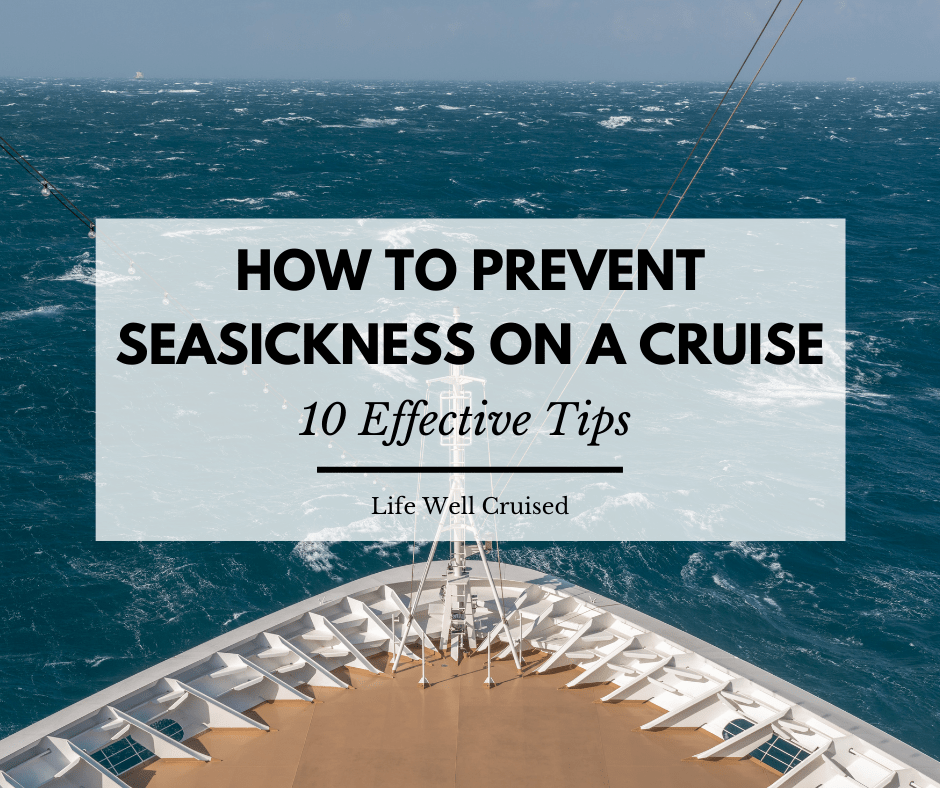
Sharing is caring!
If you’re going on a cruise and concerned that you might get seasick, you’re not alone. Asking “how to prevent seasickness on a cruise” , is one of the most common questions people have when planning a cruise.
After all, getting seasick really could ruin your vacation. While it’s less likely to happen on today’s large, modern cruise ships, I can tell you from personal experience, it does still happen.
The good news is that there are effective remedies for motion sickness, and these work very well on a cruise.
In this post, I share 10 ways to prevent, treat and ideally avoid seasickness altogether while cruising. I’ve included recommendations for seasickness medications, as well as natural remedies that really work.
As well, we’ll go through some frequently asked questions about how to manage seasickness on cruise ships. With these tips, you’ll be prepared to deal with the motion of the ocean, and prevail!
Seasickness on a Cruise
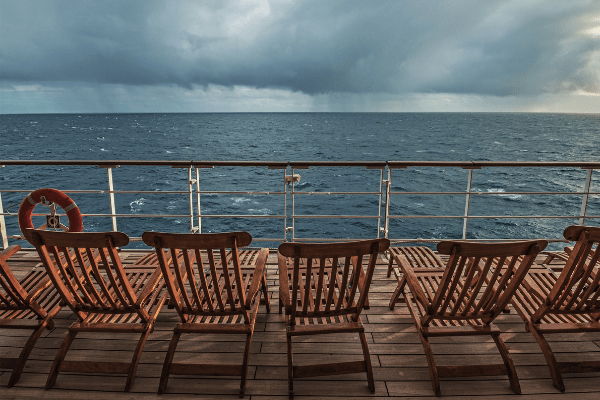
First, let’s go through what to expect if you do get seasick while on a cruise.
What are the symptoms of seasickness?
The symptoms of seasickness on a cruise can include feeling dizzy or having a headache. You may have also feel nauseous, have stomach cramps and even vomit.
For me, early symptoms of motion sickness include lightheadedness and a mild queasy feeling. I try and catch it at this early point, and after more than 20 cruises, this has worked for me.
The tips that I share below will help you to manage any seasickness symptoms.
Why does motion sickness happen on a cruise ship?
How come people get motion sickness on a cruise? Motion sickness happens due to repeated or continuous movement that affects our inner ear and sense of balance. As the cruise ship sails, some people can be affected by this motion.
Seasickness is another way to motion sickness, but on a cruise ship. You may also have heard the expression, “mal de mer”, which is French for sickness of the seas.
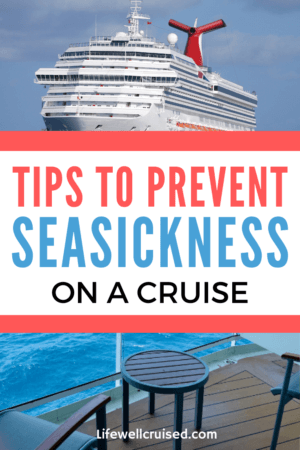
How likely are you to get seasick on a cruise ship?
Even though concerns about getting seasick on a cruise is a very common worry, especially for first time cruisers , most people will be fine. Modern cruise ships are built with stability and comfort in mind, and have stabilizers which are used, especially in rough seas.
However, you may feel some motion or slight vibration while on a cruise. I mention this as we were a bit surprised to find this out on our first cruise.
So many people said “you won’t feel the ship move” . They mean well, but on some cruises you’ll feel more movement then others, so it’s best to be prepared.
In some cases, the ship can hit rougher seas and high winds, and there will be some rocking. However, let me assure you that a large cruise ship will feel nothing like the movement on a small boat or even a ferry.
How to Prevent Motion Sickness on a Cruise
This post contains affiliate links which means if you click and buy that I may make a commission, at no cost to you. Please see my disclosure policy for details.
Life Well Cruised is a participant in the Amazon Services LLC Associates Program, an affiliate program designed to provide a means for sites to earn advertising fees by advertising and linking to Amazon.com.
One of the best ways to deal with seasickness on a cruise, is to prevent and avoid it if at all possible. These 10 seasickness prevention tips are ones that have worked for us, as well as many avid cruisers and crew.
1. Pick the right cruise cabin location
Before we get into what seasickness medications work best and some other tips and tricks, we should talk about cruise cabin locations.
To prevent seasickness, be sure that you choose the best stateroom location possible. If you’re new to cruising and unsure how you’ll feel, choose a mid-ship location.
These are the most desirable cabins because there will be less movement in the middle of the ship. Whether you choose an inside cabin , or a balcony cabin , try and choose a cabin that is as center as possible.
If a mid-ship cabin isn’t available, then opt for an aft cabin or mid-aft stateroom. If at all possible, try to avoid a forward cabin , as many cruise passengers report feeling more motion in this location.
A travel agent can help you to pick the best cabin for you, and look out for any other cabins to avoid .
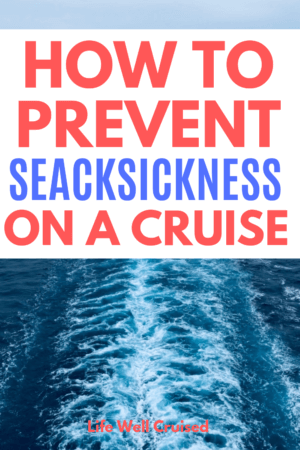
2. Pick a “calm” cruise itinerary
While the seas can be unpredictable, there are some cruise itineraries that generally have calmer seas, than others. If you’re concerned about getting seasick, avoid trans-Atlantic crossings and other itineraries where the seas can be fierce.
Your travel agent will be able to help you navigate the possibilities (pun intended), as a rule of thumb, the Western Caribbean and the Gulf of Mexico tend to have more stable seas.
3. Green Apples

Would you like to know a cruise tip that really works to get over seasickness on a cruise? Eat a granny smith or green apple.
This has long been a favorite crew and passenger tip. In our experience, it really does help.
Often, eating a green apple will settle the stomach if you start to feel nauseous due to seasickness. Apparently, the pectin in green apples helps to neutralize acid in the stomach, and the natural sugar helps settle the stomach
You’ll find green apples in the buffet, so it’s a good idea to take a couple back to your room, in case you need them later on in the cruise.
4. Ginger candies

Another natural remedy for dealing with motion sickness while cruising is ginger. If you don’t want to eat raw ginger, you can buy ginger candies or even dried, sugar coated natural ginger.
Some cruise lines, such as Cunard , even give out ginger in the evening with dinner when the seas are rough.
While I prefer not to eat raw ginger, I always bring some ginger candies and usually find them very effective in preventing seasickness before it starts.
Recommended: Ginger candies – organic and gluten free (Amazon)
5. Bonine or Dramamine

An over the counter medication like Bonine or Dramamine, can be highly effective to deal with symptoms of seasickness, so you can enjoy your cruise.
In our experience, worked very well, alleviating seasickness symptoms without drowsiness.
Make sure to bring a pack or two your toiletry bag or cruise first aid kit . This way, if you need it you won’t have to hope the shop is still open on the cruise ship.
Recommended: Bonine Motion Sickness prevention tablets (see Amazon reviews & price here)
6. Seabands

A favorite cruise essential for many, seabands are wristbands that alleviate motion sickness symptoms. They work with acupressure buttons to prevent symptoms of seasickness and many cruisers have very good results. Seabands are natural and contain no medication, plus, they’re reusable.
If you think that you may be prone to motion sickness, it’s a good idea to take along seabands for both adults and children , in case.
Recommended: Seabands (check on Amazon for variety packs)
7. Motion Sickness Patch/Scopolamine
If you’re prone to motion sickness, scopolamine patches, which are placed behind the ear, are very effective in preventing seasickness.
They are a preventative treatment, and should be used ideally before symptoms begin, and need to be changed every 3 days. They may only be available by prescription, so talk with your doctor to see if they’re right for you.
There are also non-prescription seasickness prevention patches available, that many use and find effective. Check out the information and reviews to learn more.
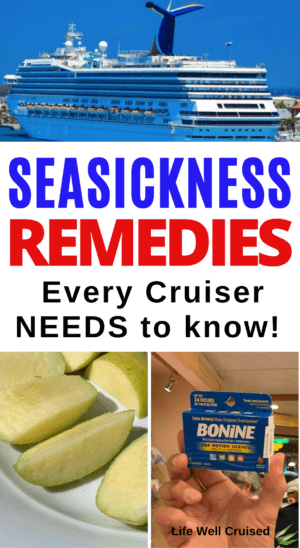
8. Acupuncture
Another preventative treatment for motion sickness on a cruise is acupuncture . An alternative treatment, it’s effectiveness isn’t conclusive. Anecdotal reports suggest many patients have had good results.
My mother-in-law, who also suffers from vertigo periodically, uses acupuncture before she goes on a cruise. I’ve been on cruises with her, and have seen how it definitely worked for her. She was well and unaffected, even while others were swaying and turning green during an evening of very rough seas.
If you already use acupuncture, you may want to ask your practitioner if he or she thinks it will help to prevent seasickness on your cruise. As always, please do check with your physician.
9. Keep hydrated
It may sound simple, but keeping hydrated by drinking a lot of water will help prevent feelings of seasickness. While on a cruise you may be getting too much sun and even drinking too many alcoholic drinks, which can lead to becoming dehydrated.
By keeping hydrated, your body will be at it’s best and less prone to nausea, headaches, dizziness and upset stomach. It’s also helpful to avoid very fatty or spicy food.
Cruise tip – Bring along a refillable water bottle , to stay hydrated on your cruise.
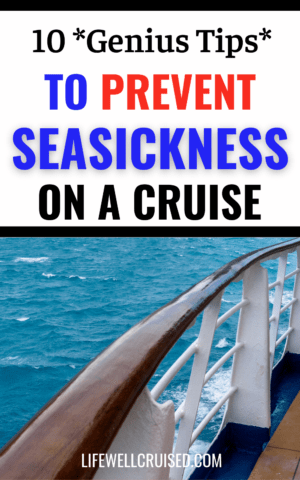
10. Get fresh air
If you suddenly start to feel unwell, with symptoms dizziness and nausea, try and get fresh air as soon as possible. A good place to sit is on the Lido deck, near the mid-ship pool. This location, in the open space and with a sea breeze, is probably the best place to grab a green apple and wait for symptoms to subside.
There is also advice to look at the horizon. This may work for some, however in our experience, if there are large waves, this may do more harm than good.
A word of caution – often taking medication to remedy or even prevent motion sickness symptoms as soon as they start is most effective.
Best Motion Sickness Medication for a Cruise
As a recap, these are the most effective and recommended seasickness medications and natural remedies for a cruise (all Amazon links).
Seabands (for adults)
Seabands (for children)
Dramamine (long lasting nausea relief)
Dramamine for kids (see choices on Amazon)
Ginger candies
Motion sickness patches
Watch our YouTube video below for more tips on preventing seasickness while cruising
Recap: How to Prevent Seasickness on a Cruise
A common concern for new cruisers, is how to avoid and prevent getting seasick on a cruise. In this post, we went over what to expect on a cruise, and how likely it is to feel symptoms of motion sickness on a modern cruise ship.
We also shared 10 effective tips for preventing and dealing with seasickness on a cruise. The remedies include both seasickness medication and natural remedies, that have been shown to be useful and helpful for cruisers.
Don’t forget to pack some seasickness medication or prevention treatments to bring along on your cruise vacation.
Have you ever been seasick on a cruise? What tips, medications or treatments did you find worked best?
Happy cruising!
P.S. If you enjoyed this post and found it helpful, please don’t keep it to yourself ;-). Please share on Facebook or PIN to your favorite Pinterest board (share buttons at the top). Thanks so much!
What to Pack for a Caribbean Cruise
31 Cruise First Aid Kit Essentials You Need to Have
What Toiletries to Pack for a Cruise (packing list)
25 Cruise Essentials Most Popular on Amazon
21 Things People Forget to Pack for a Cruise (and regret)
30 Cruise Cabin Hacks Every Cruiser Needs to Know
Let’s connect:
Follow me on Facebook at Life Well Cruised
Follow me on YouTube at Life Well Cruised (Vlogs and cruise tips)
Follow me on Pinterest at Life Well Cruised
Follow me on Instagram at Life Well Cruised
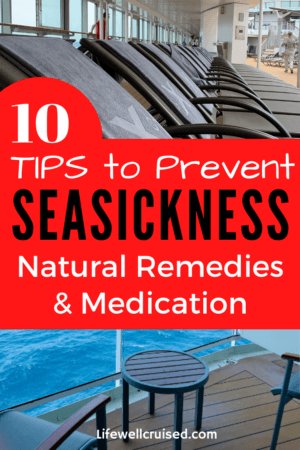
15 Comments
I read this article prior to going on a cruise to the Bahamas and found some of these tips very helpful. When searching for an acupressure band I came across NoMo Nausea at CVS. It is an silicone acupressure wristband that is infused with peppermint essential oils. I have tried sea bands before and while they provided slight nausea relief for me, I found the peppermint scent combined with the acupressure to work more effectively when reducing my sea sickness. Hope this helps for others who also experience seasickness!
Hi Juliette,
Firstly, thanks so much for reading this and then taking the time to come back and add your suggestion. That’s really interesting – I’ll have to keep an eye out for a seaband combined with that scent.
I’m sure your personal suggestion will be helpful to someone.
Hope you enjoyed your cruise!
Hello! Thank you for all the great information.. Another thing that helps with seas sickness is lime. Slicing and smelling the lime really works. I learned this on a snorkeling trip in Mexico. I want feeling well from all the bobbing in the water and was given lime by the locals and in a short time I was feeling myself again. On my last cruise I asked my waiter to bring me lime slices as the dining room was in the front of the ship and soon the entire table was enjoying the lovely sent of lime and feeling great!
Thanks so much for this! Great info!
Glad the info was helpful Becky. Have a great cruise!
- Pingback: What You Need to Know if You're Cruising Out of South Florida - Coastlines to Skylines
I love using Motioneaze oil. You rub it behind your ear and it really works! Expensive on the ship but not too bad on Amazon or at CVS.
Thanks Tricia. I’ve never heard of it or used it, but that sounds great.Great tip to pre-buy rather than get it on the ship.
I appreciate you taking the time to comment 🙂
Ilana and Tricia – I experienced fairly serious motion sickness on our 2nd sea day — I wasn’t the only one, as the ship staff stocked those “special bags” everywhere.. Nevertheless, I was wearing seabands, I took Dramamine; tried all sorts of remedies and preventives; and nothing worked all day until my friend gave me Motioneaze. Within minutes of applying this behind my ears, I felt immensely better. (It’s possible that the seas were finally calming by then!). Thank you for great posts!!!
Thanks for sharing the recommendation!
Tricia,, I have never heard of this, going to check it out. Thanks so much!
My understanding is that it is good to look at horizon so your eyes and ears “agree”. It works for me.
That’s awesome and good advice. That works for me, but my husband will feel more sick. I have a feeling it’s because the wobbly feeling has already set in.
Thanks Patty for the comment – I know it will be helpful to others 🙂
Dramamine now makes a “Non-Drowsy Naturals” version of their motion sickness pills. I have always found that regular Dramamine and Bonine make me feel very sleepy (even the non-drowsy formulas). However, I was able to take the Dramamine Naturals version (made with ginger) and it worked just as quickly on the motion sickness and did not make me drowsy at all.
That’s great to know Melissa. Thanks so much for sharing how well this worked for you. I love ginger so perhaps I’ll try it next cruise 🙂
Leave a Reply Cancel reply
Your email address will not be published. Required fields are marked *
This site uses Akismet to reduce spam. Learn how your comment data is processed .
Will I get seasick on a cruise? Here's what travelers should know.

Mackenzie Pollock had a feeling she’d get seasick on her first cruise .
The 29-year-old Oregon resident tends to get carsick, so when she felt nausea on a Caribbean sailing with Princess Cruises in February, it wasn’t a surprise. And she came prepared.
Pollock talked to her doctor before the trip, who prescribed Scopolamine patches. She also stocked up on Bonine tablets after seeing videos about it online. “I’m a librarian,” she said. “I do copious amounts of research on everything.”
There were “days here and there” during the 20-day trip when she felt sick, like when they went in and out of Florida and sailed through a thunderstorm. But between the two medications and other coping strategies like sitting on her suite’s balcony, she was able to manage it and enjoy her time with family.
Getting seasick can put a damper on a cruise, but there are ways to keep it from ruining your trip.
Why do people get seasick?
Seasickness is a form of motion sickness. That happens when there is a difference between the information you get from your visual system, your inner ear and receptors in your muscles, according to Dr. Kathleen Cullen, a professor of biomedical engineering at Johns Hopkins University. In a cruise ship cabin, for instance, the surroundings might appear stable even while the vessel is moving.
“And this mismatch between what your visual system is experiencing and what your balance organs are telling your brain about how you're moving is sort of an alert signal to your brain that something is wrong,” said Cullen. “So, it's a sensory conflict that actually is the big problem.”
Motion sickness symptoms can include nausea, dizziness and vomiting.
Some travelers are more vulnerable than others, according to the Centers for Disease Control and Prevention. Those include kids between 2 and 12, and people who have a history of migraines, vertigo and vestibular disorders. “Pregnancy, menstruation, and taking hormone replacement therapy or oral contraceptives have also been identified as potential risk factors,” the health agency said on its website .
On the other hand, people older than 50 are less likely to develop it, and toddlers and infants are usually immune.
What is the worst cruise for seasickness?
While modern cruise ships have stabilizers that reduce their roll, some itineraries are more prone to choppy waters.
“If you're doing a transatlantic over to England , the North Atlantic can be pretty gnarly, especially in the winter,” said Rusty Pickett, a travel adviser and owner of Shellback Cruises. The Drake Passage, a feature of many Antarctica expedition sailings , is also notoriously treacherous.
Travelers can seek out calmer seas, though. ( Click here for USA TODAY’s guide to the best times to cruise by region.)
Where is the best cabin to avoid seasickness?
The bow of the ship tends to bounce up and down, said Pickett. “Lower in the ship, middle (and just aft of middle) minimizes the movement,” he added.
Booking a stateroom with a window so you can keep an eye on the horizon or getting fresh air – like Pollock did on her balcony – could also be helpful, Cullen said.
Short vs. long cruises: Which one is right for you? Here's how they compare.
How do I stop being seasick on a cruise?
Travelers can bring medications and other remedies with them. Prescription Scopolamine patches can help get passengers “over the hump,” Cullen said. There are also other over-the-counter medications like Dramamine.
Those can make users drowsy. Travelers should talk to their doctor about their options ahead of their cruise.
Ginger candies or ginger ale – made with real ginger – and acupressure wristbands may also be helpful.
After you board, Cullen recommends watching the horizon on the ship’s outer decks. “That's a pretty good way to keep yourself, initially, from getting motion sick if you're prone to it,” she said.
The CDC offers other suggestions , including lying down, closing your eyes and sleeping; limiting caffeinated and alcoholic drinks; eating small portions of food often; and not smoking.
What other options do passengers have?
Cruise ships generally have onboard medical staff that can treat a range of ailments, and Pickett said the vessels keep a supply of seasickness medication on hand.
During an Antarctica expedition I took with Aurora Expeditions in December, crew members also placed barf bags around the ship that passengers could grab if they felt sick while outside their rooms.
Pollock said feeling seasick didn’t put her off cruising, and she and her family plan to take another. “It was frustrating when it happened, but it didn't overshadow the trip at all.”
Nathan Diller is a consumer travel reporter for USA TODAY based in Nashville. You can reach him at [email protected].
How to Manage and Avoid Seasickness on Your Next Cruise
Seasickness is a huge problem for many people, and it can ruin your trip if you don't treat it. Luckily, we're here to help you out.
Traveling by boat or cruise is exciting, but your experience onboard can vary depending on the weather. If you have an upcoming sail planned, it’s worth knowing how to prevent seasickness before you depart in case you experience severe weather during your crossing.
Whether you’re traveling on a small boat or a large ship, here are some of the best ways to prevent seasickness while sailing. (Top tip: check out these ideas before you travel so you can download any necessary tools without getting stung by maritime roaming charges).
What Is Seasickness and What Is It Caused By?
Before we dive into how to prevent seasickness, let’s look at what it is and why it happens. Understanding the condition can help you better prepare for and prevent it if the dreaded sensation hits.
Seasickness is a type of motion sickness. When there’s a lot of unusual movement occurring, your brain can’t process the conflicting information your eyes, ears, and body are sending. Your brain’s confused reaction to these muddled signals is what makes you feel seasick.
Symptoms of seasickness can include:
- Rapid breathing and heart rate
Although incredibly unpleasant, there are tools you can use to prevent seasickness. We’ve outlined five steps you can take to help avoid as well as manage feeling ill when at sea.
1. Breathe Slowly and Deeply
According to PubMed , controlled breathing (slow diaphragmatic breathing) has been shown to decrease motion sickness. Therefore, one of the best ways to prevent seasickness is to breathe slowly and deeply.
Controlled breathing can be trickier than you think, however, especially if you’ve not tried it before. Many of us are in the habit of breathing quickly and shallowly, so it can take a bit of practice to slow your breath down.
To help improve your breathing, you can download a meditation app that offers breathwork guides . This way, you can be prepared if seasickness overcomes you while you’re traveling.
It’s worthwhile practicing rhythmic breathing before you depart so that if and when seasickness hits, you can call upon this method automatically. Start by breathing through your nose gently and exhaling through your mouth. Try to slow your breathing down and make each inhale and exhale last as long as possible (don’t hold your breath!); counting can help you control the timing.
2. Stay Hydrated
There are plenty of hydration apps around that remind you to drink water , and you may need this reminder when you’re seasick. The thought of putting anything in your tummy while it's somersaulting can make you feel worse, but it’s important to stay hydrated if you become seasick.
The important thing to do when trying to stay hydrated is to sip your water. Downing a glass of water might hit your stomach wrong and come shooting back up as quickly as you swallowed it! (Remember, this is what we’re trying to avoid, not encourage). How you drink is almost more important than how much you drink when you’re poorly at sea.
To help prevent seasickness, make sure you drink plenty of water before you board your ship. Starting hydrated is better than trying to catch up later if you’re struggling to take in and keep down any fluids.
3. Lay Down and Sleep (if You Can)
If you’re feeling dizzy and nauseous onboard, one of the best things you can do is lay down flat on your back. This can help align the sensory cues that your brain has muddled up and will hopefully ease any nausea and other symptoms.
Prior to departing, however, it’s worth getting some extra sleep in to prevent seasickness, as feeling tired and exhausted can make you more susceptible to unpleasant symptoms. If you struggle with getting a good night's sleep, it might be worth trying an app designed to help battle insomnia or even investing in a smart sleep mask to improve your rest time.
Booking a cabin is a good option to help prevent seasickness. If you’re going on a long voyage and you have the option to book a cabin, pick one that’s close to the center of the boat (and lower down, if possible). There’s less motion here which will reduce your chance of becoming seasick. Having a cabin also provides somewhere quiet and private where you can lie down if seasickness hits you.
Even better: try to sleep off the seasickness. Think of sleep as time travel to freedom!
4. Listen to Soothing Sounds to Help Relax
While you’re laying down to prevent seasickness (or any other comfortable position you manage to settle in), listening to soothing sounds will help you relax. Anxiety and panic can make seasickness worse, so an ambient sounds app might do just the trick.
You’ll find plenty of apps for listening to calming sounds on your device’s app store. The trick is to pick one that you know will relax you, so trying out a few different apps when you’re still on dry land is advisable. There is a wide variety of sounds available, from rain and thunderstorm sounds to white noise and ambient music, so take the time to pick a sound app that you enjoy—and that you know will help you relax.
5. Listen to an Audiobook to Distract Yourself
If you’re struggling to prevent seasickness, the next best step you can take is to distract yourself from feeling ill, and what could be more enjoyably distracting than listening to a story?
Looking at your phone’s screen may make you feel worse, but if you are able to control your device with your voice , opening an audiobook app could be your best bet.
Listening to an audiobook is a fully immersive experience as you’re taken away to another world (i.e. a better one than the physical plane you’re currently suffering in!)
Audible is a popular audiobook app with plenty of stories to choose from, and you can often benefit from a free trial of the app if you’re not ready to purchase. Alternatively, there are other free and cheap audiobook apps you can try to find the perfect story to listen to.
If you're not an audiobook person, then you could listen to a podcast series instead. Podcasts are more accessible than audiobooks, and the majority of them are free. Just make sure you download any episodes or books you wish to listen to before you leave. If your ship doesn’t offer free Wifi, you don’t want to be stung with a whopping data bill for connecting to Maritime roaming charges.
How to Prevent Seasickness on Your Next Cruise
Feeling sick aboard your cruise can be miserable and unpleasant, but the steps above can help you prevent seasickness. Remember to take it easy, try to stay still and lay down if you can, and—if severe—reach out for help. There is always a team of trained first-aid staff aboard, so you can ask for help and support.
The Truth About Seasickness
Our chief medical consultant gives us his best tips on preventing seasickness..

One of the most common questions first-time cruisers have is “What if I get seasick?” We understand where the concern comes from, and we have answers. We’ve enlisted Dr. Benjamin Shore, Chief Medical Consultant at Royal Caribbean, to break down the basics and whether it’s actually common for guests to experience seasickness while vacationing at sea.
“Considering the large size of today’s cruise ships , seasickness is rarely a problem,” says Dr. Benjamin Shore. He adds that with innovative design and engineering, ships can also safely navigate around inclement weather , and use stabilizers—fins built off a ship’s port and starboard sides along the water line—to reduce side-to-side motion so most guests never experience any motion sickness.
Before we get to the specifics, here are the basics: Motion sickness occurs when what you see conflicts with what your inner ear senses. In other words, if you’re sitting in a car (not moving) but your inner ear detects movement (the car just hit 70 mph on the highway), the two signals being sent to your brain don’t match. Those mixed signals confuse the brain, and the sensations and symptoms (dizziness, nausea) are the result.
In the event that seasickness does develop, Dr. Shore assures that it’s unlikely to really interrupt your adventure, since all Royal Caribbean ships have motion sickness medications, like meclizine, readily available at the dedicated Medical Center on each of our ships, free of charge.
“Additionally, for more troublesome seasickness, our Medical Centers also carry promethazine and metoclopramide,” Dr. Shore says.
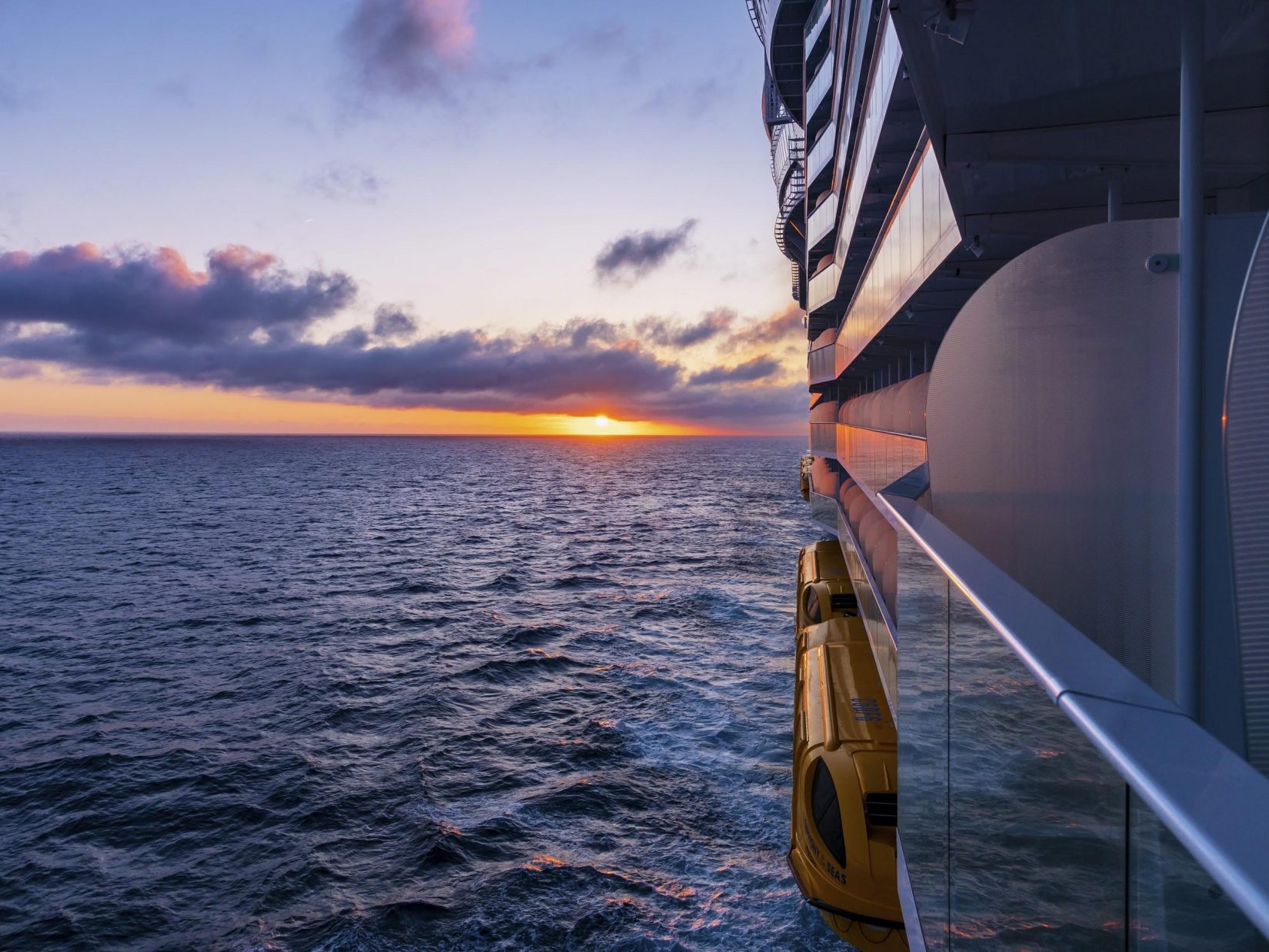
Sometimes the best treatment is prevention. “It’s best that guests who know they are prone to seasickness consult their doctor prior to departure,” Dr. Shore says. If your personal physician thinks it’s appropriate, he or she can prescribe a patch that you can wear to prevent the onset of seasickness. “For prescription patches like Transderm Scop, it’s important for it to be applied prior to boarding to be effective,” he adds.
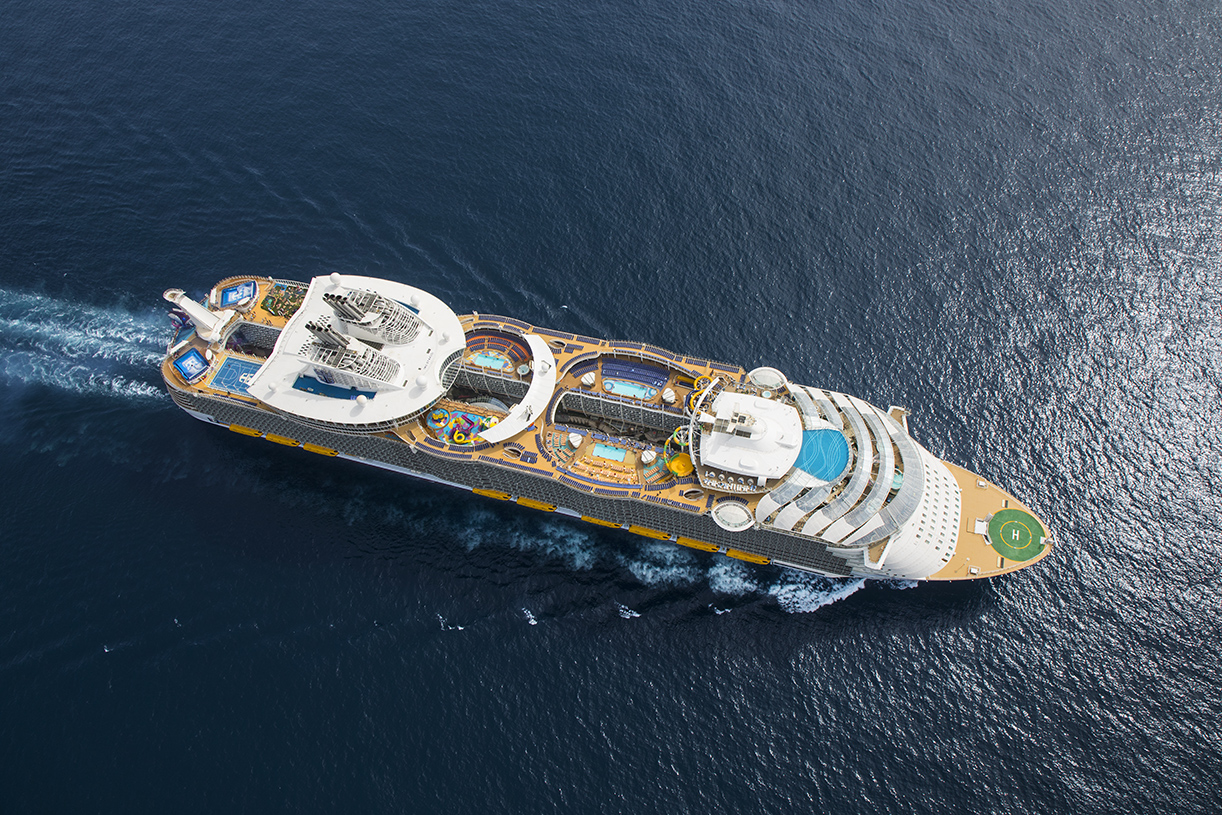
Dr. Shore notes that there are also lots of natural remedies that can help alleviate motion sickness. “Anecdotally, ginger seems to be helpful, and some people find various aromas (like anise, basil, chamomile and peppermint) or eating dry crackers, even after the onset, of seasickness can help.” If a few sips of ginger ale or chewing fresh ginger doesn’t do the trick, he also suggests going for a short walk to the center of the ship, the most balanced area on board and therefore least likely to produce seasickness symptoms.
An unexpected solution Dr. Shore suggests is “the smelling of newspaper print!” He says, “science has no idea why this works so well, but it actually seems to diminish the sensation of nausea.”
With Dr. Shore’s advice and Royal Caribbean’s staff of medical professionals, it’s only smooth sailing for our guests!
If you’re ready to explore Royal Caribbean’s many destinations (more than 260 ports around the world), click here to set sail on your next vacation.
Related Articles

Bonnie Tyler Will Join Royal Caribbean, DNCE For Total Eclipse Concert

Carlos and Alexa PenaVega Talk About Their New Film, "Love at Sea"

9 Travel Gadgets To Pack For Your Next Vacation

How To Pack For The Ultimate European Cruise
- Twitter / X
- Readers' Choice
- Food & Drink
- Arts & Culture
- Travel Guides
USA TODAY 10Best
Avoid getting motion sickness on a cruise: 10 tips and tricks to keep you steady

February 15, 2024 // By Tamara Gane
By Tamara Gane February 15, 2024

If you’re preparing for a cruise, you may wonder how to avoid motion sickness. After all, nothing spoils the magic of seeing a whale breach or a sunset at sea like nausea or dizziness. Even the most experienced cruisers could fall prey to seasickness on a cruise ship , but this doesn't mean you should change your vacation plans. It simply means you should be prepared so nothing comes between you and a fantastic cruise.
To help, we asked Dr. Amber Robins , a family and lifestyle medicine doctor, about the most effective ways to prevent getting seasick on a cruise. She provided simple, yet vital answers to help you feel your best during your next sailing.
What is the best medicine for motion sickness?
“Many people benefit from wearing scopolamine patches that help treat nausea and motion sickness,” Robins states. These patches work with the central nervous system to calm delicate areas like the stomach and bowels. This helps prevent motion sickness instead of merely treating symptoms after they occur.
Advertisement Advertisement
Since scopolamine is available by prescription, consult your doctor before your cruise to see if the patches are for you.
Over-the-counter medicines to prevent seasickness

“Over-the-counter medicines like Dramamine can help improve the nausea that comes with seasickness,” according to Robins. She explains that Dramamine blocks the histamine receptors, which leads to a balanced feeling. Note, however, that since Dramamine is an antihistamine, it may cause drowsiness in some users.
Bonine is another over-the-counter option; its main ingredient is meclizine, which, for many people, treats symptoms without causing drowsiness. The directions on the packaging indicate that Bonine, which acts as a preventative, should be taken an hour before traveling and then once a day, like a daily vitamin, for the length of the cruise trip.
Herbal cures for motion sickness
If you're searching for natural remedies for motion sickness, Robins says ginger may help. Ginger has historically been used to treat nausea. The natural herb is especially popular with pregnant women suffering from morning sickness. If feeling nauseous at sea, try fighting that queasiness with ginger, which is widely available in the form of capsules or chews .
Do acupuncture bracelets and wristbands help avoid seasickness?
If you’re wondering about the effectiveness of acupuncture bracelets and wristbands for preventing seasickness, Robins says studies are mixed.
“The bracelets are made to push on a specific area of the wrist. For some, this has decreased nausea and vomiting," she says. “It's hard to conclude that this bracelet would work for everyone.”
Does staring at the horizon help with motion sickness?
Carnival Cruise Line recommends staring at the horizon to prevent motion sickness, and scientific evidence supports that advice.
Life at sea can be disorienting. The disconnect between the movement of the ship and the movement of your body can affect your sense of equilibrium. Fixing your gaze on the horizon provides a reference point so you can reclaim your sense of balance.
If reading makes you feel seasick, put the book away

If reading in a vehicle makes you feel carsick, you're experiencing disorientation and motion sickness . Unfortunately, those symptoms can also happen on a cruise. If you start to feel nauseous, dizzy, or unwell while staring at a book or screen at sea, put the reading material aside for a while and see if the symptoms improve.
Can shore excursions help fight motion sickness?
Robins says that disembarking from the ship may alleviate the symptoms of seasickness. While this advice may not be practical at sea, it is once you pull into port. Getting back on land can help reclaim your sense of balance. Plus, now you have a great excuse to book some incredible shore excursions when you schedule your cruise itinerary .
How to pick the right cabin to prevent seasickness

Choosing the right cabin is important when booking a cruise. According to Carnival Cruise Line, ships rock and sway the most at the edges. If you book a cabin near the middle, you’re less likely to be affected by all that movement. In addition, cabins with windows or balconies make it easier to focus on the horizon if you feel woozy.
Can dehydration cause motion sickness?
“Staying hydrated can help improve symptoms like dizziness, nausea, and vomiting that can come with seasickness,” states Robins. So be sure to drink plenty of water. Since alcohol can lead to dehydration, avoid drinking in excess.
Can the ship doctor help if you’re feeling seasick?
Cruising is truly a bucket-list experience. Don’t let motion sickness spoil your trip. If you can’t find relief from your seasickness, speak to the ship doctor and ask for help alleviating your symptoms. Most cruise lines have motion sickness medicines and other remedies available to passengers at no charge.

About Tamara Gane
Tamara Gane is an expert panel member for 10Best Readers' Choice Awards. She's based in Reno/Lake Tahoe and in addition to USA Today 10Best, her work has been published in Travel & Leisure, Fodor's Travel, The Washington Post, SF Gate, Houston Chronicle, Lonely Planet, and more.
Read more about Tamara Gane here.
Connect with Tamara via: Instagram
- Port Overview
- Transportation to the Port
- Uber & Lyft to the Port
- Dropping Off at the Port
- Cruise Parking
- Cruise Hotels
- Hotels with Parking Deals
- Uber & Lyft to the Ports
- Things to Do
- Cozumel Taxi Rates
- Free Things to Do
- Restaurants Near the Cruise Port
- Hotels & Resorts With Day Passes
- Closest Beaches to the Cruise Port
- Tips For Visiting
- Shore Excursions
- Cruise Parking Discounts
- Hotels with Shuttles
- Which Airport Should I Use?
- Transportation to the Ports
- Dropping Off at the Ports
- Fort Lauderdale Airport to Miami
- Inexpensive Hotels
- Hotels near the Port
- Hotels With Shuttles
- Budget Hotels
- Carnival Tips
- Drink Packages
- Specialty Restaurants
- Faster to the Fun
- More Articles
- CocoCay Tips
- Norwegian Tips
- Great Stirrup Cay
- Harvest Caye
- How to Get the Best Cruise Deal
- Best Time to Book a Cruise
- Best Websites to Book a Cruise
- Cruises Under $300
- Cruises Under $500
- Spring Break Cruise Deals
- Summer Cruise Deals
- Alaskan Cruise Deals
- 107 Cruise Secrets & Tips
- Tips for First-Time Cruisers
- What to Pack for a Cruise
- What to Pack (Alaska)
- Packing Checklist
- Cruising with Kids
- Passports & Birth Certificates
- Bringing Alcohol
- Cruising with a Disability
- Duty-Free Shopping
- Cruise Travel Insurance
- Things to Do on a Cruise Ship
- What Not to Do on a Ship
- News & Articles


Will I Get Seasick on a Cruise? Everything to Know About Sailing Comfortably
When it comes to enjoying your vacation, nothing can change things faster than being seasick on your cruise. Meanwhile, it’s said that motion sickness occurs in about 25% of people. So on a cruise with 4,000 passengers, 1,000 may be worried about not feeling their best.
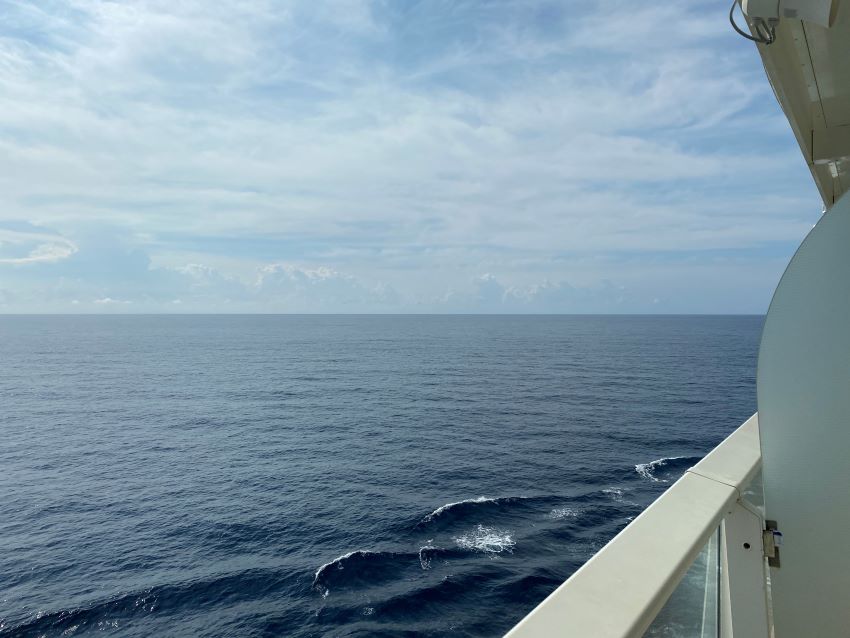
The good news? The number of people feeling seasick is going to be much lower than one in four. Between the stability of the ship and the availability of treatments to keep you feeling good, the number of people impacted by severe seasickness is fairly low.
Even so, those who are susceptible to feeling queasy will have plenty of questions about being seasick while on the cruise. Here’s what to know…
Is the Cruise Ship Rocky When You Sail?
First things first, you’re likely wondering what it’s like to be on the ship in the middle of the ocean. If you’re someone that suffers seasickness, you might be worried that on the ocean the ship will constantly be rocking back and forth.
We can tell you after taking dozens of cruises, that’s simply not the case. There are times where you can feel the ocean’s movement, but it’s usually slight. So instead of feeling a sway back and forth — say, to where you would stagger when you walk — you might feel the ship move just enough to remind you that you’re on the water.
Can it get rockier? Of course, but remember that cruise lines have no interest in a cruise that tosses the ship around. Even if passengers don’t get seasick, it doesn’t exactly make for a fun vacation.
How Does the Ship Stay Stable in the Water?
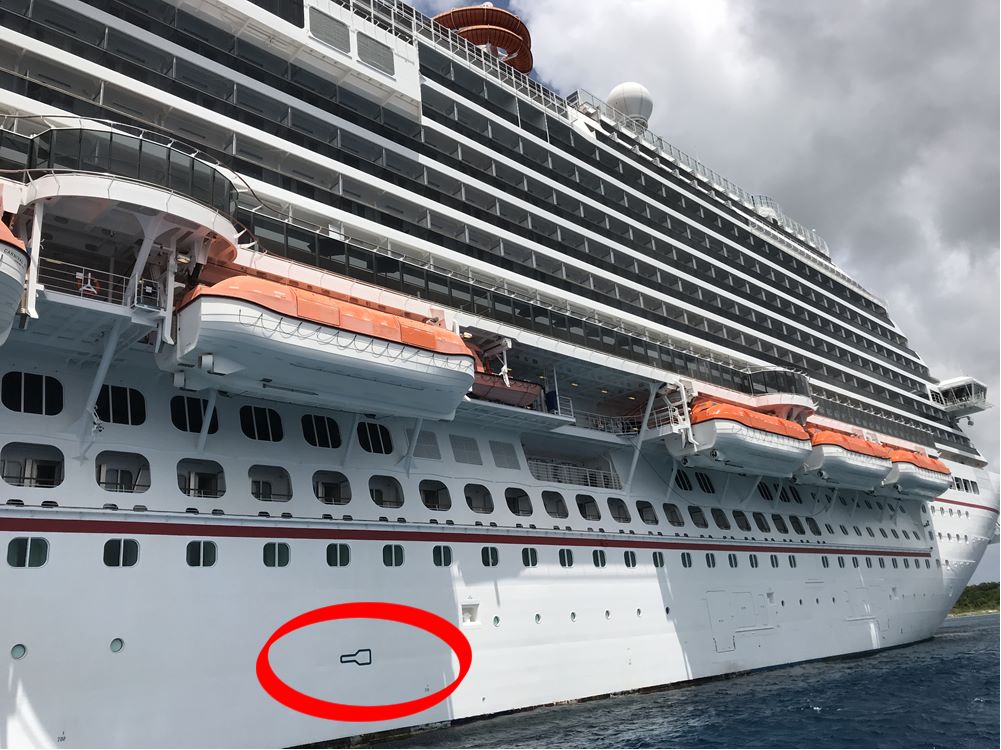
Look at a ship and the fact that it stays stable seems like magic. After all, they can tower high above the water and with everything on top of the ship, they also look fairly top heavy. However, there are ways ships are built and some strategies used to ensure they stay stable while cruising.
First, cruise ships can move. Today’s forecasting tools can offer lots of advance notice about weather conditions. While a ship can’t completely avoid all weather, it does have the ability to maneuver or change course to offer a more comfortable ride when possible.
Even if there is rocky weather, however, it doesn’t mean the ship will be rolling. Modern ships are built with stabilizers under the water. Passengers will never see these, but if you notice a symbol painted on the ship’s hull that looks like a key, that means there is a stabilizer there.
These stabilizers are shaped like a wing that folds out from the ship and cuts through the water. With the wing out, it makes it much harder for the ship to rock back and forth as the wing will push against this type of motion. The result? A much more stable ride.
Do People Get Seasick?
On the vast majority of cruises, we wouldn’t label seasickness as a major issue. For instance, unless you happen to hit weather, you won’t see passengers carrying around paper bags in case they get queasy.
That said, there’s no doubt that some people are more sensitive to motion than others. So, yes, out of the thousands of passengers, there might be some who still get sick.
If you’re someone who easily gets motion sickness, then we highly suggest taking some preventative steps to make sure you will be able to enjoy your vacation.
The good news if you do get sick? Most cruises to places like the Caribbean are at sea only for a day before reaching a port of call. That means there won’t be days on end with no relief. Within short order you’ll be docked, giving you a break.
What Can I Do to Prevent Seasickness on a Cruise?
Still concerned about motion illness while on your vacation? In that case, you can take steps to prevent it so you can have fun on your trip instead of feeling sick to your stomach.
There are plenty of natural remedies out there (eating green apples, ginger, etc.), that may work but we’d suggest something more tried and true. According to the CDC, “commonly used medicines are diphenhydramine (Benadryl), dimenhydrinate (Dramamine), and scopolamine.”
Seattle Children’s Hospital also recommends Dramamine for motion sickness , including for kids as young as two years old.
Bottles of Dramamine and other remedies are available at any drugstore or on Amazon and only cost a few bucks.
Are Remedies Available Onboard?
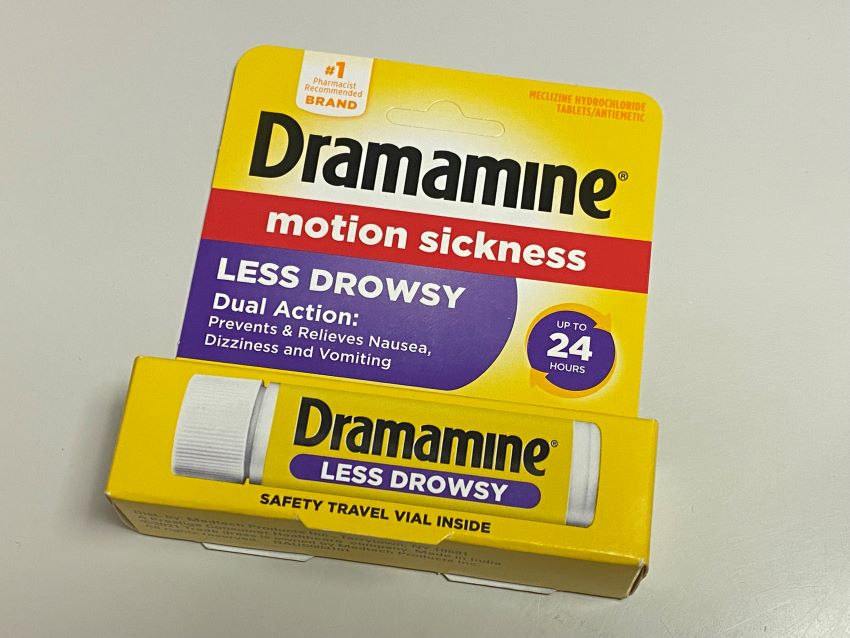
Say you completely forget to bring something for seasickness. Or say you didn’t think it affected you, but some rough weather has your stomach in knots. In that case, you aren’t out of luck.
First, you can head to Guest Services. Often they have seasickness pills available at no charge for passengers who need them.
If there are none there, then each cruise ship will have a shop selling sundries like snacks, toothpaste, batteries, and yes, seasickness medications.
Finally, if you can wait until you are in a port of call, every port area will have some sort of small shop that you can buy items you forget — including medicines — for cheaper than on the ship.
Popular: 39 Useful Things to Pack (17 You Wouldn't Think Of)
Read next: park & cruise hotels for every port in america, popular: 107 best cruise tips, secrets, tricks, and freebies, related articles more from author, answered: how much cash should you take on a cruise, 44 must-have alaskan cruise tips, tricks, and secrets, cruise anxiety these facts may calm your biggest fears, how to get from the fort lauderdale airport (fll) to the miami cruise port, 41 must-have tips for cruising with babies, toddlers, or small kids (from someone that’s done it), complete guide to using your phone on a cruise (carnival, royal caribbean & more), leave a reply cancel reply.
Save my name, email, and website in this browser for the next time I comment.
The Best Gift Ever for People That Love Cruises? This Might Be it…
Nearly 100 passengers fall ill with stomach virus on princess cruise, cruise news: carnival’s new ship, royal’s new beach club, ncl’s big milestone & more, hotels with cruise shuttles for every major port in america, 107 best cruise tips, tricks, secrets, and freebies, 39 useful things to pack for your cruise (including 17 you’d never think of).
- Privacy Policy
- Terms & Conditions
- Search Please fill out this field.
- Manage Your Subscription
- Give a Gift Subscription
- Sweepstakes
5 ways to beat seasickness on your next cruise
:max_bytes(150000):strip_icc():format(webp)/Erika-Owen-a365ebd9777848eb988db678ff2d879d.jpg)
If there's one thing that will kill your vacation vibe quicker than a delayed flight can ruin your plans, it's getting seasick the first night on a cruise. It happens to a lot of people, and the cure for motion sickness is different for everyone.
First off, what is seasickness? According to WebMD , which classifies it as the same thing as motion sickness, you can expect symptoms like nausea, headaches, sweating, and vomiting. Dizziness and cold sweats are also associated with strong bouts of motion sickness.
Lucky for the weak-stomached of the world, cruise ships are often large enough to avoid the expected "rocking" motion that comes with a boat ride. Without the constant reminder that, yes, you are rolling about on the sea, your inner ear is confused into thinking you're on solid ground. Massive cruise ships also come with built-in stabilizers that react to choppier seas by balancing out the waves for an easier ride. Now, hit an extra bad patch of weather, and all bets are off — just as turbulence irritates motion sickness on an airplane or a particularly bumpy road would bring about car sickness .
There are a couple of things you can do to combat seasickness. Read on and learn:
Choose your cabin wisely.
In an interview with Yahoo , Susan Suver — who manages medical operations at Holland America Line — shared that the location of your cabin is key. "The more towards the middle of the ship, the better," Suver said. "You’ll feel more stable. If you have a tendency to get seasick, avoid cabins the farthest aft [rear] or the farthest forward."
Take medication.
There are some over-the-counter options out there for those looking to kick seasickness symptoms aside. Dramamine and Bonine are both great options for when you know you're going to be hitting some choppy areas. Doctors are also able to prescribe stronger medications, but this requires an office visit — plan accordingly.
Use a motion band.
There are wristbands on the market that utilize acupuncture to relieve the wearer of motion sickness and its symptoms. If you're not a fan of bracelets, there are also patches that can be worn behind the ear to help prevent the side effects of seasickness. Transderm Scop is one of these medications, which requires the wearer to put it on eight hours before they expect their motion sickness to occur. The best part: It lasts up to three days.
Take in the ocean view.
If you find yourself with a bad bout of motion sickness, CruiseCritic.com recommends taking in some fresh air and seaside views to help alleviate your discomfort. The fresh air will help you re-center, and staring at the horizon will help balance your inner ear.
Eat the right things.
There are certain foods that help combat motion sickness. If you start to feel it coming on, LiveStrong.com recommends you reach for one of these:
- Ginger — Pro tip: Candied ginger is a great vacation snack!
- Saltine crackers
- Lemon — Water with a lemon wedge or two will not only help, but it's refreshing.
- Olives — These little guys help reduce saliva, making it harder to get that pre-vomit salivation.
Don't let a little bit of motion sickness keep you from embarking on an ocean adventure. There's plenty you can do before and after motion sickness hits to make sure your vacation goes according to plan.

How to Deal With Seasickness on a Cruise
Afar’s special cruise correspondent has been on dozens of cruises in her life. despite being prone to seasickness, she has mostly avoided it with these remedies..
- Copy Link copied

Don’t let rough waters ruin your cruise vacation.
Photo by Caleb George/Unsplash
I am a cruise writer who suffers from seasickness. But of the approximately 170 cruises I have been on in my life, I have only actually been sick twice, once in particularly strong waves off the coast of Corsica and once when the Pacific was misbehaving off Baja.
I’ve avoided motion sickness on a cruise by bringing the best motion sickness medicines for cruising and by being familiar with factors that contribute to not feeling great—and how to avoid them. For those who don’t know what seasickness is, it starts with your brain getting conflicting information from your inner ear and eyes.
“Inside the cabin of a rocking boat, for example, the inner ear detects changes in both up-and-down and side-to-side acceleration as one’s body bobs along with the boat,” according to the National Oceanic and Atmospheric Administration . “But, since the cabin moves with the passenger, one’s eyes register a relatively stable scene. Agitated by this perceptual incongruity, the brain responds with a cascade of stress-related hormones that can ultimately lead to nausea, vomiting, and vertigo.”
Here are some tried-and-true tips and advice for how to avoid motion sickness on a cruise.
Carefully pick your ship and destination
The medications currently available for motion sickness are strong enough that I recently felt only slightly off while crossing the notoriously rough Drake Passage (sometimes referred to as the Drake “shake”) between Cape Horn and Antarctica , albeit while the seas were mostly cooperating.
Still, you can ensure a smoother ride by sticking to destinations with relatively calm waters. Popular cruise itineraries tend to be on routes that are less prone to rockiness, such as in the Caribbean, Bahamas, and Alaska’s Inside Passage . Once you venture deep into the Atlantic and Pacific, you never know what you’ll get. You may want to keep this in mind if you are a first-time cruiser testing your sea legs.
You’ll experience virtually no seasickness on most river cruises . A great option for those who fear getting seasick are the mostly calm inland waters traversed by river ships.
Modern cruise ships have stabilizers, for a relatively smooth ride wherever you cruise. On big ships with thousands of passengers, you’ll typically feel little movement. Smaller ships may be more of a challenge, but here too you’re likely to find stabilizers. A new generation of expedition ships from brands such as Lindblad Expeditions and Aurora Expeditions are designed with an inverted bow, known as an X-Bow, for a smoother ride.
Choose the right cabin
If you are worried about getting seasick, don’t book a cabin or suite at the very front (or forward end) of the ship, at the very back (aka the aft) of the vessel, or on the upper deck of a ship. These staterooms often feel the most movement. You are better off finding a cabin dead center in the middle of the ship, the most stable area. Also, you might want to make sure you book a cabin with windows so that you can look at the horizon when the ship starts rocking—while it doesn’t work for everyone, keeping your eyes on the horizon can offer a stabilizing effect for some.
The best motion sickness medicines for cruises
If you are worried about being seasick, pack some seasickness medication—options include Dramamine (dimenhydrinate) and Bonine (meclizine). There is a downside to these medications, in that they may cause drowsiness. (There are some nondrowsy options available as well.)
My rule of thumb is to take a half a pill when I first get onboard and until I feel my body has adjusted to the movement of the sea (which may or may not occur after a couple of days on the water). If you have kids who have a tendency to get carsick, you may want to ask your pediatrician about Dramamine for kids that you can give them when they board and as you figure out how they are responding to the movement of the water.
I also listen carefully to the captain’s daily announcements, which usually include a weather forecast for the day ahead. If waves are predicted to be high (more than 15 feet by my standards), I will make sure to take motion sickness medicine—because the reality of the meds is that they don’t really help once you feel sick, so plan accordingly.
If you forgot to pack medication and are feeling ill, ask at the guest services desk or the medical center—they will likely have medicine and the pills are often free.
What if it gets very choppy?
If I am on a route known for rough weather, such as in the Antarctic, I switch out the over-the-counter pills for a prescription Transderm Scop (scopolamine) patch, which goes behind your ear and steadily delivers medication for up to three days. It’s strong and not for everyone, so ask your doctor whether it’s right for you. A downside to the patch is it can make you very thirsty. The patches are also expensive and may not be covered by your health insurance.
In a worst-case scenario, if you are suffering in very rough seas, the ship’s medical team may be able to give you a shot, which can help keep you from getting sick (aka vomiting) but not necessarily from feeling bad.
Homeopathic remedies
Acupressure wristbands , ginger pills , and candied ginger are among the nonmedication ways to deal with seasickness, and some people swear by them. It sounds completely counterintuitive, but you’ll also feel better if you aren’t hungry, according to the U.S. Centers for Disease Control and Prevention (CDC), which recommends eating small amounts of food frequently to help prevent motion sickness. Fortunately, finding food is not a problem on most cruise ships. The CDC also recommends staying hydrated, while limiting both alcoholic and caffeinated beverages.
AFAR’s senior travel news editor Michelle Baran, a fellow sufferer of seasickness, says the wristbands work for her to help avoid getting seasick on a cruise; she also chews mint-flavored gum to help ward off stomach problems when sailing. Similar to seasickness medications, the wristbands will often only work if they are slipped on before the water actually gets choppy (she just puts them on and keeps them on for the duration of the cruise). She will also drink a bubbly soda such as ginger ale or cola and will make sure to look at the horizon to stabilize if she gets motion sickness on a cruise—though, like me, she has mostly managed to avoid seasickness by being prepared with medications such as Dramamine and using the above preventative measures and remedies.
Being out on deck in open air sometimes helps, but my own fail-safe remedy if I am feeling ill and all else fails is to lie down and shut my eyes, and either sleep or listen to music or the TV in my cabin.
Why am I still dizzy after a cruise?
Some people feel like they are still moving when they get off a cruise ship, as their body adjusts to being back on dry land. According to the Cleveland Clinic , this is totally normal, and the symptoms in most cases disappear within a day or two. If they don’t, you may have a rare syndrome known as Mal de Debarquement (MDD) that is still under study. The Clinic recommends you consult with your doctor if the symptoms persist.
>> Next: The Essential Cruise Packing List

Do you really need a motion sickness patch for your cruise?

You've boarded your first cruise and spy lots of your shipmates sporting a patch behind their ears. Why are they wearing this? Does it improve their cruise experience? What do all those people know that you don't?
Those little circular patches you see behind the ears of so many cruisers are most likely a prescription drug called scopolamine transdermal system. It is often prescribed for situational nausea and vomiting after surgery. However, it is also useful for motion sickness, as you might experience on board cruise ships. The medication contained in the patch is slowly released into the wearer's system over the course of three days. It works through the central nervous system to calm the digestive system.
Now that you know, you might develop a case of FOMO. Should you have asked your doctor for patches for your cruise? When I mentioned the patches to my primary care physician (a fellow cruiser), her response was quick and a bit snarky, "What is up with everybody thinking they need scopolamine patches to go on a cruise?"
She explained that she sees many people with no history of motion sickness who want them. However, she cautions they aren't for everyone.
For cruise news, reviews and tips, sign up for TPG's cruise newsletter .
After talking with my doctor, I did further research on prescription motion sickness patches for cruising. Here's what I learned about whether you really need that scopolamine patch — or if you're better off without it.
You might not need a patch to weather your cruise
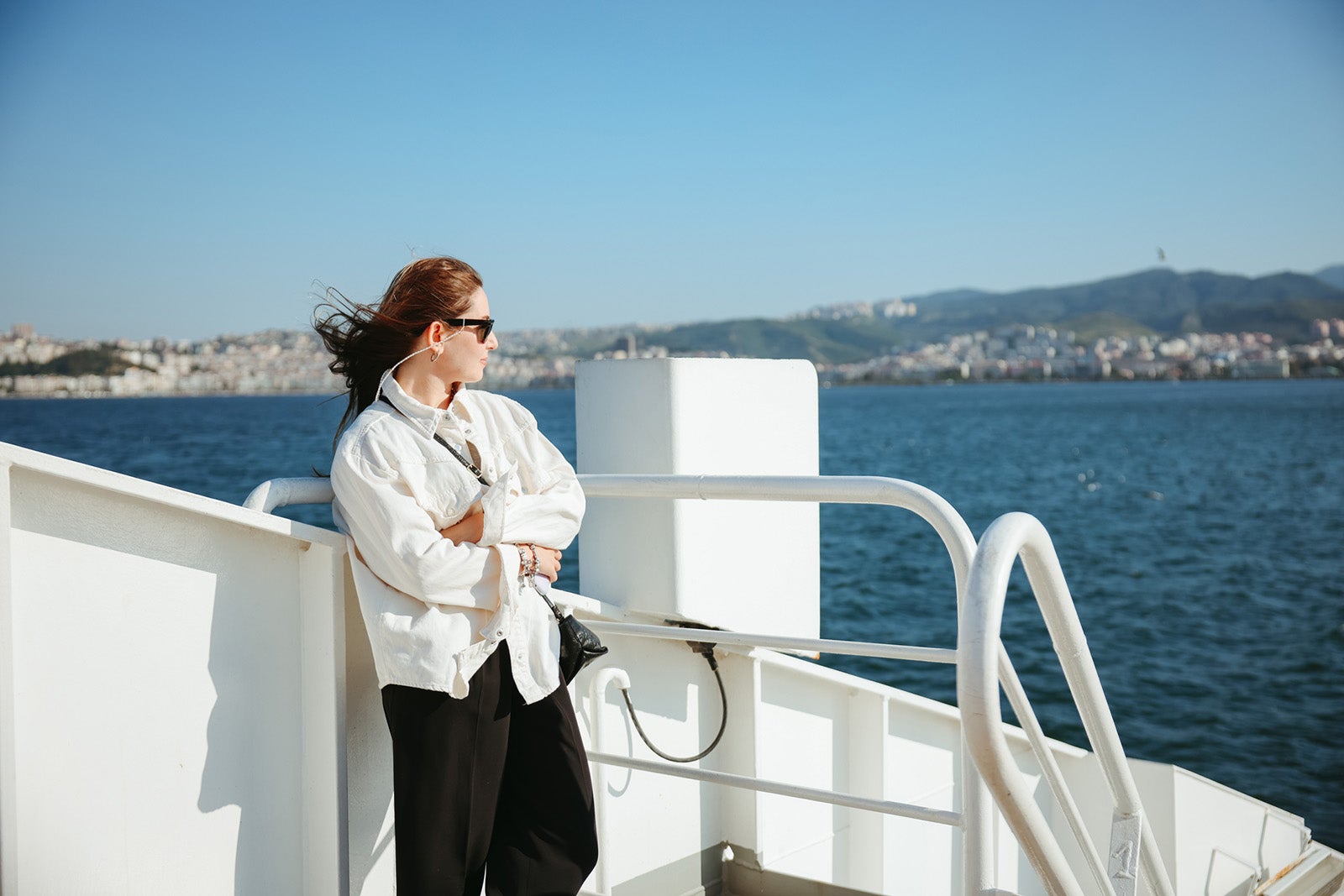
Motion sickness is a possibility on a cruise ship, but don't assume you will experience it on your sailing. Most large ships are stabilized to prevent excessive motion, and the average cruise (especially to popular destinations in the Bahamas and the Caribbean) takes place in calm waters.
Also, some people are more prone to seasickness than others. If you frequently ride roller coasters and don't have trouble on airplanes no matter how turbulent, or if you can sit in the backseat of a car on a winding mountain road, you probably aren't prone to feeling nauseated from movement.
For many people who do feel ill on a cruise, motion sickness is a limited-time event. It might hit you during the first 24 hours of sailing, quickly calming down as your nervous system adapts to the motion. Symptoms might only affect you when the exact set of circumstances appears that disturbs your equilibrium enough to cause nausea. They may then disappear as soon as the ship rights itself, so to speak, or when you head to the more stable lower decks and gaze out at the horizon.
In this case, too, wearing a patch for the duration of the cruise is not warranted.
Still, there are some people who will become ill just reading about rocking ships or turbulent flights and are extremely nervous about heading out to sea on a boat. If that's you, patches for the duration of any cruise are something you might consider.
Related: How to avoid seasickness on your next cruise
Not everyone can use scopolamine patches
The active medication in the patches can interact with some other medications. It's a long list and includes common over-the-counter medications like Benadryl. You, your doctor and your pharmacist should carefully evaluate your potential for medication conflicts if you plan to use motion sickness patches during your cruise.
Also, patches aren't the only seasickness remedy you can try. Some people use over-the-counter medication tablets, such as Dramamine or Bonine. You can also try alternatives to medicine like acupressure bands for your wrists or settle your stomach with foods such as green apples, ginger ale or ginger candies, and crackers.
Related: How to avoid getting sick on a cruise
The patches can have surprising side effects
A motion-sickness patch may look innocuous. However, it is still a prescription medication and can have adverse side effects not to be taken lightly. Consider the possibility of ill effects before you commit to the patch on your next cruise.
For example, I met a woman who put on a patch during her first cruise. She discovered several hours later, as she was putting makeup on that the pupil in one of her eyes was fully dilated — the eye on the side where her patch was placed. She thought she was having a stroke. She contacted her physician, who advised her to immediately remove the patch. The dilation subsided, and all was well for the remainder of her cruise.
She had not experienced any seasickness before using the patch nor after removing it. She had simply taken a proactive approach, just in case. Her medical chart now includes her reaction with a note that she cannot use scopolamine. She does, however, intend to cruise again and hopes her lack of motion sickness on her first cruise will hold true in the future.
Other side effects of the patches include dry mouth, dizziness, drowsiness and even disorientation. Also, a big problem for many cruisers is that you should not consume alcohol while wearing the patch. Doing so intensifies the side effects, especially drowsiness and dizziness.
Related: Do cruise ships have doctors, nurses, medical centers or hospitals?
Patches can be useful in rough seas
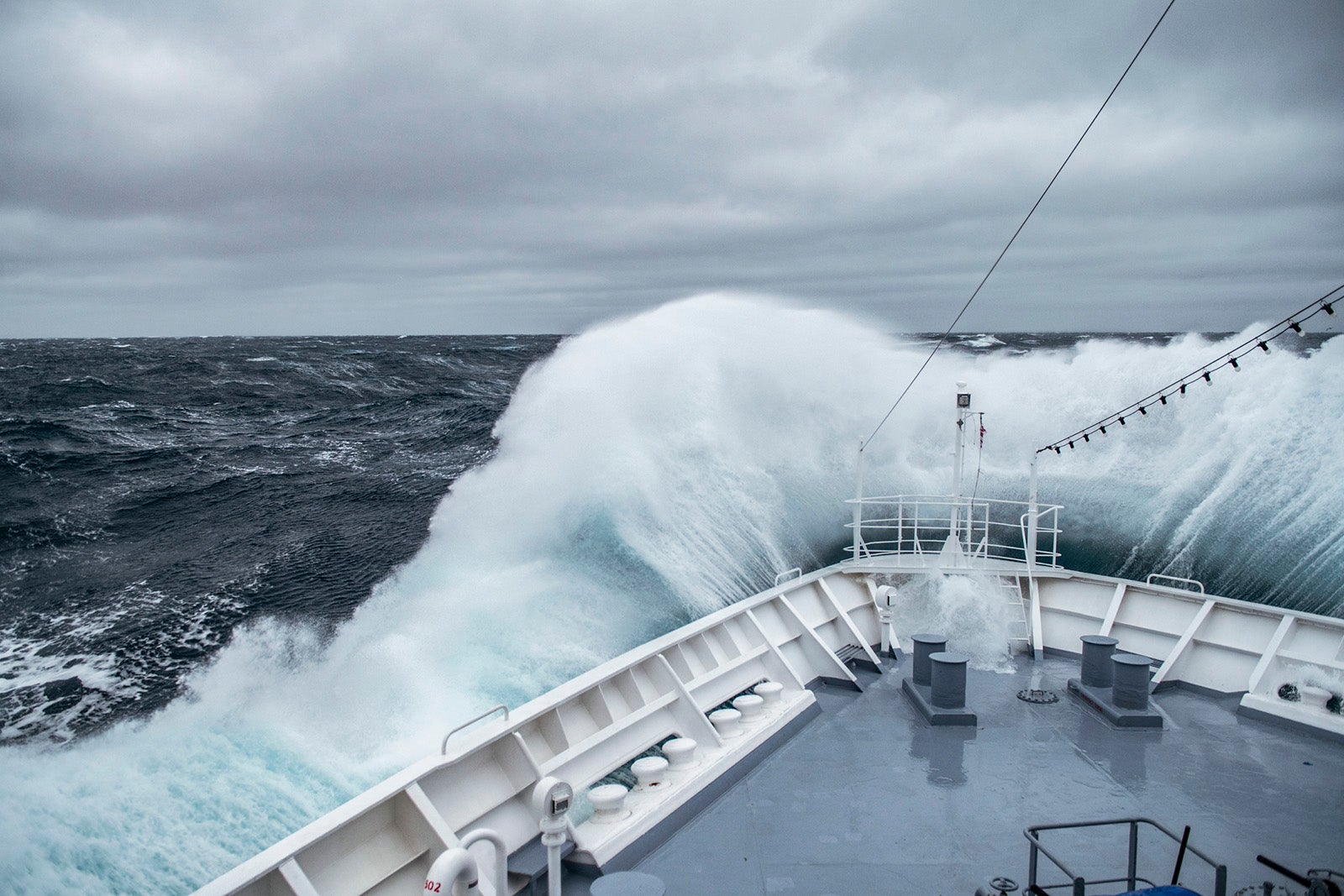
Although ship captains aim to avoid dangerously rough seas, cruise ships are designed to handle far larger waves than one might think. That means choppy rides may occur. You'll know rough seas are ahead when you see motion-sickness bags strategically placed in the stairwells.
Scopolamine patches can be useful on any cruise with the potential for large waves, such as hurricane season sailings, transatlantic crossings and cruises through notoriously rough waters, such as the Drake Passage on the way to Antarctica. If you're nervous about feeling ill during any of these sailings, that is the perfect time to talk to your doctor about a prescription for patches.
Related: What to do if you find yourself on a wildly tilting cruise ship
If you are prone to motion sickness in general, talk to your doctor about prescription patches. My physician said she wouldn't have a problem prescribing the patches for someone going on their first cruise if they don't have conflicting medications or conditions and understand that there are side effects.
There are a few itineraries and seasons for which even the most sea-hardy among us might proactively take along a supply of patches. It's better to be prepared and not need them than to suffer through a rough ride without any relief.
If you have successfully worn scopolamine patches in the past without side effects, consider only wearing one the first 24 hours of the cruise or when rough seas are expected.
Bottom line
If you've never cruised but generally don't experience motion sickness, don't assume you'll need seasickness medication for your first sailing. You might be surprised that a cruise ship's ride is much smoother than you thought.
However, if you're worried motion-induced nausea may sideline you during your cruise, talk to your doctor about the best motion sickness medications before you sail.
Planning a cruise? Start with these stories:
- The 5 most desirable cabin locations on any cruise ship
- A beginners guide to picking a cruise line
- The 8 worst cabin locations on any cruise ship
- The ultimate guide to what to pack for a cruise
- A quick guide to the most popular cruise lines
- 21 tips and tricks that will make your cruise go smoothly
- 15 ways cruisers waste money
- The ultimate guide to choosing a cruise ship cabin

13 Actionable Tips to Prevent and Treat Seasickness on a Cruise
Will you get seasick on a cruise? Maybe! I sometimes do.
I read many guides online that say that you need never worry about getting seasick when cruising, mostly written by people who aren’t normally travel sick .
Will seasickness ruin your cruise? Absolutely not!
Will I Get Seasick on a Cruise?
Some people do get seasick when taking a cruise.
This is more common if the cruise encounters bad weather. Guests who are already prone to motion sickness are more likely to feel seasick on a cruise, although the majority of passengers do not get seasick.
If you do get seasick, there are many ways to prevent and treat it.
I’ve been on over 50 cruises to date and have been seasick on 4 or 5 times. I’ve devised a number of ways to prevent and treat seasickness. These include what I eat, where I sleep, what I wear, and where I cruise.
I think the fact that I carry on cruising despite being one of the most travel-sick people I know says a lot.
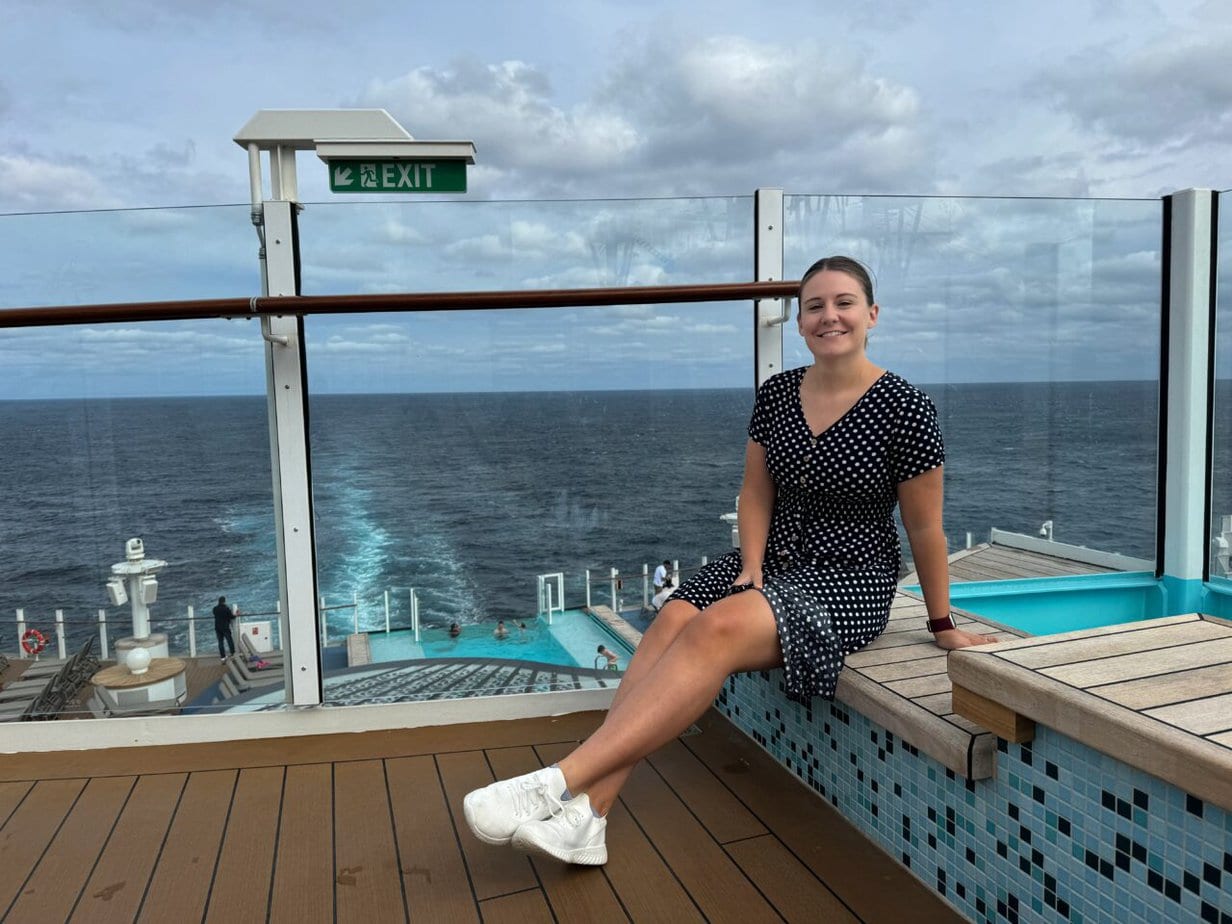
I’m much more likely to get travel sick in a car or coach than a cruise ship. Mum says I could get seasick stepping over a puddle!
Tips to Avoid Getting Sea Sick on a Cruise:
1 – pick the itinerary carefully – avoid a cruise with many sea days.
I rarely go on a cruise with more than two consecutive sea days, this isn’t by accident.
The more sea days you have, the more chance you have of getting seasick. This isn’t just because you’re actually spending more time at sea.
Avoid Transatlantic/Transpacific Itineraries
Cruises with multiple sea days tend to cruise far into open waters, which is usually where bad weather happens.
Transatlantic and transpacific cruises often trigger seasickness in guests and I wouldn’t recommend these for a first cruise if you’re worried about seasickness.
If you are able to pick a cruise with no sea days AT ALL this is a brilliant option. A port a day keeps you busy and also keeps seasickness worries away.
A typical cruise would be docked until around 5/6 pm and arrive early in the morning so by picking a port-intensive cruise you really don’t have that much sailing time.
Some cruises actually visit more than one place a day!
This is rare but I took a cruise with Celestyal which did exactly this. We have one port in the AM and one in the PM. What Celestyal Cruises REALLY Like? – Daily Photo Diary and Review
Avoid Winter Itineraries In Parts of the World Weather is Likely to be Bad
I took a Christmas Cruise from Southampton to the Canary Islands, which travelled through the notorious Bay of Biscay.
With hindsight, this wasn’t a good idea – as we were faced with winter storm after winter storm.
We missed ports, meaning extra sea days, and arrival and departure times on port days were changed
Find out about that Christmas Cruise here:
2 – Stay as Central as Possible With Your Cabin’s Location
If you have the option pick a cabin which is in the middle of the ship.
Cabins in the middle feel less movement than those at the ends. Similarly, if you can pick a cabin on a lower deck this is usually better.
Often times on cruises I’ve found that the theatre and main dining room/buffet are the rockiest places onboard. These are always right at one end of the ship and you can sometimes feel the vibrations from the engine at the back too.
I took a cruise last year on the MSC Meraviglia and when the engine started you really could tell in the main dining room.
We’d be midway through our dinner and then it would start and we would say ‘Oh! we must be off!’
Find out more about the importance of cabin location here:
What is The Best Cabin Location on a Cruise For Avoiding Seasickness? (I’ve Tried Them All!)
Why I don’t follow my own advice on this one: One word, money! I always prioritise money over seasickness.
I often choose a ‘Guaranteed’ cabin which means that you don’t get to choose your cabin location.
It is cheaper to do this but does mean that you are often allocated the ‘leftover’ cabins at the end of the ship or in less desirable locations.
Find out more about that in the article below:
I Always Book Guaranteed Cabins on Cruise Ships – (Photo Examples, Regrets & More)

3 – Treat Yourself to a Balcony Cabin (Or Borrow One)
If your budget allows it, choose a balcony cabin. Being able to open the balcony doors can be a lifesaver if you’re feeling seasick.
I am a big fan of inside cabins and usually cruise in them but when you’re in an inside cabin it is very easy to forget that you’re on a ship at all.
Seasickness is caused by your body being a bit confused, your eyes don’t see any movement but your body feels like you are moving.
For some reason your body decides that the best thing for you is to feel unwell, I assume so that you’ll get out of the situation.
You can’t simply get off the cruise ship so reminding your body why you are feeling the movement by reconnecting with the ocean is a big help.
Borrow Somebody Else’s Balcony
Onboard the MSC Meraviglia, we got caught in a bit of bad weather sailing back from Malta.
I had an inside cabin but was also cruising with my parents who had a balcony cabin.
Being able to go across to their room and sit on the balcony helped me a lot. If you are worried about seasickness, consider saving up for a balcony.
4 – Choose a Mid-Sized Ship
I often see sea sickness-related advice which says that you should choose the biggest ship you can find.
I would disagree with this, some of the newer and bigger ships aren’t designed for ocean travel, they’re designed to have the best facilities onboard.
As a result, the huge mega-ships aren’t always the best for seasickness. I loved my cruise on the MSC Meraviglia but I felt the movement on her a lot more than I have done on some smaller ships.
I would recommend cruising on a cruise ship which contains between 2000 – 4000 passengers. This seems to be the ideal size for me.
New(ish) Ships Are Best
Whatever you do, don’t go for a really old ship. Ships from the 90s or 00’s and later are fine but if you stray much earlier than that you might be more likely to feel seasick.
Stabilisation systems have come a long way in the last few decades. Many older ships have been retrofitted with better stabilisers but if you are worried about seasickness its better to pick a newer ship.
I broke all my own rules and took an “In Search of the Northern Lights” cruise on Fred Olsens Bolette.
The ship was built in 2000, and we were crossing the North Sea in February. I have never felt so sick!
Find out all about that memorable cruise here:
5 – Don’t Overindulge in Food or Drink (But do Eat!)
When cruising, don’t overindulge in food or drink.
This one can be really tricky as for most eating and drinking is one of the most important parts of cruising.
It is much better for you to eat small, regular portions to keep your stomach full but not overeat to the point where you might feel unwell.
Eating particularly greasy or unhealthy foods always increases my chances of feeling seasick.
When I was on P&O’s Britannia, I was sitting in the Beach House restaurant having just finished a massive meal when Captain Wesley made an announcement to warn guests that the sea might be ‘lumpy’.
I knew at this point that I had eaten too much – but it was too late!
I was fine – but still regretted eating all of the Churros and Marshmallows!
Minimising alcohol can be the trickiest part (one or two drinks can actually make you feel better as you stop worrying about feeling seasick…).
On the MSC Meraviglia, I had an unlimited drinks package so tried many beertails. I wasn’t sure if it was the seasickness or the beer making me feel unwell but I always blame the seasickness.
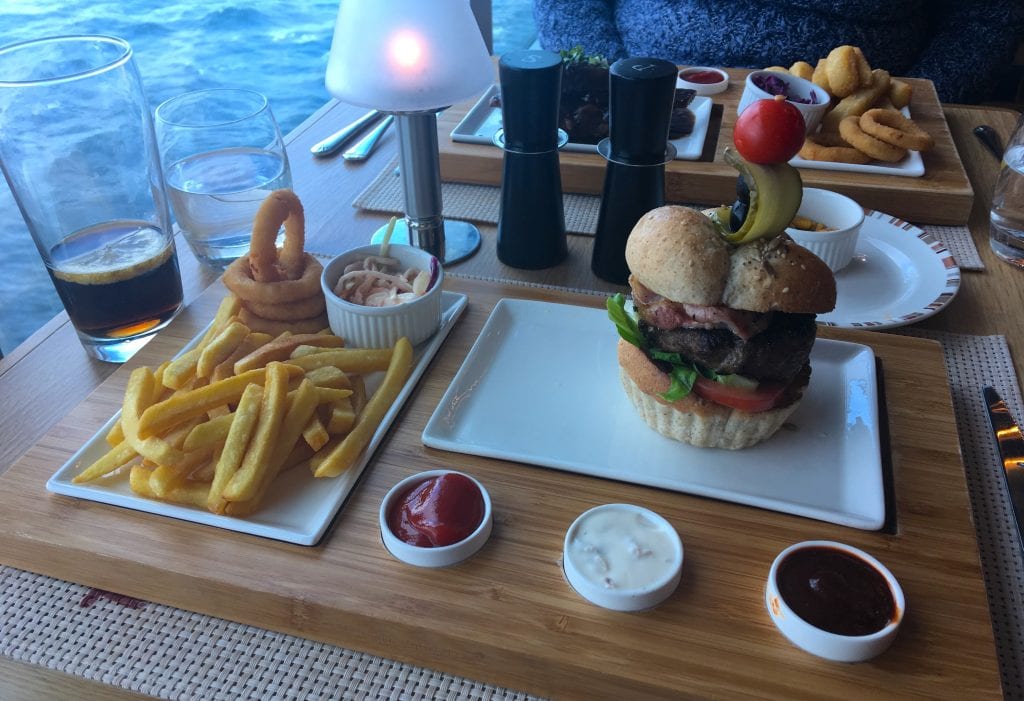
Tips to Treat Feeling Sea Sick on a Cruise:
6 – head outside to find fresh air.
As soon as I feel a little seasick I head straight to the top decks to try and find some fresh air.
A lot of the time this works and I don’t need to follow any other of the steps in this guide.
This works best if you are cruising somewhere which is either windy or rainy. Stepping out into warm air doesn’t help as much as feeling the rain on your face.
Walk a Lap of The Promenade Deck
Not all cruise ships have full promenade decks but I love the ones that do. A lap or two of the promenade deck is usually enough to make me feel better.
Many cruise lines are not building ships with promenade decks anymore because they take up a lot of space.
Cruise lines would generally prefer to keep people spending money inside than walking around in circles on the promenade deck.

7 – Medicate!
If I am still feeling seasick at this point I take seasickness medication.
I usually take Stugeron or Kwells but there are many brands available. Stugeron and Kwells are the only brands that I have found which don’t make me feel too drowsy.
If you are feeling particularly seasick you might want to go to sleep but usually, I don’t.
Is this what everybody else feels like? This is AMAZING! Me, whenever I take seasickness mediciation.
It is definitely worth taking medication if you are feeling that unwell, there is no point struggling through and not enjoying your cruise.
It is worth noting that you can usually get seasickness pills either for free or for a couple of pounds from Reception.
Cruise ship medical centres will also have them, and many offer a seasickness injection for those really struggling with seasickness.
You usually have to pay for the injection and it makes you sleep for quite a while so I wouldn’t recommend this apart as a last resort.

If you do need medical care, you’ll find a fully trained medical team on board along with medical supplies and a medical centre.
To find out more about what happens if you need medical care, including what the cruise lines can and can’t offer, check out this post:
What Happens if You Get Sick on a Cruise? – Simple Step by Step Guide
8 – Sleep it Off
Probably the easiest thing you can do when you feel seasick is to sleep it off. I’ve had many daytime naps when feeling seasick and I usually wake up feeling much better.
Some people find the very slight rocking of the ship to be relaxing.
I’m usually in an inside cabin so I can sleep at any time of day or night. When you’re in an inside cabin and turn the lights off it’s night-time!
9 – Eat Bland, Basic Foods
When I feel seasick, I live on a diet of bread and fruit. Avoid eating heavy meals and definitely, don’t eat anything particularly greasy or fatty.
It’s important not to let your stomach get empty or you’ll end up feeling worse. On occasion, I have felt seasick and decided to take a nap – and I send my brother to the buffet to get snacks for me. Thanks, Max!
The bread shown on the photo below might not look like much but it is SO good.
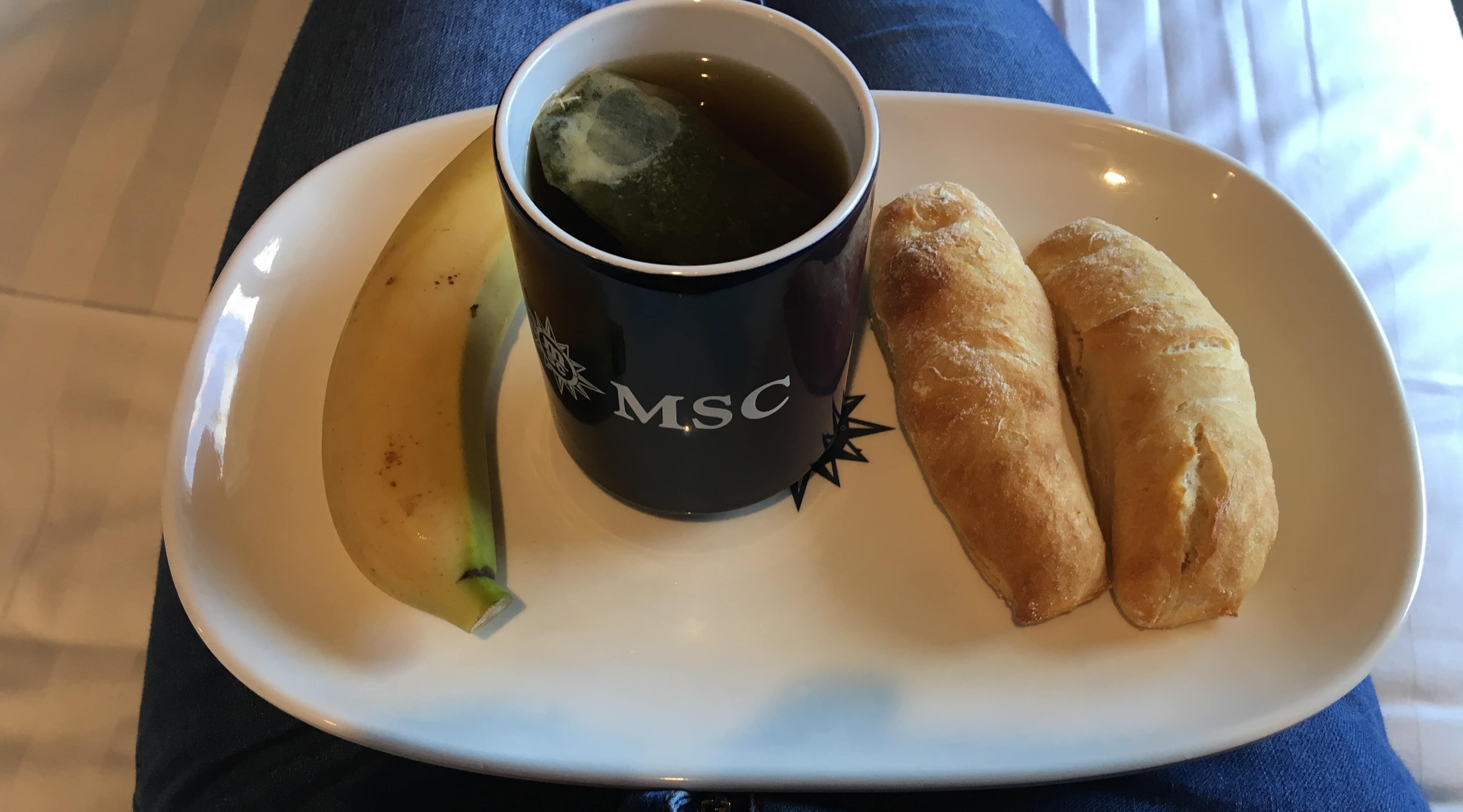
10 – Green Apples & Ginger
I recently heard about eating green apples for seasickness but I thought ‘Hah, that’ll never work’. I’m here to tell you, IT DOES . I don’t know why, or how, but eating green apples really can help with seasickness.
They’re the perfect amount of sweet and crisp to take away that nauseous taste in your mouth. They’re pretty kind on your stomach too so it’s a win all around.
Many people also say that you should eat things containing Ginger. I took this to mean that I should eat ginger biscuits – and I have in the past bought ginger biscuits on long car journeys to try and stop myself from getting travel sick. They also taste great…
I recently bought some ginger-flavoured chewing gum which was meant to have the same effect, I tried one packet and never bought it again, the chewing gum looked like little fish food pellets. Very odd.
Crystalised stem ginger also works and has traditionally been given out on lines in the bygone age, when stabilisers were either not present or much less effective.

11 – Wear a Seasickness Band
I’m not sure if Acupuncture bands actually work – and I don’t know anybody that does.
I do have one and I wear it when I feel like I might get seasick – because I don’t think there is anything to lose by wearing one. Even if it works 1% or works as a placebo, I am happy with that.
The bands work by pressing into the middle of your wrist with a little bump of plastic which sticks out from the band.
It isn’t really uncomfortable but does feel like you’re wearing a tight watch or wristband. They really do indent your wrist.
I remember using one on one of my cruises and I could see the mark for almost a full day afterwards.
You can also buy bands that give you small electric shocks. These are far more expensive.
I have found mine to be a total waste of time as the sensation is worse than the seasickness, so i can’t face wearing it!
It will certainly take your mind off the seasickness though…
12 – Look at The Horizon
If you are feeling seasick, it might be time to put down your phone/tablet and look out at the horizon.
Sitting on a balcony or the top deck looking out to sea can be a really good way to remind your body that you are at sea and that the movement that you are feeling is really happening.
It can be a bit odd sitting in a restaurant or a bar and watching the horizon if you are in bad weather or a storm, the level of the ocean seems to rise and fall.
Despite this, you really don’t consciously feel the movement of the ship very often. It’s our subconscious minds that are the problem!

13 – If All Else Fails Sleep on The Floor (I Did)
In a worst-case scenario sleep on the floor if you have to. On my MSC Meraviglia cruise, I was in an inside cabin, which meant that my bed was going sideways.
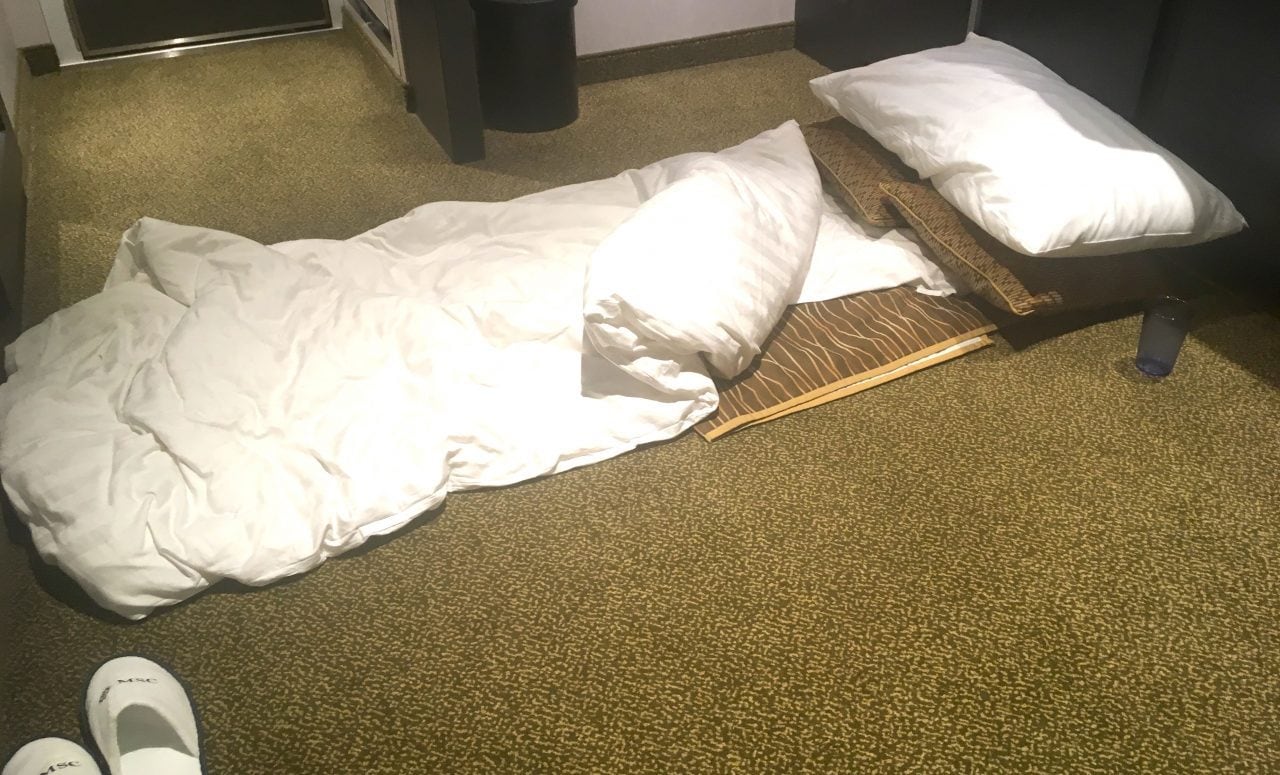
When the ship was moving, I could feel myself going up and down the bed, which was just horrible.
I decided to move my bed to the floor so that I could move side to side, instead of up and down and it was SO much better.
Is Cruising Worth The Seasickness?
I don’t mean to scare you with this post if you are taking your first cruise.
I rarely feel seasick when cruising but obviously had to talk about my seasickness experiences in this post.
I ADORE cruising and I don’t go on cruises assuming that I will be feeling seasick. Even if I do feel seasick, it might be for an hour or at the very most, a day. With the tips in this post, you’ll be prepared even if the worst should happen.
Can You Get Seasick on a River Cruise?
River ships move much much less than ocean ships, there isn’t the constant hum that you get used to on Ocean ships.
River Cruise ships barely move at all, and I have never felt seasick on a river cruise.
River ships often sail at night and spend long days docked in the centre of towns. The travel short differences, compared to Ocean cruise ships.
Find out about the budget river cruise I took onboard Tui Skyla here:
Look at the great range of affordable river cruises Tui offers here*:
*Affiliate link
Before You Go
Find out how to stay healthy when you cruise, and which first aid items to pack “just in case” here:
Staying Healthy When You Cruise, Avoiding Seasickness – Medications and First Aid Items to Pack
Find out about how cruise lines can change their itineraries at short notice to avoid bad weather and rough seas here:
5 Ways Cruise Ships Avoid Bad Weather – and How It’ll Affect Your Cruise

Free Insiders Cruise Line Guide
Ever wondered how the mainstream cruise lines compare? Cruise lines won’t tell you this, but I will.
This FREE guide shows you everything you need to know to find your perfect cruise line.
Enter your email address below:
How to Get Rid of Land Sickness After a Cruise
by Ashley Friedman
Published on 19 Feb 2023
Remedies after a cruise
Causes of land sickness, land sickness prevention, sailors' tricks and tips to get your land legs back.
Disorienting, nauseating and overall unpleasant, land sickness (Mal de Debarquement Syndrome) is the last thing you want after returning from a pleasant cruise. The symptoms will be familiar to anyone who has spent a day ocean swimming and then felt the pull of the current hours after leaving the water.
The feeling of swaying, rocking dizziness and occasional nausea is typically felt by people who have recently returned to land after five or more days at sea. There are a number of remedies and strategies that can help ameliorate symptoms and get you back to feeling like your normal, land-dwelling self.
Typically, symptoms of land sickness last from a few hours to several days. Unlike sea sickness, land sickness doesn't respond to anti-nausea and motion-sickness medications, unfortunately. Instead, doctors recommend getting extra rest, taking long walks and staying hydrated.
In addition, medicines like Valium which have a sedative effect may help until the unpleasant feelings subside. Interestingly, many patients report that motion like driving or walking helps to ease the symptoms of land sickness.
Most people feel a bit of land sickness upon returning to land after days spent at sea. In some cases, however, the condition lingers for days, weeks and even months. The official causes are not known, although a number of theories hold that the vestibular system, responsible for maintaining the body's balance, is disrupted and takes time to reorient itself.
In other theories, researchers believe that it is the brain, and not the vestibular system, that has become accustomed to the swaying, rocking motion of the sea or the ship, and reacts with confusion when the individual steps back onto land. Research has shown that middle-aged women are the most likely sufferers of the ailment.
Some physicians assert that there really is no way to prevent land sickness after getting off a boat. However, some sailors (including many working marines) insist that vigorous exercise while on board is key to preventing land sickness. It may be wise to visit your doctor prior to your trip, and ask for prescriptions that can help with land sickness, should it occur.
Vitamin B and ginkgo biloba have also been touted as useful preventative supplements, but check with your doctor before taking them to make sure they won't interfere with any medicines you're currently taking. Generally speaking, time is the only guaranteed cure for land sickness, so give yourself a day or two of downtime before resuming your normal activities.
- UK and Ireland
- Northern Europe
- Western Mediterranean and Atlantic
- Eastern Mediterranean
- North America
- South America
- Australasia
- South Pacific
- Middle East
- Panama Canal
- Adults-Only Cruises
- All-inclusive Cruising
- Boutique Cruising
- Classic Cruising
- Cruise from the UK
- Expedition Cruising
- Family Cruises
- Fly Cruising
- Luxury Cruising
- Mini Cruises
- Ocean Cruising
- River Cruises
- Small Ship and Yacht Cruising
- Solo Cruising
- Ultra-Luxury Cruising
- World Cruises
- Ambassador Cruise Line
- Carnival Cruise Line
- Celebrity Cruises
- Cunard Line
- Emerald Cruises
- Fred. Olsen Cruise Lines
- Holland America Line
- HX Hurtigruten Expeditions
- Marella Cruises
- MSC Cruises
- Norwegian Cruise Line
- Oceania Cruises
- P&O Cruises
- Princess Cruises
- Regent Seven Seas Cruises
- Royal Caribbean International
- Saga Cruises
- Silversea Cruises
- Viking - Ocean Cruises
- Virgin Voyages
- Amadeus River Cruises
- AmaWaterways
- Avalon Waterways
- CroisiEurope
- Hurtigruten
- Riviera Travel
- TUI river cruises
- Uniworld Boutique River Cruises
- Top 10 Solo Cruise Deals
- Top 10 Exclusive Cruise Deals
- Top 10 Ocean Cruise Deals
- Top 10 Luxury Cruise Deals
- Top 10 River Cruise Deals
- Top 20 Cruise Deals
- Cruise Package Deals
- Partner Deals & Offers
- Offers & Deals
- Competitions
- Fashion and lifestyle
- Culture and history
- Entertainment
- Recommendation
- Ship Reviews
- Food & Drink
- River Cruising
- First cruise advice
- Heroes & Villains
- Captain Profiles
- Godmother Profiles
- Our Opinion
- Ship Visits
- Ship Launches
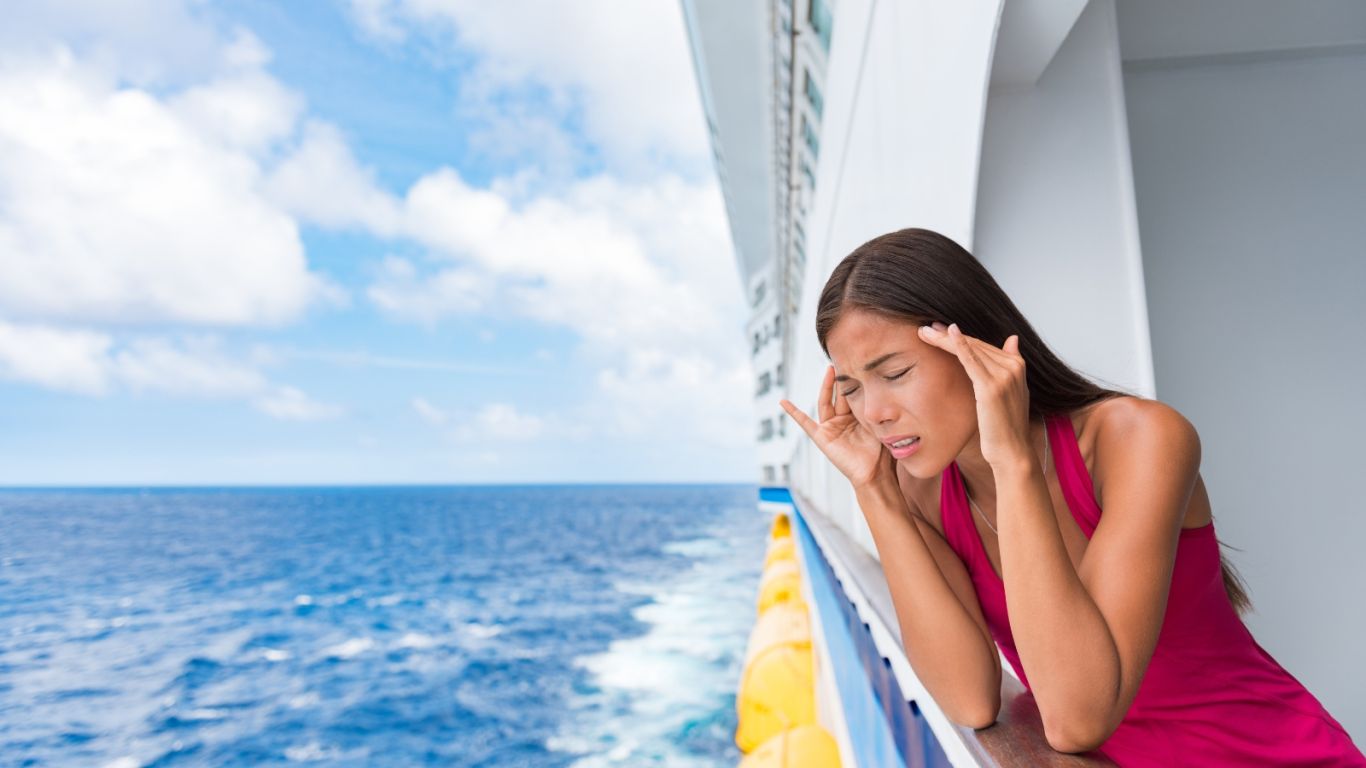
I tried five remedies to conquer seasickness – here's what worked (and what didn't)
Author: Lucy Abbott
Published on: 30 June 2023
Updated on: 30 June 2023
If you're unlucky enough to suffer from motion sickness, don't let that put you off cruising. Lucy Abbott tries five popular seasickness remedies to find out what really works
Cruising is a brilliant way to holiday, so don't let seasickness hold you back from hopping onboard a ship – big or small.
I – ironically enough as a cruise journalist – suffer from seasickness, so I've had to get creative with how I tackle it when onboard.
In fact, lots of people tend to feel a little queasy when sailing, with a survey by Yachting World finding that 62% of people suffer from seasickness, when surveying the 223 participants from the Global Challenge race.
And take it from me, seasickness is something that you can beat by finding what works for you. Although I've listed five different remedies below, test a few different methods and even combine a few to find your winning combination or method.
As a disclaimer, this is not official medical advice, this is simply what works for me. For any further advice contact your local pharmacist.
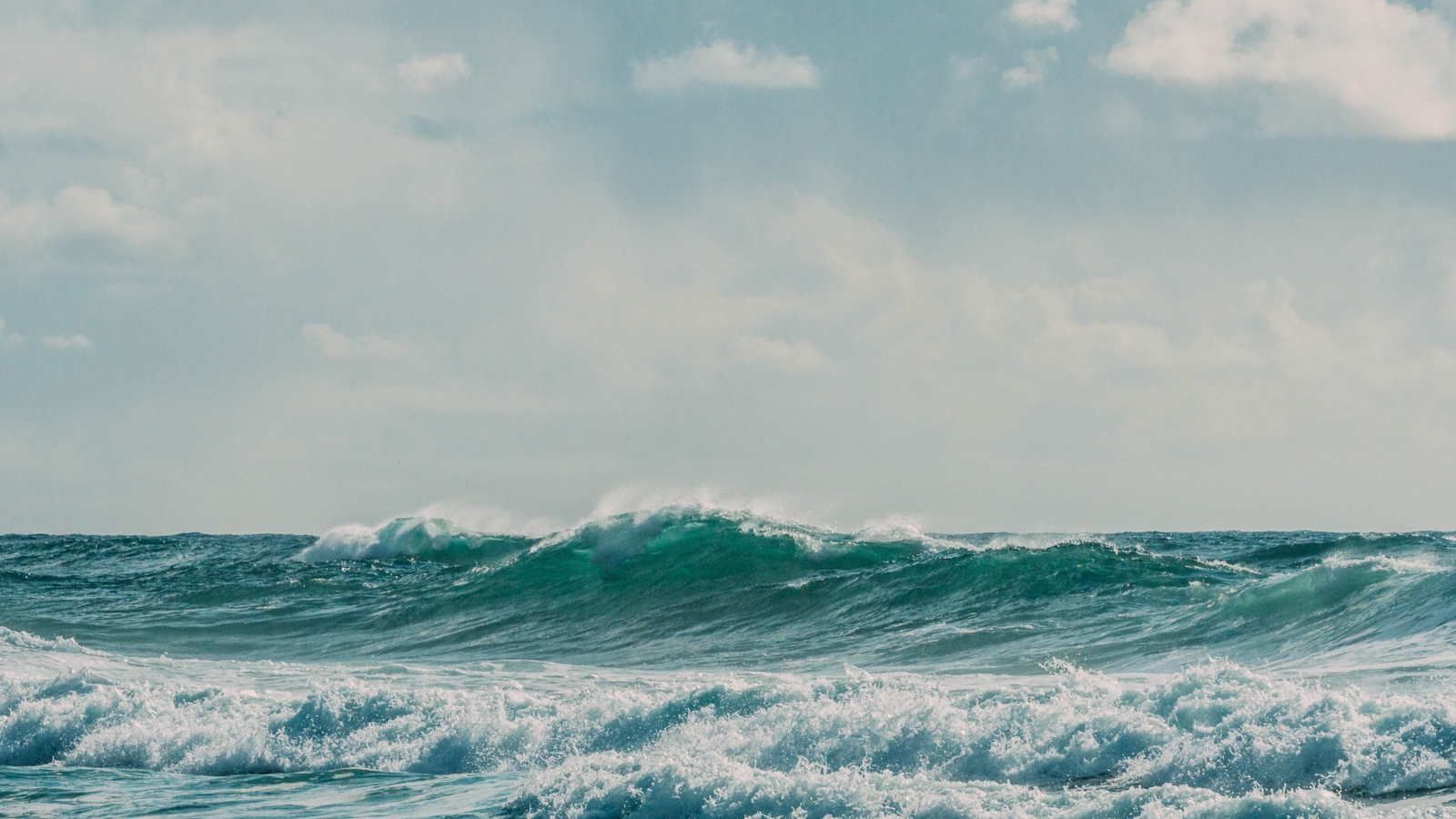
What is seasickness?
Seasickness affects everyone differently – hence there is no 'one-fits-all' solution.
This type of motion sickness is caused by repeated movements, such as a swaying movement felt occasionally when onboard a cruise ship, which causes confusion between the signals that the inner ear is sending to your brain from what your eyes are seeing – and it's this confusion of signals which cause you to feel unwell.
Yet many people may feel one, or all, of these common symptoms, as outlined by the NHS website:
- Feeling sick (nausea)
- Feeling cold and going pale
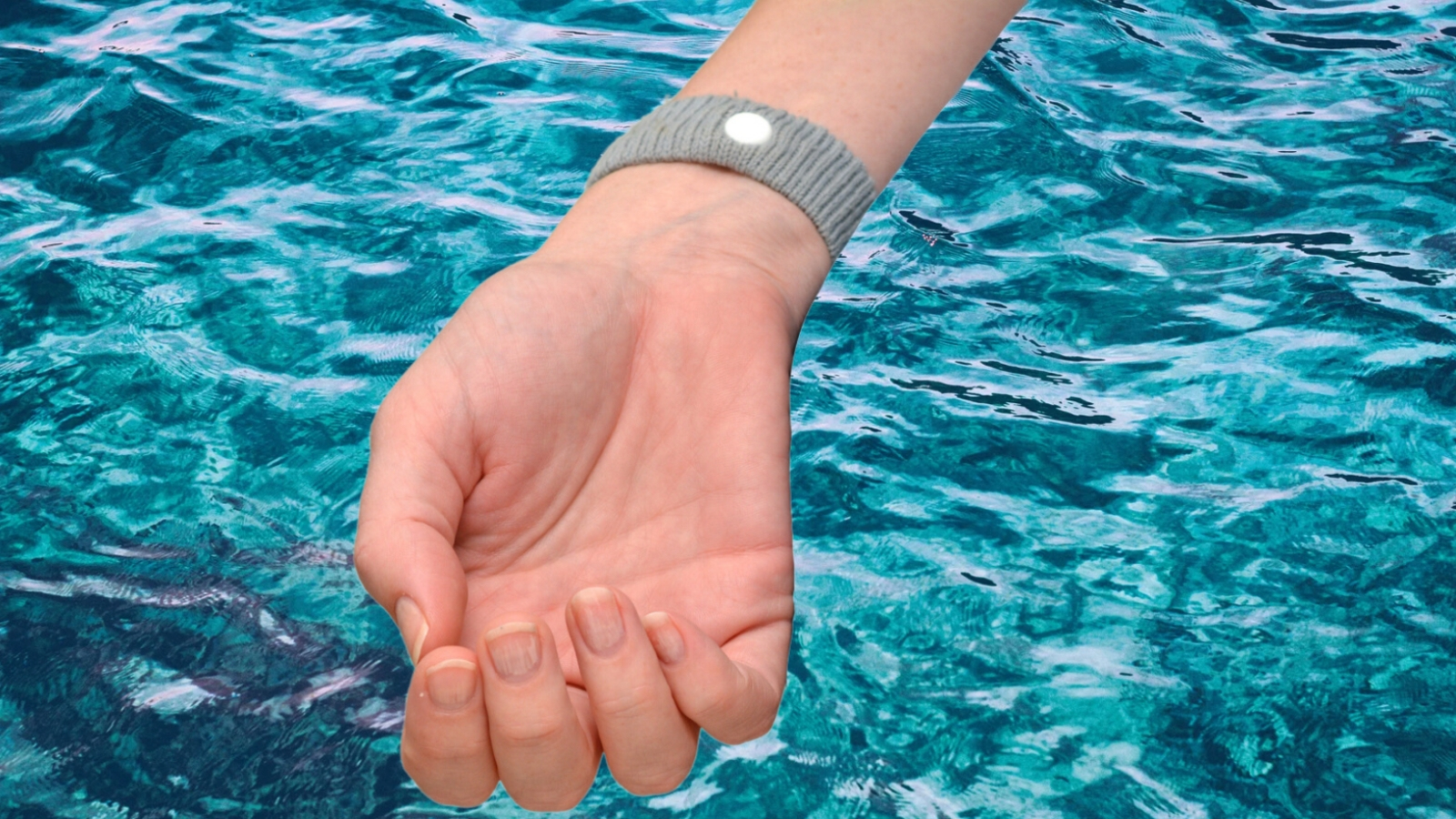
Remedy one: Seasickness wristbands
These handy seasickness-tackling wristbands are perhaps the most creative solution to seasickness.
Targeting your P6 point (which is located on your inner forearm just below your wrist), these bands put pressure on this point using a small plastic ball, which interrupts the nausea signals between your brain and stomach.
In fact, this practice stems from Chinese acupuncture practices – founded in the 1980s by Doctor Daniel Choy, who was onboard a vessel with a seasick crew. According to Choy's account, he asked the crew to press the P6 point on their inner wrist and the nausea subsided immediately.
In my experience, they are relatively effective. Interestingly, I find that they work very well in cars, but with the constant motion of a cruise ship, the effect can wear off.
And this is because the typical effectiveness of seasickness bands only lasts for up to 48 hours. So, if you're on a sailing for longer than a few days, then you might need to find different means to reduce sickness.
I also found that the seasickness bands aren't the most attractive accessory on a formal night onboard a cruise ship – so unless you are willing to bedazzle your bands, it might be worth turning to a different method.

Remedy two: Fresh ginger and lemon tea
It's simple and relatively cheap, fresh ginger and lemon tea has been proven to be effective in cases of mild motion sickness.
The magic is in the ginger specifically, which has the power to help to stable your digestive function (so food doesn't stay in the gut for as long) and stabilise your blood pressure – which helps with reducing nausea.
I can personally vouch for this method, as whilst on particularly choppy waters on the coast of Norway, one cup of this tea alleviated my symptoms within 10 minutes.
Other ginger alternatives include ginger chew sweets, which are a more transportable option as opposed to a hot drink.
When relying upon this method on a normal sea day when I didn't already feel sick, I'd start my day with a fresh ginger and lemon tea and then top up with ginger chews if I started to feel the movement of the waves.
Overall, I think this method is best used combined with one of the other motion-sickness alleviation techniques mentioned – I wouldn't rely on it by itself.

Remedy three: Fizzy drinks
We all love them, and now here's a legitimate excuse to drink them.
Whilst much like the ginger and lemon tea, I would only use this method in conjunction with another one, it still proves effective relief from sickness.
And fizzy drinks have this effect through their carbonation, which helps to reduce the acidity in the stomach, therefore helping alleviate nausea.
In fact, if you want to get technical, the PH of the likes of Coca-Cola resemble the natural gastric acid of the stomach, which aids fibre digestion.
But you can have any carbonated drink to hand – whether this is sparkling water or a glass of Sprite, with the ease and transportability being massive benefits of this method.
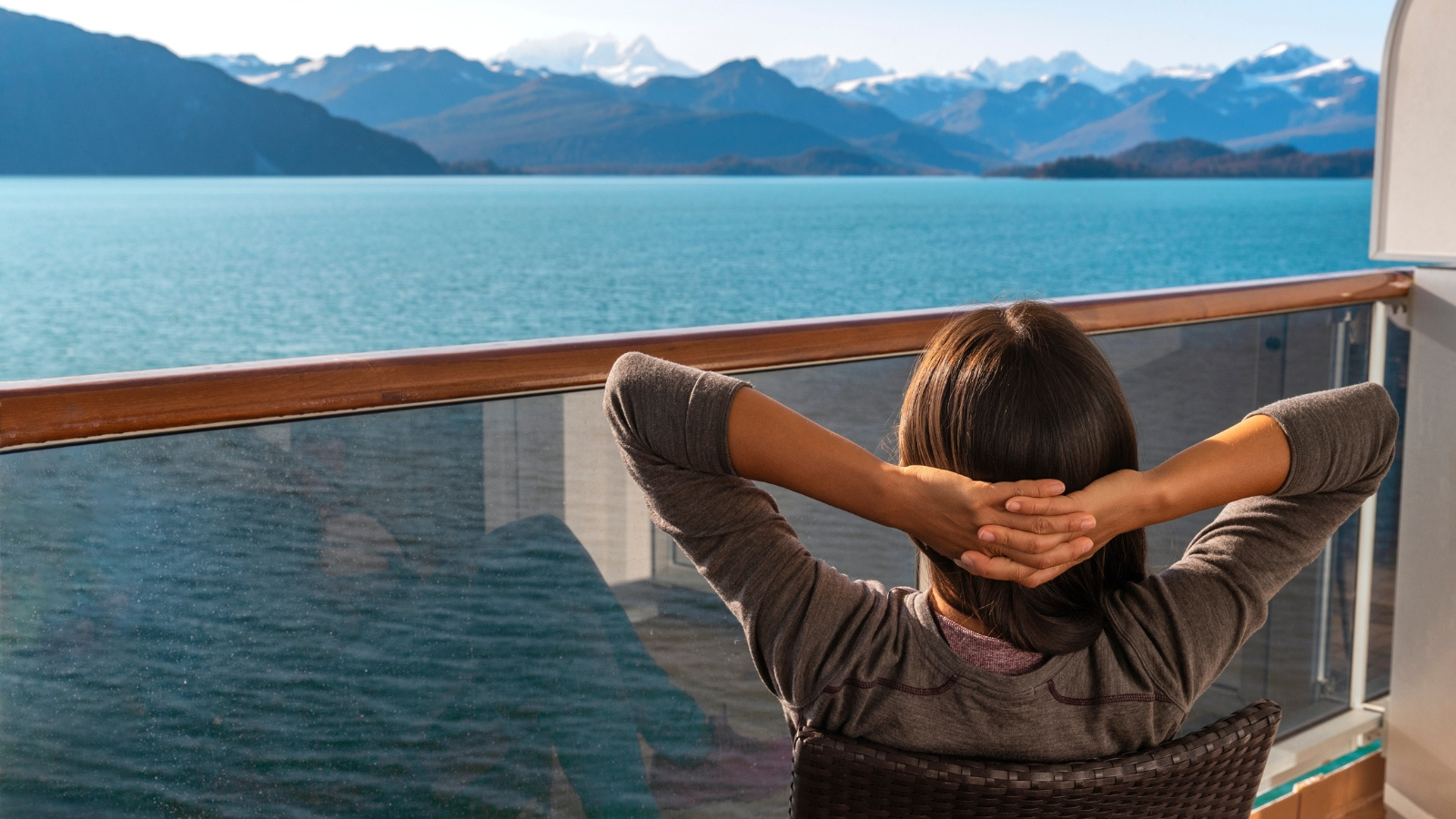
Remedy four: A mid-ship balcony cabin
I found that throughout my travels, the location of your cruise cabin is vital to how much you can feel movement throughout the ship.
For me, the best position to be in is the middle of the ship on a lower deck and in a cabin with a balcony.
This location means that you are less likely to feel the swaying movements of the ship, and you have quick access to fresh air – which is also a great way to help with travel sickness.
But if you don't have a balcony, perhaps map out the quickest way to get out on the deck and ensure you face the direction of travel – I like to focus on the horizon to get rid of any motion sickness.
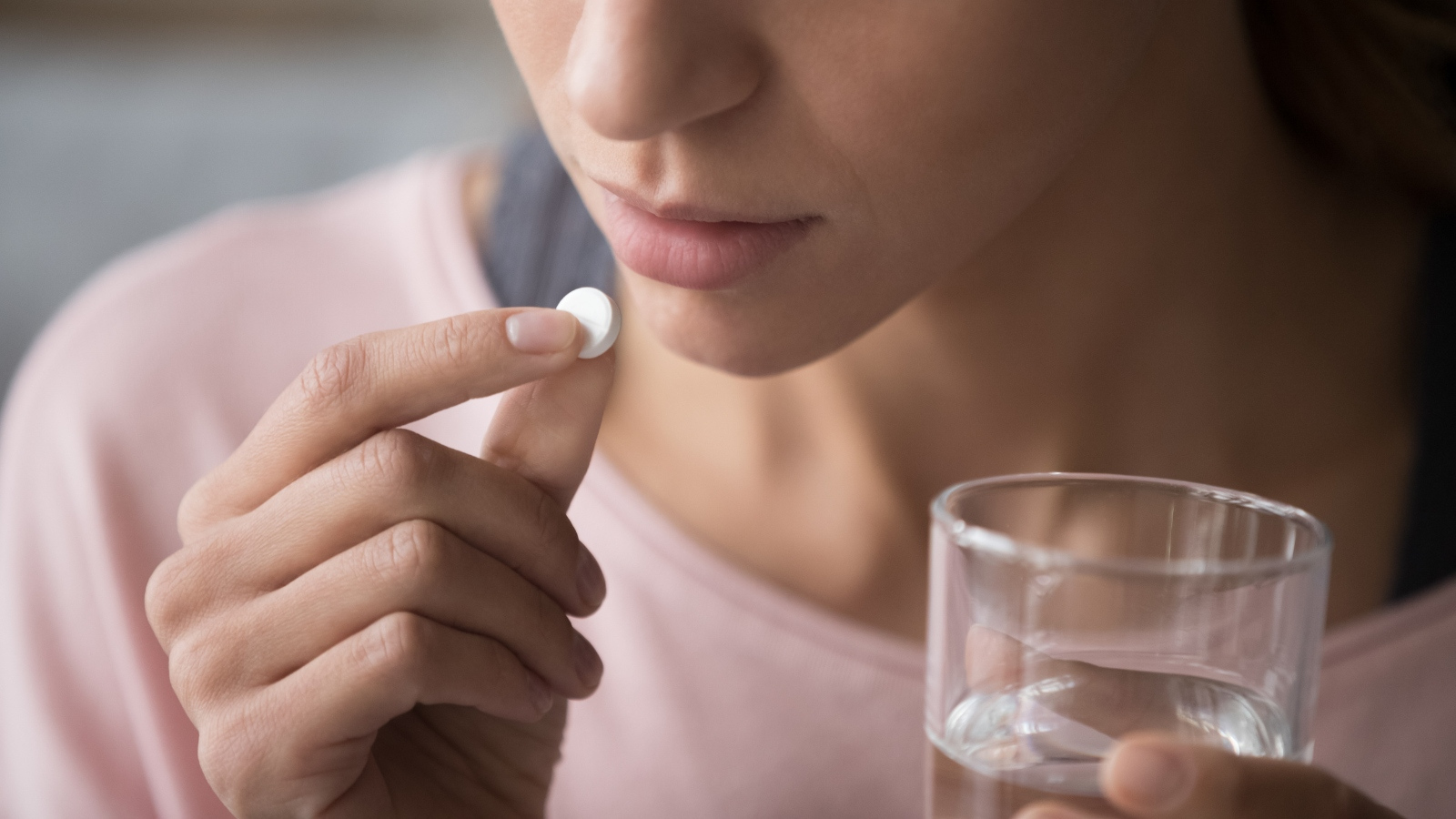
Remedy five: Seasickness tablets
For me, motion or travel sickness tablets from my local pharmacy work best to tackle seasickness.
My top tip would be to ensure that you take your tablets the recommended time before setting sail, to knock any nausea in the bud before it has the chance to start.
So, take note of the sail away times from the port and plan accordingly.
Visit your local pharmacist and ask for their recommendation as the type of motion sickness tablets you take can depend on other medications you are currently taking – but I find that the Stugeron or Boots own-branded travel tablets work a treat.
Happy sailing.
Follow us on social media
First celebrity cruises passengers visit perfect day at cococay, ncl marks milestone with float out of norwegian aqua, hannah waddingham christens sun princess, heaven on the high seas: tom parker bowles on his p&o cruises' voyage, atlas ocean voyages announces 2025-26 antarctica season, cunard takes delivery of new ship queen anne, australian traditional owners announced as godparents of seabourn pursuit, choose your perfect cruise with world of cruising, record-breaking number of brits took a cruise in 2023, viking announces new mongolia extension for china voyages, about lucy abbott.
Lucy is a cruise journalist who has sailed on a variety of ships, from expedition to river – with her favourite being expedition cruising.
Lucy is interested in new sustainable ways to cruise as well as how cruising is becoming accessible for all.
She works together with Kaye Holland to keep the World of Cruising website up to date with all the latest cruise news.

- nights, departs on the 26 Apr 2024
- Regent Seven Seas Cruises, Seven Seas Splendor
Lush Islands In Spring
- 14 nights, departs on the 31 Mar 2024
- Miami, Florida, , , + 12 more
- Regent Seven Seas Cruises, Seven Seas Navigator
Asian Wonders & Arabian Delights
- 20 nights, departs on the 05 Apr 2024
- Laem Chabang, Laem Chabang, Ko Samui, + 18 more
- Regent Seven Seas Cruises, Seven Seas Explorer

- Cruise Advice
Seasickness on a Cruise: 7 Tips to Avoid It

Doug Parker
- June 23, 2023
Those that struggle with motion or seasickness don’t have to stop going on cruises! With our 7 helpful tips you’ll get to enjoy a weekend out at sea all you want.

Before we get into it, let’s start by defining the term motion sickness – just what causes it?
Seasickness happens when your brain gets conflicting messages from your inner ears, eyes, and sensory nerves. Your inner ears help with balance by detecting motion while your eyes don’t see that movement. It’s that inconsistency that confuses and agitates your brain.
And while some people are more prone to seasickness than others, it’s still something that could ruin your boat trip. So, check out how you can stop that from happening.
1. Choose the Right Cabin
Picking the right cabin to stay at goes a long way in balancing out your seasickness. We’ve found that the best cabins to book from are those present on the middle or lower deck.
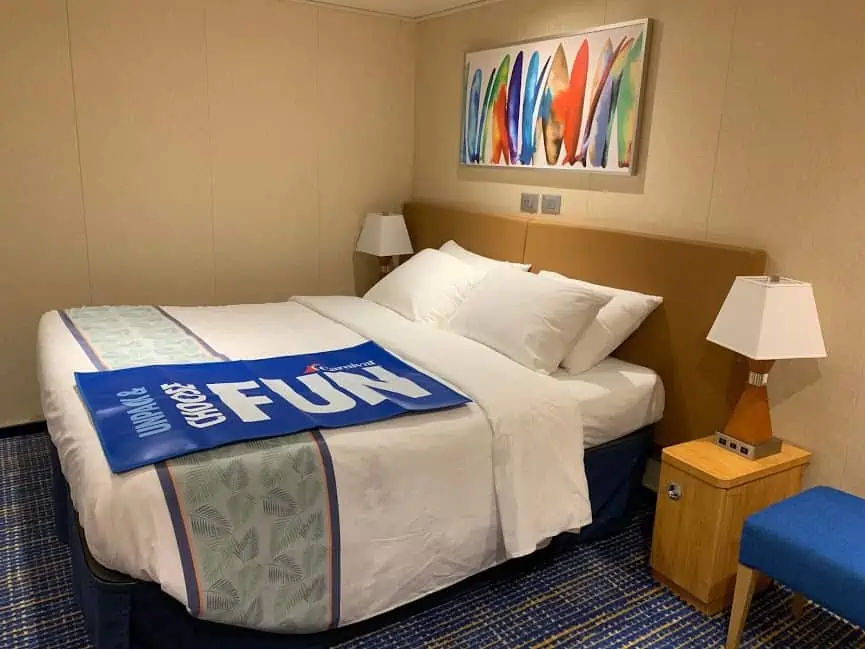
Mid-Ship Cabins
Book a mid-ship cabin to experience the least amount of motion on board. Cabins near the front or back of the ship are more prone to movement, making it harder for travellers prone to seasickness.
So, to avoid this, consider the mid-ship cabins, which provide a smoother ride since they are in the centre of gravity on board. You may also upgrade to a balcony room. Those provide both fresh air and natural light that can help reduce nausea while giving stunning sea views.
Lower Decks
Choosing a room on the lower decks can significantly reduce the rocking sensation and help prevent seasickness. If your motion sickness is particularly horrible, pick a cabin in the middle of the lower deck. Such cabins experience the least movement and are as stable as it gets.
Read more: Motion Sickness: Picking the right cabin, itinerary, and cruise ship
2. Take Motion Sickness Medication
When it comes to meds, you have the choice to pick from the following:
- OTC medication
- Prescription meds
- Acupressure wrist brands
Below, we cover each point in further detail to help you figure out the best course of action for your seasickness.
Over-the-Counter Medication
Ginger supplements are a popular natural remedy for motion sickness. They can be capsules or chewable tablets, which you can buy in most drugstores and health food stores. Ginger helps alleviate nausea and vomiting, making it a practical option for those prone to seasickness.
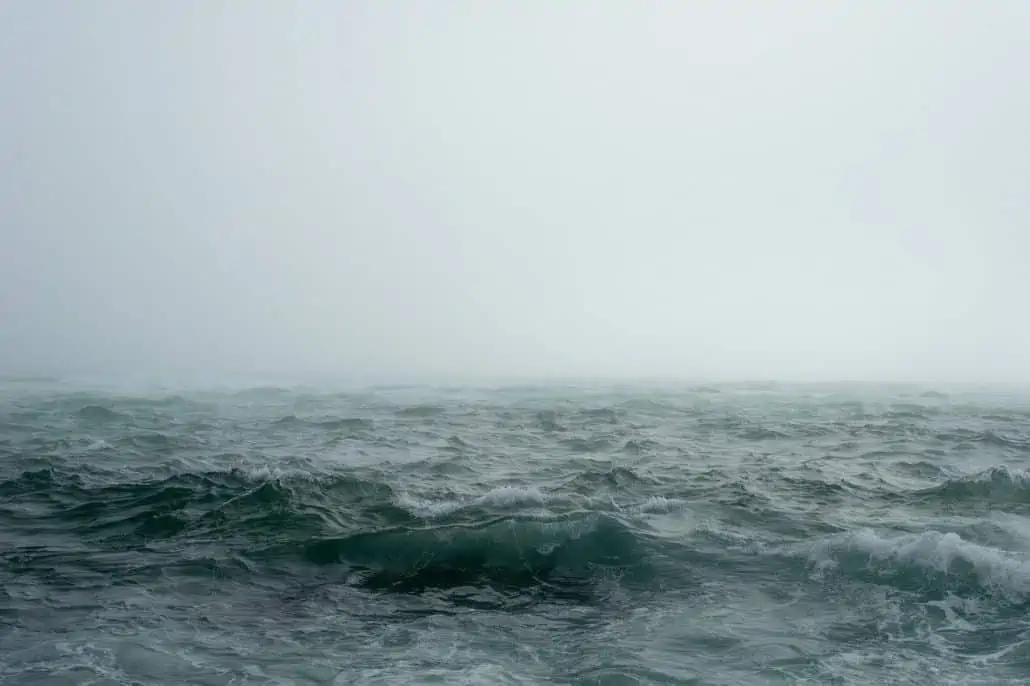
Consider antihistamines, such as Dramamine and Bonine, as well. They block messages between the inner ear and brain that cause nausea and vomiting.
They’re even considered among the best motion sickness medicine for cruises. However, they may cause drowsiness or other side effects .
So, it’s important to follow the recommended dosage instructions carefully – taking more than what’s prescribed won’t increase effectiveness and can only lead to unwanted side effects.
Bonine vs Dramamine
The formula composition of both Bonine and Dramamine is the main difference between either drug. While the two are effective in reducing your motion sickness, Dramamine can make you more drowsy than Bonine.
That’s because Dramamine contains dimenhydrinate – which while works more quickly, will cause more drowsiness. On the other hand, Bonine contains meclizine, which provides long-lasting effects and is associated with less drowsiness.
Additionally, meclizine stays in your body for up to 24 hours so you can enjoy the cruise to its fullest. Dimenhydrinate lasts in the body for no more than 4 to 6 hours, though.
When to Take Dramamine Before Cruise?
If you insist on taking Dramamine, know that the medication takes at least 30 minutes to 1 hour to kick in.
As such, it’s recommended that you take it an hour or so before boarding the ship or taking on an activity that triggers your motion sickness. Once you feel your symptoms alleviating, you can proceed to take Dramamine as directed on the packaging.
And if you were to take Dramamine after your motion sickness has taken effect, it’ll still take 30 minutes to an hour before you feel any relief.
Prescription Medication
If over-the-counter medication isn’t working for your motion sickness, then prescription medication may be the answer.

Scopolamine patches , for instance, worn behind the ear, can help prevent nausea and vomiting caused by motion sicknesses. Discuss all options with your doctor before deciding on prescription medication for seasickness relief during your cruise vacation.
Keep in mind also that seasickness medication can be pricey depending on what brand and type you go with. So before travelling, check discount vouchers at Boots and get the best travel sickness medicines.
Use Acupressure Bands
Acupressure bands are a great way to combat seasickness on a cruise ship. These bands use pressure points on the wrist to alleviate nausea and dizziness caused by motion sickness.
They stimulate the body’s natural healing processes, making them a practical, drug-free solution for seasick people.
While there is limited scientific evidence of their effectiveness, many people find them helpful as a non-invasive alternative to medication.
Look for acupressure bands at drugstores or online retailers. They fit comfortably around your wrist and have adjustable pressure settings. It’s essential to wear them before you begin feeling symptoms of seasickness though, so be sure to put them on before setting sail.
Where to Buy Acupressure Bands?
You can buy acupressure bands at Amazon or Walmart, which offer competitive pricing options, and at pharmacies, such as CVS or Walgreens. Specialty stores like REI or outdoor supply shops may also sell acupressure bands.
It’s important to note that not all acupressure bands are the same, so do your research before purchasing. Double-check reviews and ratings from customers who have used the product before.
4. Stay Hydrated
Drinking plenty of water throughout the day can help prevent dehydration, which can worsen motion sickness symptoms.
So, be sure to carry a refillable water bottle and take frequent sips—especially if you’re spending too much time in the sun or participating in activities that make you sweat.

Additionally, limit your intake of alcoholic beverages to avoid seasickness on a cruise. Alcohol can dehydrate you and amplify the effects of motion sickness, making it more likely for you to feel unwell.
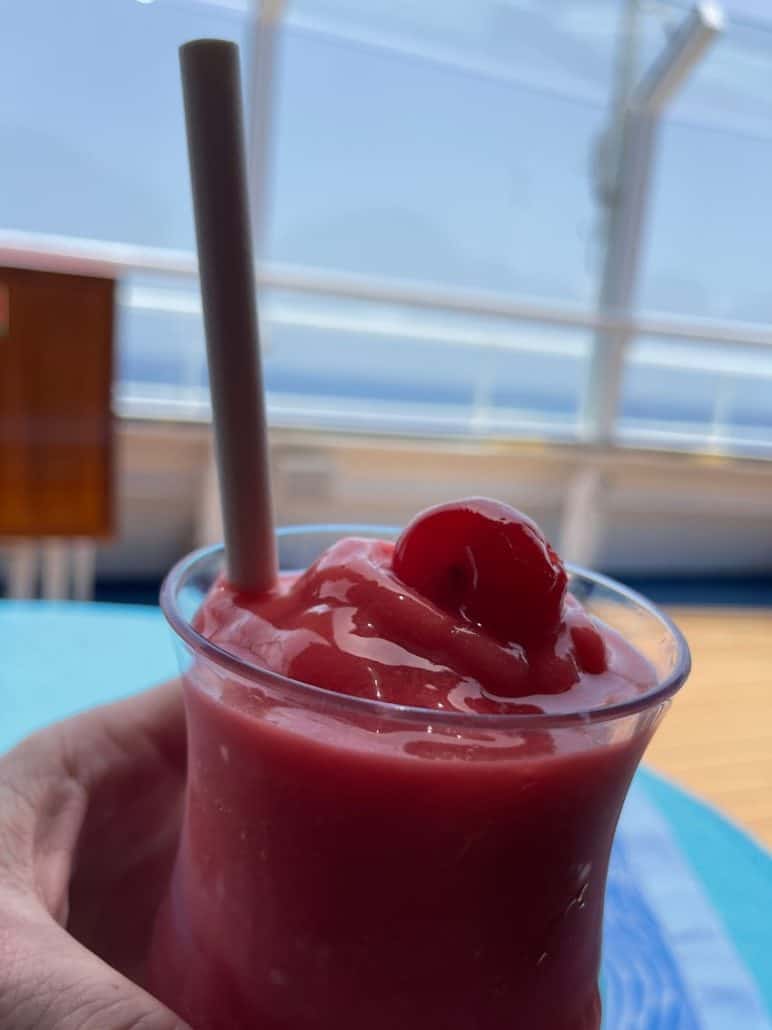
Avoid energy drinks that contain high levels of caffeine as well. These glasses can raise heart rate and blood pressure, triggering symptoms such as nausea, dizziness, etc., making it difficult to enjoy your time at sea.
Opting for plain water with electrolytes added – like coconut water – will keep your hydration balanced without causing unwanted side effects.
5. Eat the Right Food
Eating the right foods is one of the best ways to avoid seasickness on a cruise ship .
Stay clear of heavy, greasy meals that can upset your stomach and make you more susceptible to motion sickness. Instead, stick to lighter fare, like fruits, vegetables, and lean proteins.
Don’t stop there; keep eating small meals throughout the day. Doing so will help keep your blood sugar levels stable and prevent feelings of nausea or dizziness.
Consider snacking on crackers or hard ginger candy for extra stomach-soothing goodness between larger meals.
6. Get Regular Fresh Air
Take a break and head up to the deck for some fresh air. Breathing in the salty sea breeze can help alleviate seasickness symptoms and provide a calming effect.
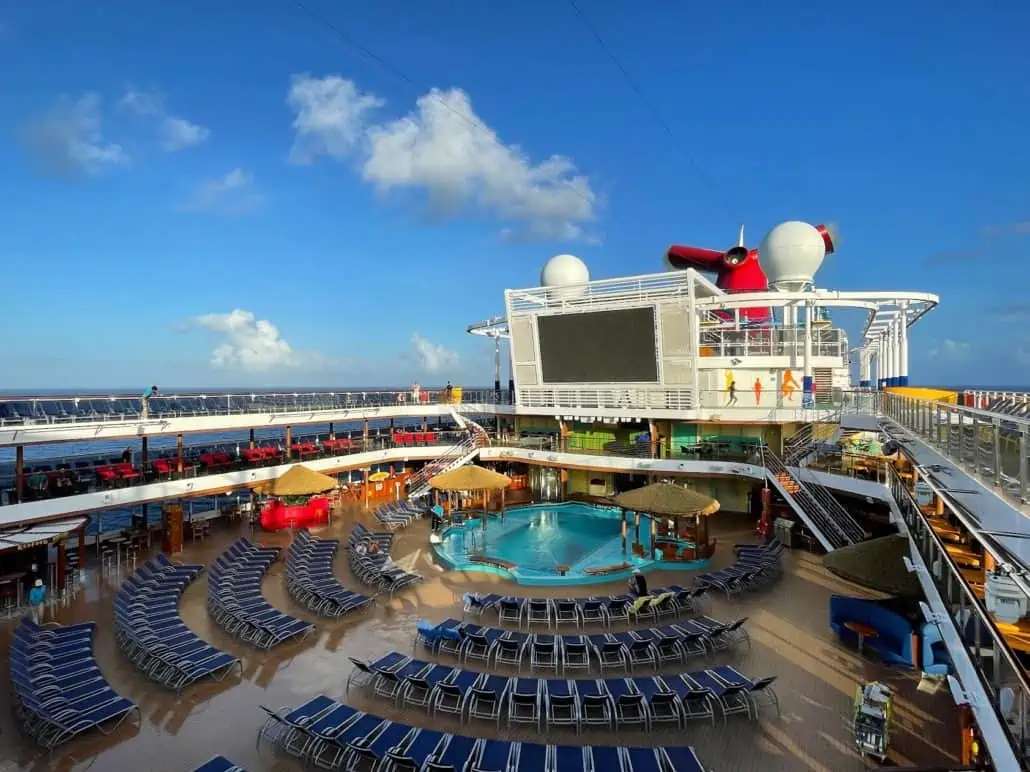
If it’s too windy, try finding a sheltered spot where you can feel the breeze without being exposed to strong gusts.
7. Consider Natural Seasickness Remedies
Remember that old saying about an apple a day can keep the doctor away? While that might not be true, eating apples can alleviate seasickness—but not just any apple, though.
Look for green Granny Smith apples; their pectin combined with natural sugars reduces acid and settles topsy-turvy stomachs.

Peppermint is also known to have the same effects against seasickness. If you’re lucky, you might find some cruise line sundry shops selling peppermint oil.
At the end of the day, cruisers have little to lose by trying out some of these natural solutions for seasickness before taking medication. Their low cost and ease of access are appealing.
Final Thoughts
Don’t let motion sickness keep you from experiencing what the cruise ships offer!
Just remember to stay hydrated, avoid heavy meals, and take preventative medication if necessary to avoid seasickness on a cruise.
The U.S. Centers for Disease Control also lists more tips and remedies to help avoid motion and seasickness .
Medical Disclaimer: This article is not a substitute for professional medical advice, diagnosis, or treatment. Always seek the advice of your physician or other qualified health providers with any questions you may have regarding a medical condition.
Pin it for later!

Recent Posts
Carnival jubilee 2024 review + cruise news [podcast], cruise passenger could face 12 years in prison after arrest in grand turk, royal caribbean cancels alaska cruise, guests must vacate by sunday afternoon, sun princess’ new godmother, hannah waddingham, has one very important tip to share with cruisers, share this post, related posts.
![seasickness after cruise Carnival Jubilee 2024 Review + Cruise News [Podcast]](https://cruiseradio.net/wp-content/uploads/2024/02/carnival-jubilee-mahogany-bay-300x200.jpg)
Florida Man Faces Staggering $143,000 Phone Bill Following Vacation

Carnival Firenze Gets an Italian-Style Christening at Long Beach

Bringing you 15 years of cruise industry experience. Cruise Radio prioritizes well-balanced cruise news coverage and accurate reporting, paired with ship reviews and tips.
Quick links
Cruise Radio, LLC © Copyright 2009-2024 | Website Designed By Insider Perks, Inc

Bon Voyaged
25 Things You Should NEVER Do On A Cruise
Posted: April 28, 2024 | Last updated: April 28, 2024
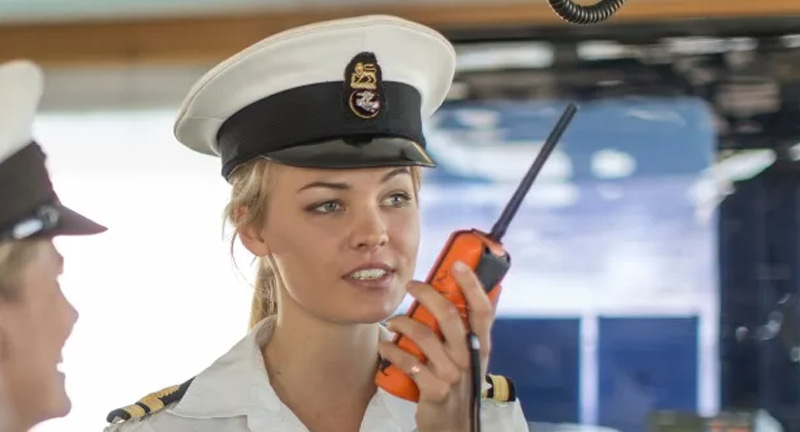
Embarking on a cruise is an exciting adventure, offering a unique blend of relaxation, exploration, and entertainment. However, to ensure that your voyage is as enjoyable and trouble-free as possible, there are certain practices and behaviors to avoid. In this guide, we will navigate through 25 crucial things you should never do on a cruise. From safety protocols to social etiquette, these tips will help you make the most of your time at sea. Whether you’re a first-time cruiser or a seasoned traveler, being mindful of these points can greatly enhance your cruising experience.
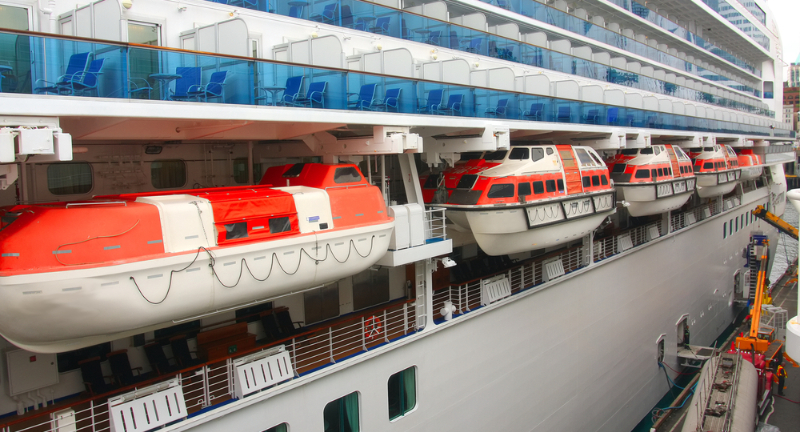
Ignoring Safety Drills
Cruise ships conduct mandatory safety drills, often before departure. Skipping these drills means missing vital information about emergency procedures and evacuation routes. It’s essential for your safety to attend and pay close attention.
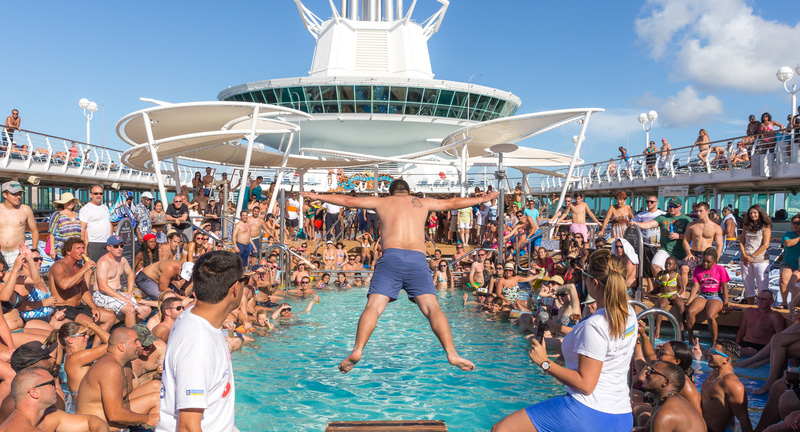
Overindulging in Alcohol
While it’s tempting to enjoy unlimited drinks, excessive alcohol consumption can lead to dangerous situations. Overindulgence can impair judgment, leading to accidents or unwelcome behavior. Moderation is key to ensuring a pleasant and safe experience for everyone.

Disrespecting Crew Members
Crew members work tirelessly to ensure a smooth and enjoyable experience. Treating them with disrespect not only dampens their morale but can also affect the quality of service you receive. Remember to treat them with kindness and respect.
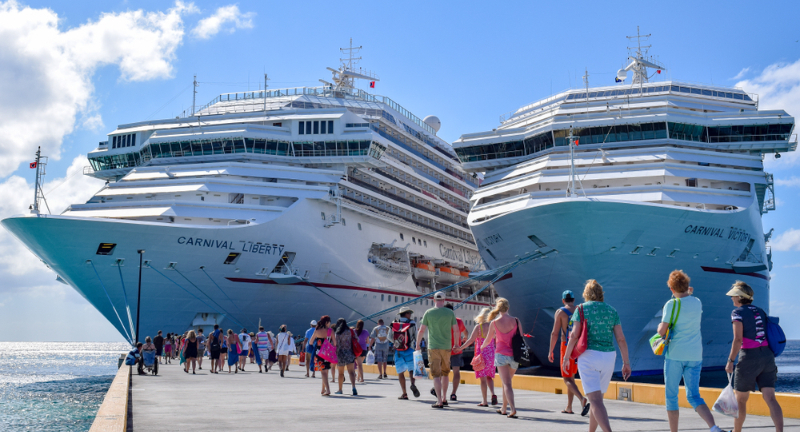
Ignoring Embarkation Times
Missing the ship’s departure time at any port can lead to being left behind. It’s crucial to keep track of time and return to the ship well before the scheduled departure. Cruise lines are strict with timings for logistical and safety reasons.
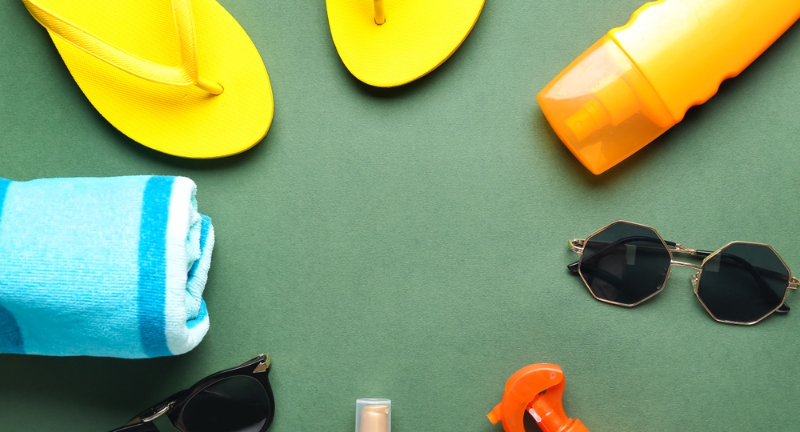
Forgetting Sun Protection
Cruises often involve long hours in the sun. Neglecting sun protection can lead to severe sunburns and increase the risk of skin cancer. Always use sunscreen, wear hats, and stay hydrated.
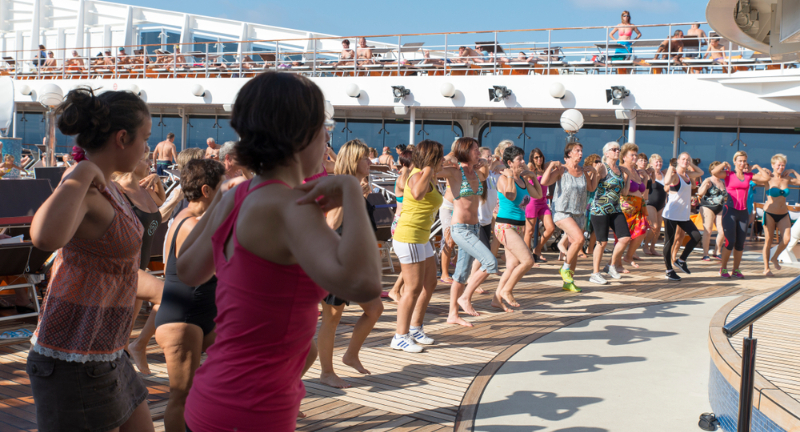
Wearing Inappropriate Footwear
Cruises often involve various activities that require proper footwear. Wearing high heels or flip-flops in areas like the pool deck or during excursions can be dangerous. Opt for comfortable, non-slip shoes suitable for the activity.

Disregarding Local Customs and Laws
When visiting different ports, it’s important to respect local customs and abide by local laws. Ignorance can lead to offensive behavior or legal troubles. Research and adhere to the cultural norms of each destination.

Ignoring Health Protocols
Health protocols, especially post-COVID-19, are crucial on cruises. Disregarding these measures can lead to the spread of illnesses onboard. Always follow the health guidelines provided by the cruise line.

Overeating at Buffets
Cruise buffets are tempting, but overeating can lead to discomfort and health issues. It’s better to enjoy meals in moderation and try different cuisines gradually. Remember, the buffet will be there throughout your cruise!
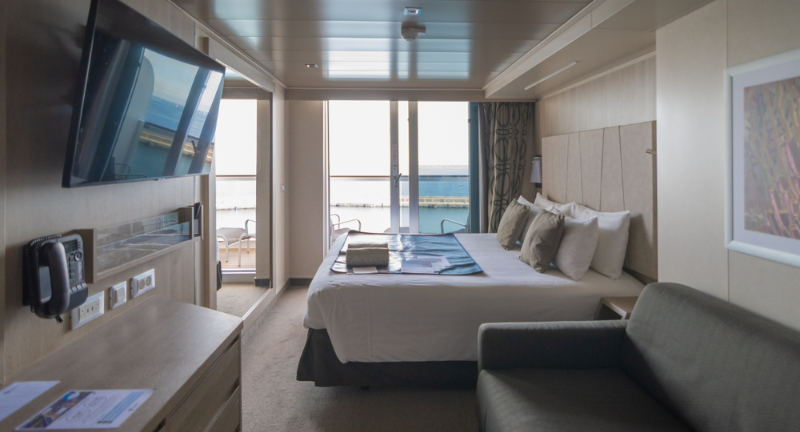
Leaving Valuables Unsecured
Leaving valuables like passports, jewelry, or electronics unsecured in your cabin can be risky. Use the safe provided in your room and only take essentials when leaving the cabin. Minimizing valuables on display reduces the risk of theft.

Not Checking Your Bill Regularly
Charges can quickly add up on a cruise. Regularly review your onboard account to avoid surprises at the end of the trip. This practice helps in tracking expenses and disputing any erroneous charges promptly.
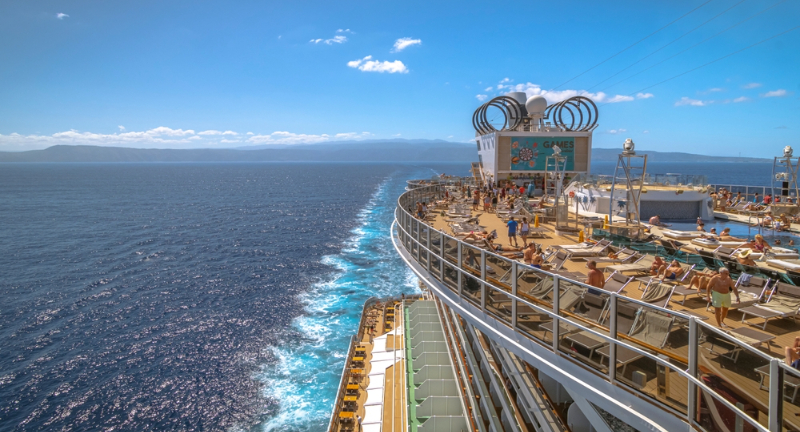
Engaging in Risky Behavior
Avoid risky behaviors such as climbing over railings or engaging in unauthorized areas. Such actions can lead to serious injuries or even falling overboard. Always stay within marked passenger areas and follow safety guidelines.
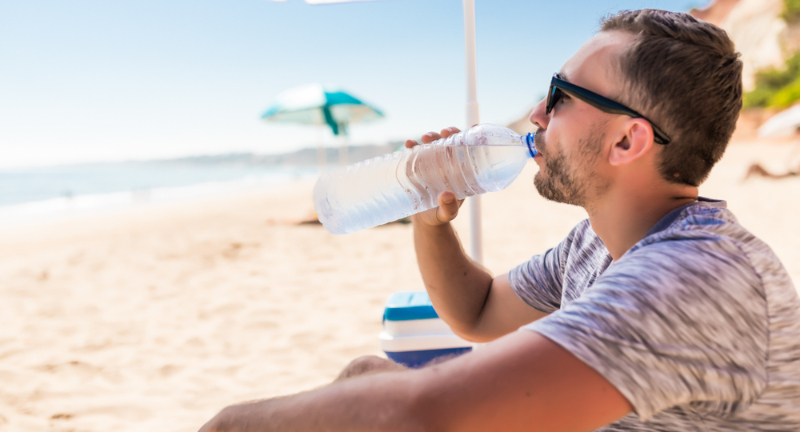
Neglecting Hydration
Staying hydrated is crucial, especially in warmer climates. Dehydration can lead to health issues and spoil your cruise experience. Drink plenty of water throughout the day.

Ignoring Time Zones
Cruises often cross different time zones. Ignoring these changes can result in missing activities or port departures. Keep your watch synchronized with the ship’s time, not the local time of the port.
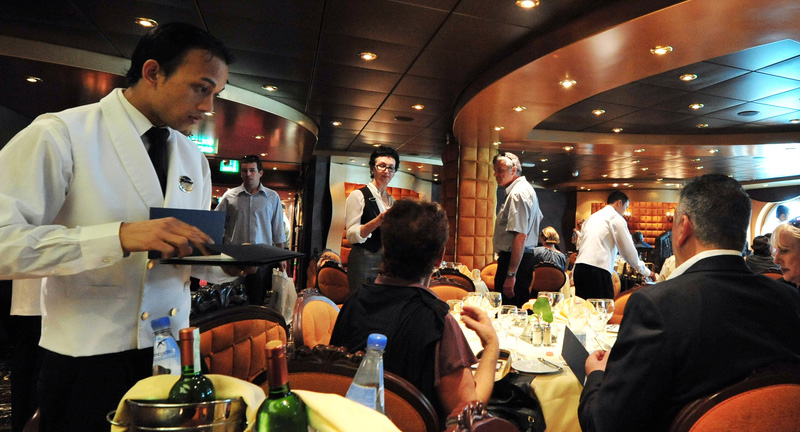
Disrespecting Other Passengers
Respect for fellow passengers is essential for a harmonious trip. Loud noises in cabins, cutting lines, or hogging deck chairs can create conflicts. Practice courtesy and be mindful of others’ space and comfort.

Not Reading the Daily Newsletter
Cruise lines provide daily newsletters with important information. Not reading them can lead to missing out on activities, changes in schedules, or essential announcements. Make it a habit to go through this newsletter every day.

Failing to Make Reservations
Popular onboard activities and excursions often require reservations. Not booking in advance can lead to missing out on these experiences. Always check if reservations are needed and book early.

Ignoring Seasickness Precautions
If you’re prone to seasickness, take necessary precautions. Ignoring this can lead to a miserable experience. Medications and natural remedies can be effective in managing seasickness.

Not Packing Appropriately
Cruises have varying dress codes for different occasions. Not packing the right clothes can lead to discomfort or being turned away from events. Research the cruise line’s dress code and pack accordingly.

Not Using Hand Sanitizer
Using hand sanitizer regularly can prevent the spread of germs. In the close quarters of a cruise ship, illnesses can spread quickly. Regular hand sanitizing, especially before meals, is a good practice.

Being Late for Dining Reservations
Timeliness is important for dining reservations. Being late can disrupt the service and affect other guests’ dining experience. Always arrive on time or notify the staff if you’re running late.

Not Using the Do Not Disturb Sign
The ‘Do Not Disturb’ sign is important for your privacy. Not using it can lead to awkward interruptions by housekeeping. Use it whenever you need privacy or are not ready for your room to be cleaned.
Throwing Anything Overboard
Disposing of anything overboard is not only harmful to the environment but also illegal. It can lead to pollution and harm marine life. Always use designated trash receptacles.
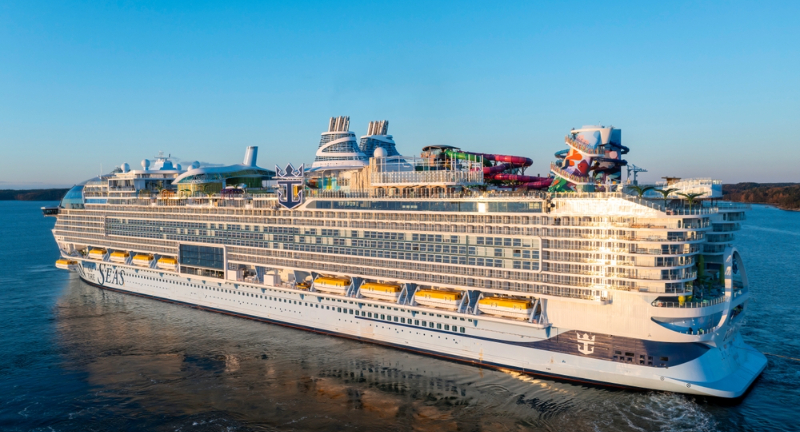
Not Exploring the Ship
Sticking to one area of the ship means missing out on what it has to offer. Take time to explore different amenities and activities. This exploration can enhance your overall experience.
Forgetting to Relax and Enjoy
Finally, it’s important to remember that a cruise is a vacation. Getting caught up in schedules and activities can lead to stress. Take time to relax, enjoy the scenery, and appreciate the experience.

A successful and memorable cruise experience hinges on not just the destinations you explore or the amenities offered on the ship, but also on how you approach your journey. By avoiding these 25 pitfalls, you ensure not only your own safety and enjoyment but also contribute to a pleasant atmosphere for fellow passengers and crew. Remember, a cruise is a chance to unwind, discover new horizons, and create lasting memories. So, step aboard with mindfulness and consideration, and you’re set for an incredible journey on the high seas!
What To Read Next
- This Genius Trick Every Online Shopper Should Know
- 12% High-Yield Savings Accounts
- Best Gold IRA To Invest In During 2024
- Best 2024 Cruise Deals For People Over 45
- Internet Deals For As Cheap As $10/Month
- Affordable Life Insurance Options for Seniors
For the Latest Travel News, Headlines & Videos, head to Bon Voyaged
More for You
Megan Fox Signs With UTA
Five teams that botched the 2024 NFL Draft
Here’s What the US Minimum Wage Was the Year You Were Born
30 food items that you might not know are banned in America
One of these pictures of me is real and the other is AI – but which is which?
Do I have to pay off my spouse's debts when they die? Here's what you're responsible for and what you aren't after a loved one's death
17 Phrases Older People Use That No One Else Gets
Sports Cars As Cool as the Porsche 911 But Way More Affordable
I'm abrosexual - it took me 30 years to realise
Common Foods That Are Illegal to Grow in Your Backyard
The most expensive state to live in isn't California or New York, based on data. Here are the top 10.
We Ordered 7 Fast-Food Breakfast Sandwiches to Find the Best One
'10-foot-tall people' discovered by archaeologists in Nevada cave
John Jacob Astor IV was one of the richest men in the world when he died on the Titanic. Here's a look at his life.
Team USA Issues Statement Regarding Caitlin Clark's Olympic Status
This is one of the most advanced humanoid robots in the world
The films everyone should see at least once before they die, according to critics
Average US annual salary by age revealed – see how you compare
Scientists have discovered the maximum age a human can live to
Should you leave your laptop plugged in all the time?

IMAGES
COMMENTS
Your symptoms may go away when you ride in a car or train, but they'll come back when you stop moving. And they can get worse with: Being in a closed-in space. Fast movement. Flickering lights ...
Advertisement. After a few months of therapy, most people feel better and the persistent motion sensation no longer bothers them. However, another cruise — or whatever activity triggered mal de ...
Luckily, cruise lovers have an array of options for seasickness prevention, from medicines and seasickness patches to Sea-Bands and even cabin-booking tricks that can alleviate motion sickness.
Understanding 'Sea Legs' as an Adaptation: The term "sea legs" refers to the body's adaptation to the motion of being on a boat, allowing people to maintain balance and stability at sea, while the reverse process, readjusting to land, can cause a feeling of swaying after disembarking.; Causes of Motion Sickness on Cruises: Motion sickness on cruises can arise from the constant movement of the ...
This is known as after cruise motion sickness or mal de debarquement syndrome (MDDS). MDDS is a rare condition that affects a small percentage of people who have been on a cruise. The symptoms of MDDS can include a persistent feeling of rocking or swaying, dizziness, nausea, and fatigue.
If seasickness has you hesitating to get on a cruise ship, look no further! I went ahead and tried out the most commonly recommended seasickness hacks to find the best one. Read more: 13 things I wish I'd done differently on my first cruise, from avoiding seasickness to eating at different venues. What is seasickness?
Many people suffer from sea sickness, but a small number continue to experience the symptoms of Mal de Debarquement Syndrome long after they've disembarked from a cruise ship. Since the syndrome ...
6. Seabands. A favorite cruise essential for many, seabands are wristbands that alleviate motion sickness symptoms. They work with acupressure buttons to prevent symptoms of seasickness and many cruisers have very good results. Seabands are natural and contain no medication, plus, they're reusable.
Mackenzie Pollock had a feeling she'd get seasick on her first cruise. The 29-year-old Oregon resident tends to get carsick, so when she felt nausea on a Caribbean sailing with Princess Cruises ...
Get plenty of fresh air. Eat, but light foods. Saltines, bread, pretzels. Ginger is also helpful. Heavy and greasy foods can enhance symptoms and risk. Wear an acupressure wristband. 3. Know which cabins are more likely to make you seasick. We've circled the sweet spot for cabins.
Try to slow your breathing down and make each inhale and exhale last as long as possible (don't hold your breath!); counting can help you control the timing. 2. Stay Hydrated. There are plenty of hydration apps around that remind you to drink water, and you may need this reminder when you're seasick.
"Considering the large size of today's cruise ships, seasickness is rarely a problem," says Dr. Benjamin Shore. ... chamomile and peppermint) or eating dry crackers, even after the onset, of seasickness can help." If a few sips of ginger ale or chewing fresh ginger doesn't do the trick, he also suggests going for a short walk to the ...
After all, nothing spoils the magic of seeing a whale breach or a sunset at sea like nausea or dizziness. Even the most experienced cruisers could fall prey to seasickness on a cruise ship, but this doesn't mean you should change your vacation plans. It simply means you should be prepared so nothing comes between you and a fantastic cruise.
September 3, 2023. When it comes to enjoying your vacation, nothing can change things faster than being seasick on your cruise. Meanwhile, it's said that motion sickness occurs in about 25% of people. So on a cruise with 4,000 passengers, 1,000 may be worried about not feeling their best. Unless you suffer from extreme motion sickness, it's ...
Lemon — Water with a lemon wedge or two will not only help, but it's refreshing. Olives — These little guys help reduce saliva, making it harder to get that pre-vomit salivation. Water. Nuts ...
The CDC also recommends staying hydrated, while limiting both alcoholic and caffeinated beverages. AFAR's senior travel news editor Michelle Baran, a fellow sufferer of seasickness, says the wristbands work for her to help avoid getting seasick on a cruise; she also chews mint-flavored gum to help ward off stomach problems when sailing.
Motion sickness is a possibility on a cruise ship, but don't assume you will experience it on your sailing. Most large ships are stabilized to prevent excessive motion, and the average cruise (especially to popular destinations in the Bahamas and the Caribbean) takes place in calm waters. Also, some people are more prone to seasickness than others.
1 - Pick the Itinerary Carefully - Avoid a Cruise With Many Sea Days. I rarely go on a cruise with more than two consecutive sea days, this isn't by accident. The more sea days you have, the more chance you have of getting seasick. This isn't just because you're actually spending more time at sea.
Remedies after a cruise. Typically, symptoms of land sickness last from a few hours to several days. Unlike sea sickness, land sickness doesn't respond to anti-nausea and motion-sickness medications, unfortunately. Instead, doctors recommend getting extra rest, taking long walks and staying hydrated.
Remedy one: Seasickness wristbands. These handy seasickness-tackling wristbands are perhaps the most creative solution to seasickness. Targeting your P6 point (which is located on your inner forearm just below your wrist), these bands put pressure on this point using a small plastic ball, which interrupts the nausea signals between your brain ...
Plain or bland-tasting food are best - avoid oily, salty, and spicy food to prevent further agitating your stomach. Most importantly, visit the ship's doctor for advice if your sickness gets ...
5. Eat the Right Food. Eating the right foods is one of the best ways to avoid seasickness on a cruise ship . Stay clear of heavy, greasy meals that can upset your stomach and make you more ...
Get fresh air. When you're feeling seasick, the fresh air of being outdoors can help ease the nausea and dizziness. Going up to a deck with an open view can be calming. It helps to feel the breeze on your face and be in nature. If possible, try to find a spot where you can lean on something that's secure. Focus on the horizon and try to relax.
Although it's somewhat rare, it's a form of reverse motion sickness that can last for months or even years after a cruise (or other triggering event). So far, anti-nausea medication and ginger ale ...
Check out my tips on how to prevent and avoid seasickness on a cruise. 6. Not Choosing a Cabin. When I first started cruising, I made the mistake of assuming that I couldn't choose my cabin ...
If you're prone to seasickness, take necessary precautions. Ignoring this can lead to a miserable experience. Medications and natural remedies can be effective in managing seasickness.